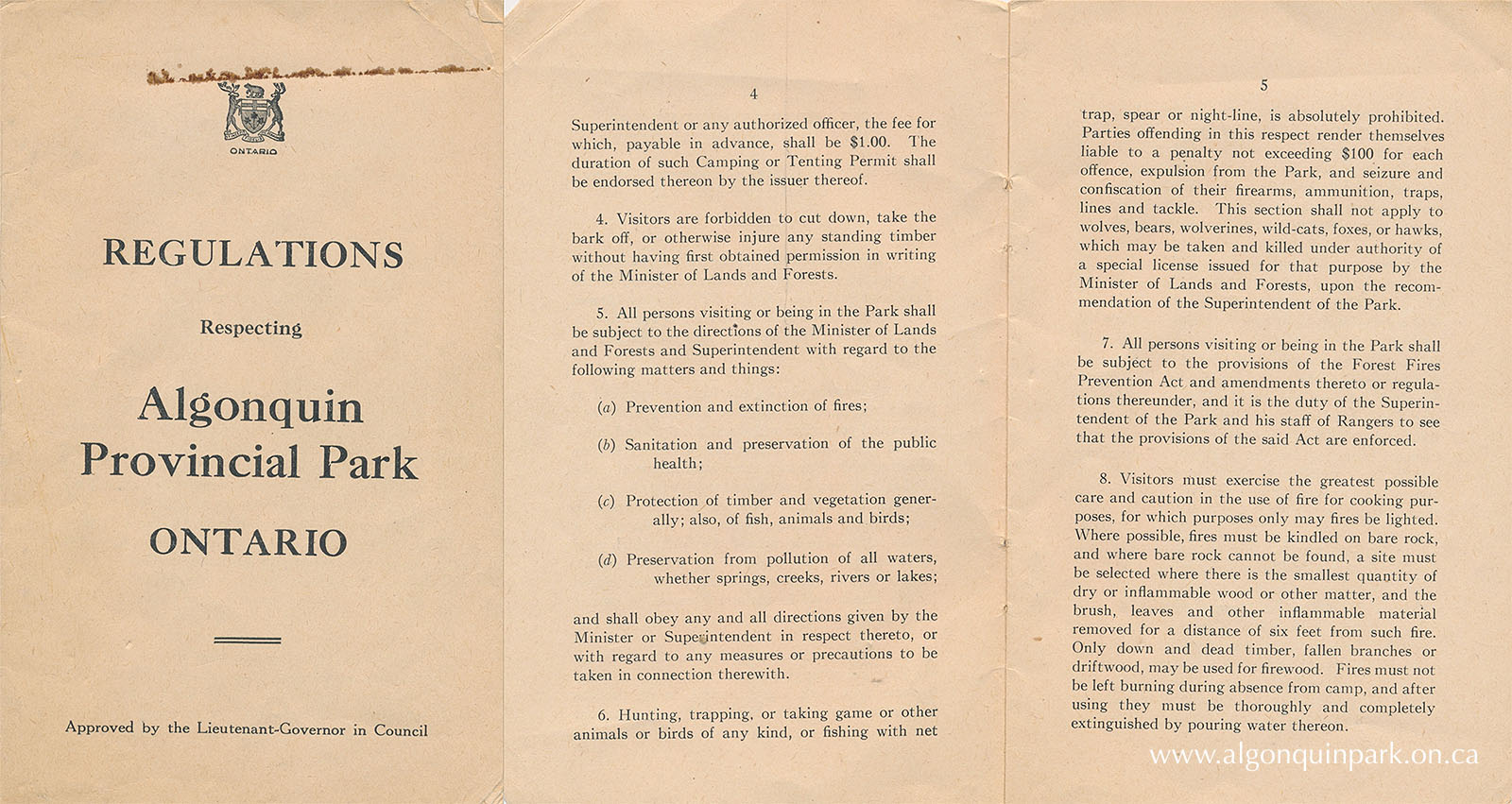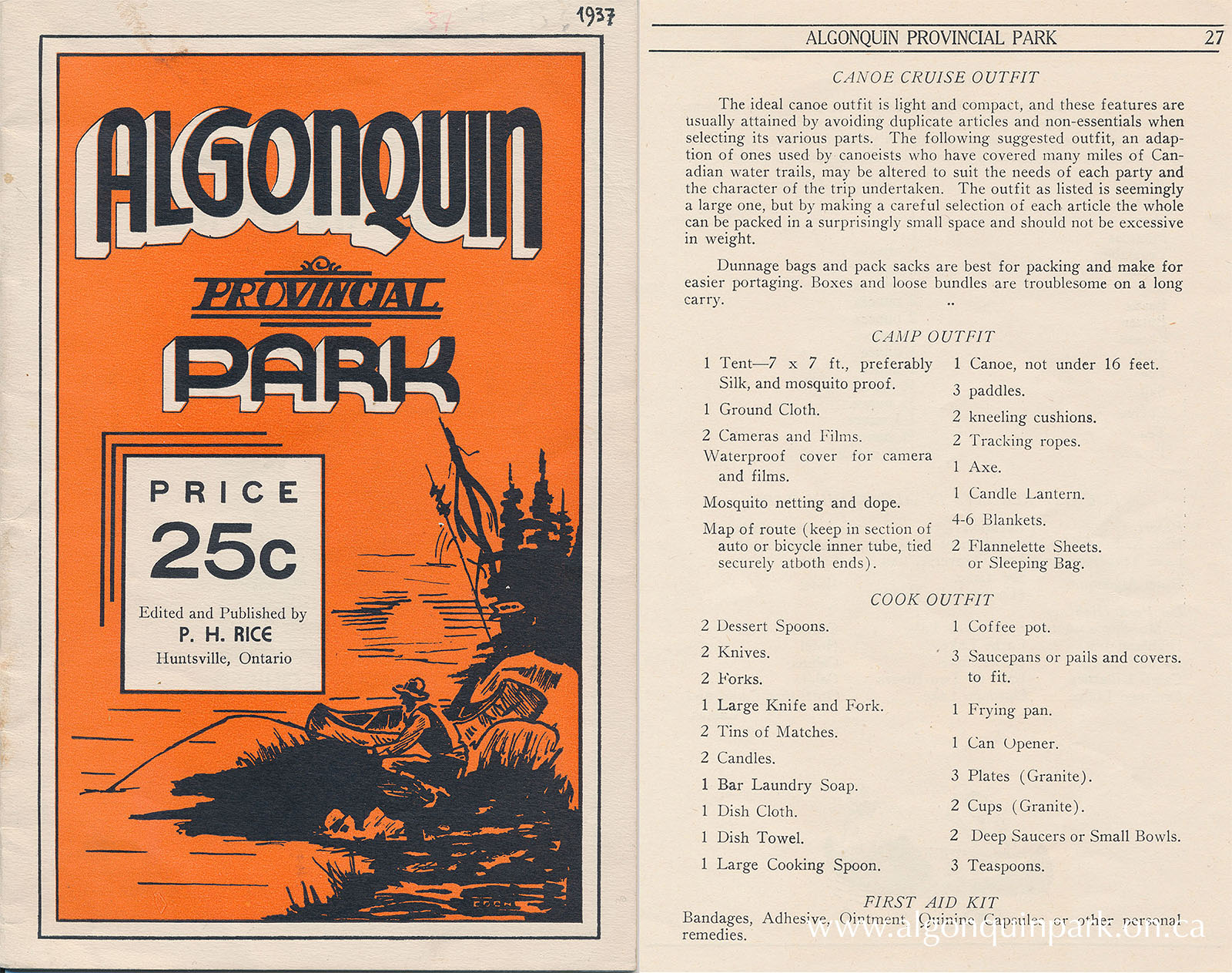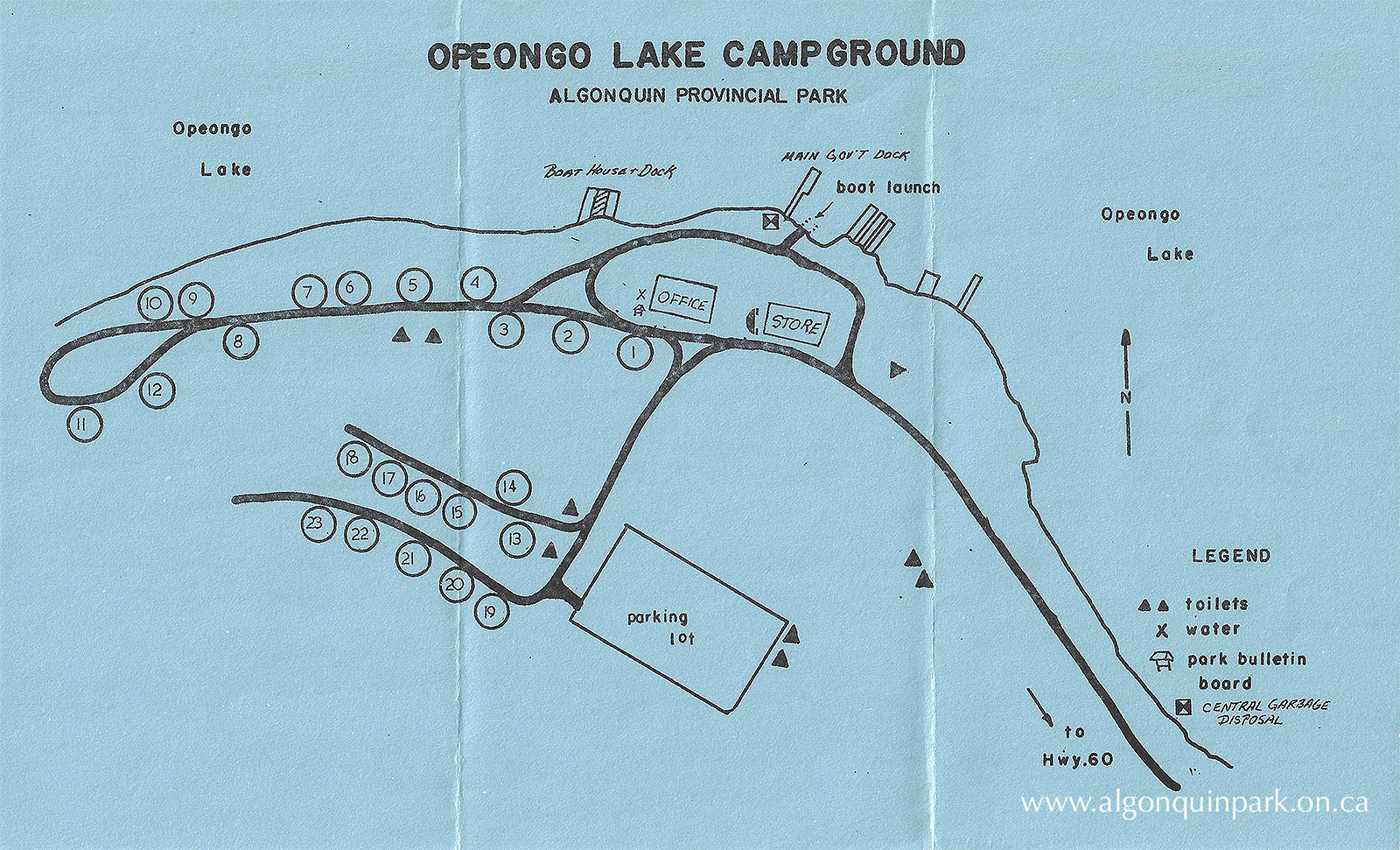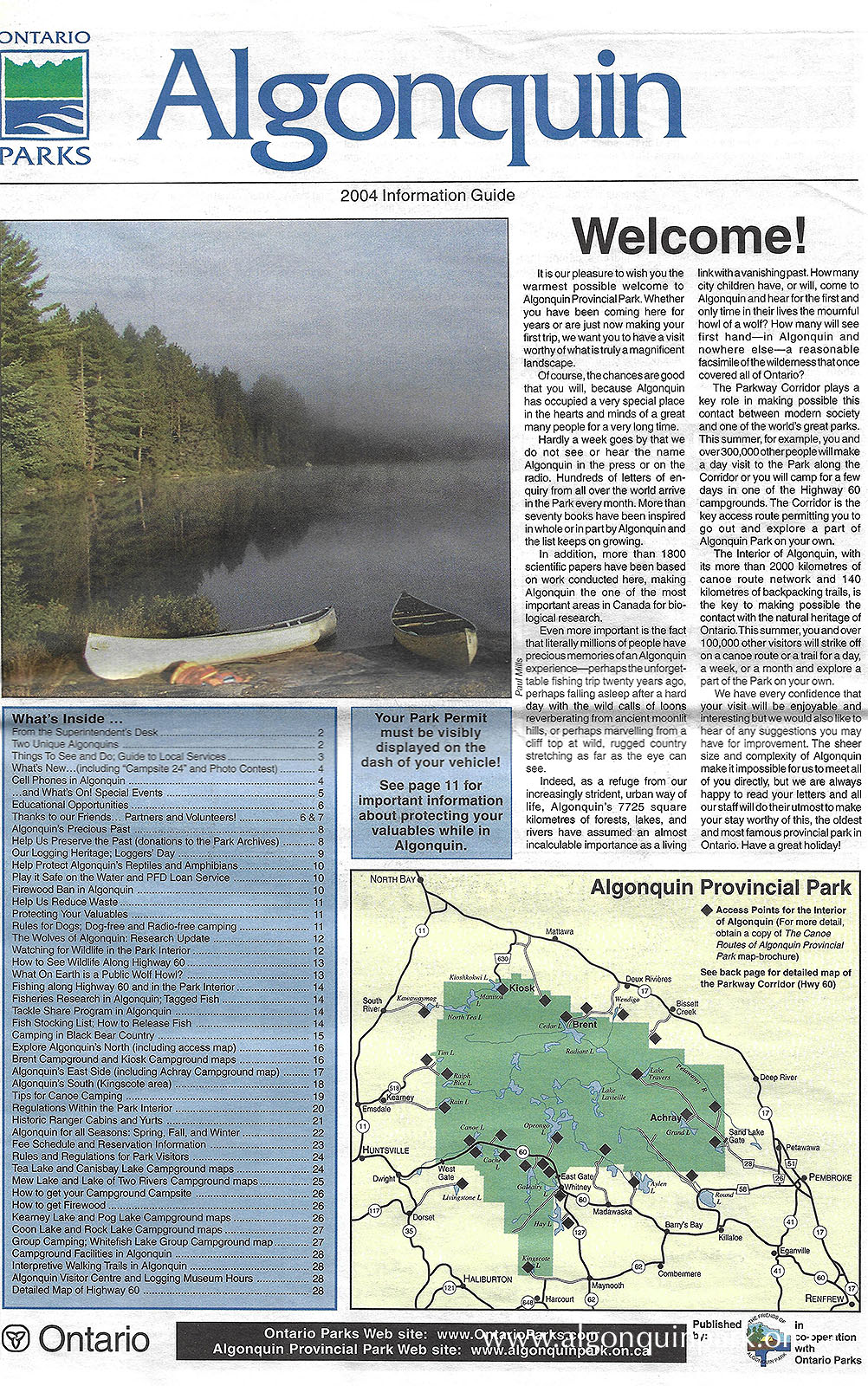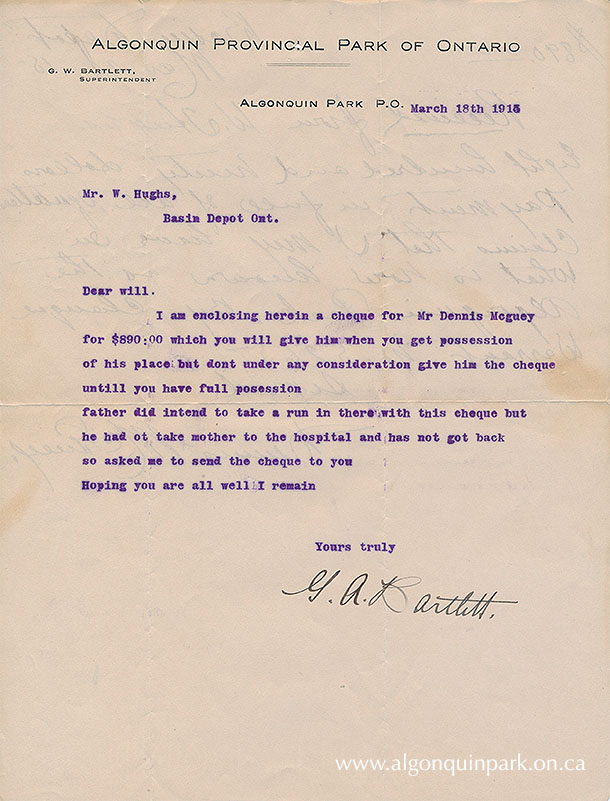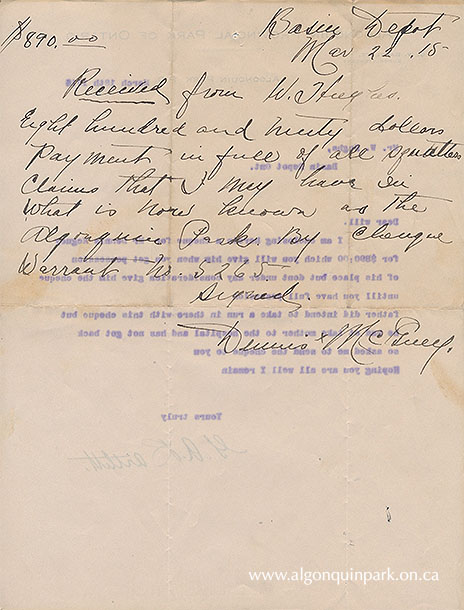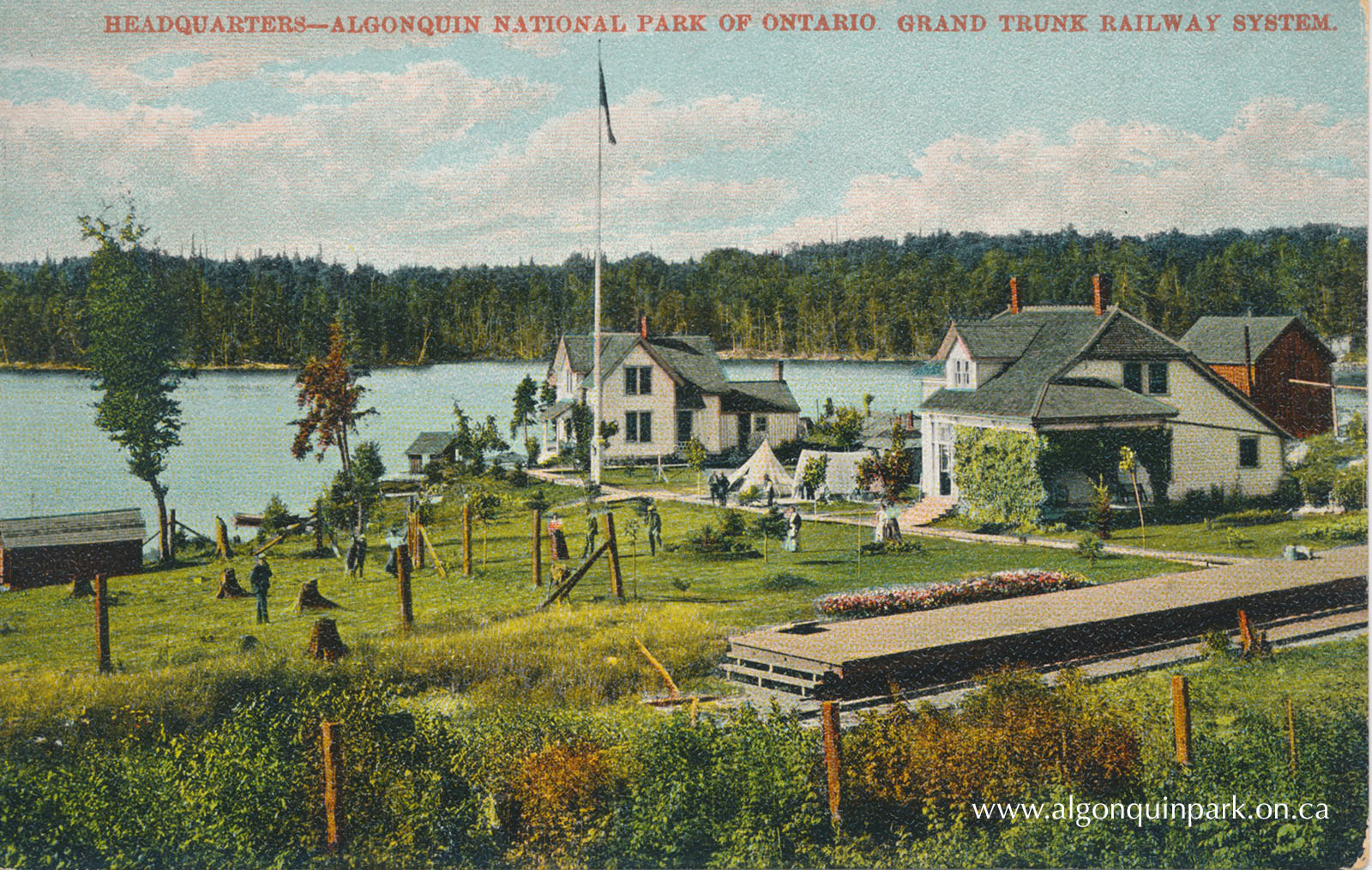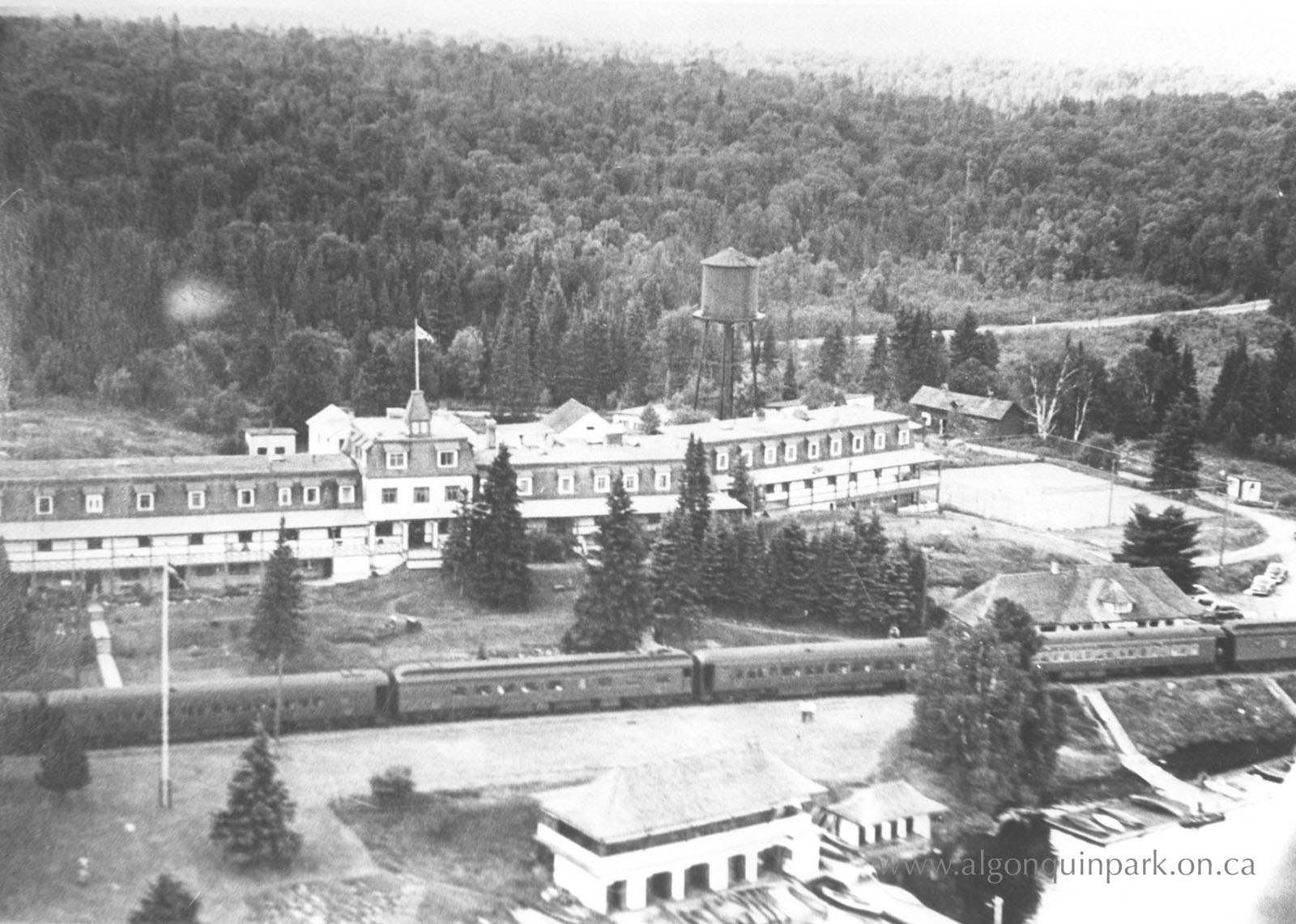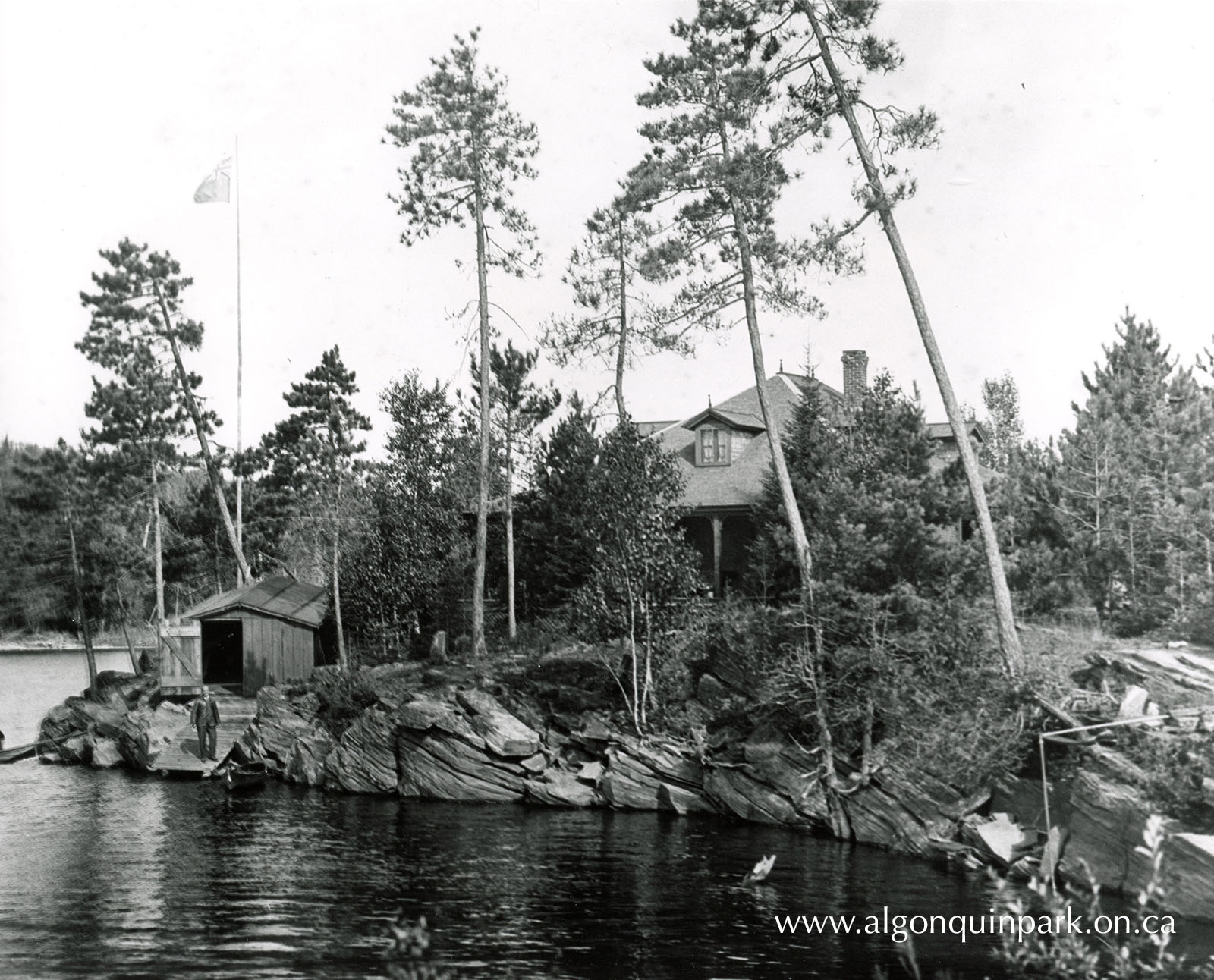Events Calendar
Current Weather
Algonquin Park Archives Blog
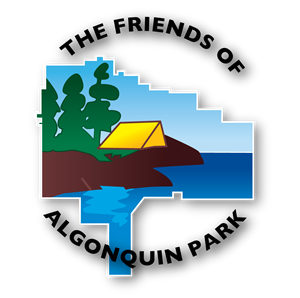 |
|||
The Algonquin Provincial Park Archives and Collections (APPAC or “Archives”) is the repository for artifacts of significance to the natural and cultural history of Algonquin Park and is owned by Government of Ontario, with substantial funding and operating assistance from The Friends of Algonquin Park, a registered Canadian charity.
The Archives is dedicated to the education, interpretation, and conservation of Algonquin Park’s heritage. Their mandate seeks to promote knowledge & awareness, spark curiosity, and inspire visitors to develop a deeper connection with the natural and cultural history that surrounds them.
More blogs posts are coming in the weeks ahead, check back again, or follow our social media for updates.
December 23, 2025
Seasons Greetings 
Dashing through the snow
In a one-horse open sleigh
O'er the fields we go
Laughing all the way
Bells on bobtails ring
Making spirits bright
What fun it is to ride and sing
A sleighing song tonight

Image: A sleighing party outside Canoe Lake Station, Christmas Day, 1913. Local residents and visitors from nearby communities have gathered to celebrate the holiday. APPAC, 1972.3.29, Thomas & Wilkinson Collection.
With the fresh snowfalls coating Algonquin Park’s trees, anticipation grows for quickly approaching festivities. Same holds true for the people who once called Algonquin Park their home. For them, Christmas was yet another time to enjoy the company of their tight-knit communities. Above we see a sleighing party gathered together at Canoe Lake Station. Members of the Thomas, Wilkinson, Worsley, and Benoit families of Canoe Lake, Joe Lake, and Kearney, ON were transported by J.S. “Shan” Fraser to Mowat Lodge for a sleigh ride and get-together. The image was captured Christmas Day, 1913.
Holiday traditions have long histories, and as such we often see them represented in the Algonquin Provincial Park Archives and Collections (APPAC; “Archives”). Many of us will remember the nervous feeling of performing a piece for the school concert. School children in Algonquin Park also performed Christmas concerts for their families, singing carols and reciting poetry. These concerts would take place at the small one-room schoolhouses, or other community gathering places. In her book “Joe Lake: Reminiscences of an Algonquin Park Ranger’s Daughter”, H. Eleanor (Mooney) Wright describes the Christmas concert as “the event of the season” at Joe Lake. Held in the wonderfully decorated rotunda of the Hotel Algonquin, participants sang carols, children recited poems, and adults put on a play.

 |
An Algonquin Park Memoir by Mary McCormick Pigeon |
Image: Cast members of "The Booneysville Uplift Society”, performed at the Christmas concert at the Hotel Algonquin, c. 1931-1932. Left to right: Ethel Mooney, Omer Stringer, Mrs. Budarick, Mabel Stringer, Molly Colson, Lila Stringer, Mary (Colson) Clare. APPAC, 1986.2.1, Mary Colson Clare.
Many traditions centre around food, whether it be traditional dishes, favourite baked goods, or seasonal sweets. Wright describes the sweet treats served after the play at Joe Lake. Santa would arrive with popcorn balls, homemade fudge, candied apples, and gifts for all the children. Refreshments were served for all who attended. In “An Algonquin Park Memoir”, Mary McCormick Pigeon recounts that in 1946 her schoolchildren and their parents were invited by the Department of Lands and Forests to a party at the staff house on Cache Lake where lunch was served.

Image: Holiday feasts were prepared throughout the small communities in Algonquin Park. This 1926 picture of Mary McCormick as a young girl living with her family at Brule illustrates the centrepiece to most traditional holiday meals. APPAC, 2022.12.103, McCormick and Pigeon Family.
With today’s technological advances, friends and family can send holiday messages by e-mail or messenger apps, but many still enjoy the thrill of receiving traditional cards. Cards can also be promotional items, reminding recipients of a business or person. In the Archives, one example comes from the history of the Park’s longest running youth camp, Camp Northway Lodge. First opened in Algonquin Park in 1908, the camp still welcomes girls today. Like many camps, Camp Northway communicated with campers, parents, and alumni during the off season. Their Christmas cards featured historical photographs from the camp’s past and artwork from their biography publication. Beyond representing interesting examples of marketing, the cards help researchers trace changes in ownership, history of the camp, and alumni events.

Image: Camp Northway Lodge Christmas card, c. 1950s – 1970s featuring a 1915 historical image from the camp. APPAC, 2016.18.171.1, Pollee Menoher Phipps Collection.
Inside and outside the home, decorations represent a key tradition for many families. Rose Thomas and Jack Wilkinson are well known in the Archives for their photography collection, capturing hundreds of images while living in Algonquin Park and working alongside (and after) Rose’s parents, Edwin and Emily. The collection contains a multitude of joy-filled images of the Christmas decorations and meals in their home at Kish-Kaduk Lodge on Cedar Lake. In addition to their own real Christmas tree, they decorated trees outside, often captured in images with their wild friends. Although their decorating traditions remain similar from year to year, we can tell the holiday images span many seasons by the changing position of the tree or new decorations appearing on the ceiling. But of course, the gifts underneath the tree vary from one year to the next too.

Images: Christmas memories from Kish-Kaduk Lodge, Cedar Lake, c. 1950s – 1970s. Top to bottom, left to right: Edwin Thomas, Rose Thomas, Jack Wilkinson, Emily Thomas; a raccoon under a decorated tree; Christmas decorations; Jack Wilkinson and Rose Thomas wearing festive hats at a holiday meal; a deer lying down beside a decorated tree; a cat lounges by the fireplace surrounded by Christmas decorations. APPAC, 1972.3.235.11; 1972.3.110.118; 1972.3.110.109; 1972.3.110.113; 1972.3.143; 1972.3.111.102, Thomas and Wilkinson Collection.
 |
Make a charitable donation to assist us in protecting Algonquin Park's cultural heritage for future generations. |
We can also trace time by the appearances of individuals as they age, or the absence of family members as they pass on. At the core of our traditions are the people we share them with and the memories we create. In Superintendent George Bartlett’s 1914 correspondence to Ranger William Hughes, he wishes Hughes and his family good health and best wishes for Christmas and the New Year. Bartlett comments that he expects he and Mrs. Bartlett will remain at Cache Lake over the holidays as “she is not well enough to go anywhere and I don’t expect any of our people can come.” (APPAC, 2020.20.10, Estate of Janet Ivel (Hughes) Gurr). Quotes like these remind us to treasure our relationships and the special memories we make during the holidays as we connect in our own unique and treasured ways.
All the best to you and yours in 2026!
Learn More
Learn more about the Algonquin Provincial Park Archives & Collections
- Explore the online database of photographs, archival records, and artifacts.
- Contact the Collections Coordinator to schedule a research appointment or discuss a donation.
- Read more by purchasing historical publications in The Friends of Algonquin Park’s bookstore.
- Support the Archives with a financial donation via The Friends of Algonquin Park, a Canadian registered charity, to assist us in preserving Algonquin Park's cultural heritage for future generations.
December 17, 2025
A Hike Down Memory Lane
 On June 28, 2025, The Friends of Algonquin Park opened the newest interpretive hiking trail in Algonquin Park. Located at the Algonquin Park Visitor Centre, the Fork Lake Trail is a 2.4 kilometre loop that offers short, steep climbs from lake level to high hilltops with scenic views.
On June 28, 2025, The Friends of Algonquin Park opened the newest interpretive hiking trail in Algonquin Park. Located at the Algonquin Park Visitor Centre, the Fork Lake Trail is a 2.4 kilometre loop that offers short, steep climbs from lake level to high hilltops with scenic views.
The event motivated the Algonquin Provincial Park Archives and Collections (APPAC; “Archives”) to take a stroll (or hike) down memory lane to explore the history of the Park’s trail system. There are many types of trails in Algonquin Park, from dog sled and cross-country skiing to portages and backpacking trails, but this post will focus solely on the history of interpretive trails, namely those designed to be self-guided.

Image: Entrance to the Fork Lake Trail at the Algonquin Visitor Centre, June 2025.
Interpretive trails were originally known as nature trails, and we can trace the very first all the way back to October 1938. This trail was the portage from Cache Lake to Canisbay Lake and was “set-out” by Park Ranger Dr. Duncan MacLulich. MacLulich was a biologist by training, and the Park Superintendent at the time, Frank MacDougall, wanted to have a dedicated biologist on staff, but the position did not exist. Instead, MacLulich was hired as a Ranger and encouraged to complete scientific studies on the side. The Archives also considers him to be the first Park Naturalist on staff through his role with the Canisbay Nature Trail.
MacLulich placed nature signs on trees along the portage. The signs were blocks of wood about six inches long, two inches high, and one inch thick (15.24x 5.08 x 2.54 cm). They had a bevelled edge and were painted yellow with black letters on them. The signs simply identified the name of the tree to those passing by. MacLulich also planned a nature trail for the Tanamakoon Trail, but the war intervened and his time in the role ended in September 1939.
When Algonquin Park’s Naturalist Programme and first museum began in the early 1940s, so too does the re-emergence of the nature trail system. In 1946, 41 new signs identifying plants and trees were added to the Canisbay Nature Trail, and the entrance to the trail was marked at the highway. A year later, 47 labels were prepared at the request of the proprietor of Whitefish Lodge, Mr. J. Connolly, who wished to brush out a trail that fall. Heavily used portages in the Park were also labelled: Smoke Lake/Canoe Lake; Burnt Island Lake/Jay Lake, and Burnt Island Lake/Little Otterslides Lake.

Image: Map of part of Algonquin Provincial Park along Highway 60, from the “Nature Program” booklet, c. 1949 – 1952. The booklet describes the trails to visitors: “The entrances to the nature trails are marked along the highway. Here the visitor will find the trees and plants labelled as well as other interesting items of natural history. Please do not pick or destroy the plants along the trail and do not litter the woods with lunch papers, cigarette packages, etc. … Leave the trails so that others also may enjoy them.” APPAC, 2023.23.1.
In the 1950s we see continued growth and definition of the nature trail system. Four trails are maintained, namely Deer Lake, Canisbay, Two Rivers, and Lookout. For today’s frequent Algonquin Park visitors, most of these names will be familiar except perhaps for Deer Lake. This trail began on Highway 60 at picnic grounds near Smoke Lake and travelled south to a portion of the lake known as Deer Bay. Nature Trail signs continue to identify plants, shrubs, trees, and other points of interest. Registration books were placed in boxes on each trail, and hikers were encouraged to sign the booklets. The data was helpful to Park Staff in tracking visitation numbers, although in later years they faced much trouble in people stealing the books.

Image: Hikers signing a trail register book on a nature trail, 1953. Spot the signs in the trees. APPAC, APM 874.
Park Naturalists experimented for many years in finding the right methodology for crafting their signs. At first 5” x 9” (12.7 x 22.86 cm) Masonite boards were used and painted on one surface with chrome yellow paint. When dried, black enamel lettering was applied. The quickest way to letter was to apply ink onto a stencil with a spray gun. Once dry, the sign was varnished, with special care taken to shellac and varnish the edges to protect against the weather. Later, a special typewriter with Royal 6 Gothic type was used to print the text on a transfer which was then slipped off, after being moistened. The text was applied to a 7” x 9” (17.78 x 22.86 cm) piece of plywood which was varnished or painted beforehand. Once applied, the label was sprayed with clear plastic.

Image: Nature trail sign for “Ground Pine”, 6” x 9”, Masonite painted yellow and stenciled with black, c. 1940s – 1950s. The sign identifies the Latin name “Lycopodium obscurum” and a short phrase “one of the club-mosses.” to hikers passing by. APPAC.
Park Naturalists weighed the pros and cons of their methods and hoped to continue to find the best sign which would hold up to the elements on the trails. In the following years they would try applying the text to thin sheets of galvanized metal, only to find that vandals could easily bend the signs in half. The best compromise was to attach the metal sign, which held up well to the weather, to a piece of plywood, which could not be easily vandalized.

Image: Ontario Department of Lands and Forests nature trail sign, 7” x 9”, metal on plywood backing, c. late 1950s – 1960s. This sign is for “Yellow Birch” and explained to visitors: “The bark is smooth and yellowish except on large trees where it breaks up into large brownish plates. The hard strong wood takes a high polish and is valuable for veneer furniture and flooring. The tree is a favourite food of deer which may be the reason for the scarcity of birch seedlings in this area.” APPAC.
The nature trail system continued to grow and fluctuate from year to year in the 1950s and 1960s. In 1956, Deer Lake Trail was closed for the season, due to wetness experienced the previous year. A new trail into Pinetree Lake, on the east side of Algonquin Park, was built and finally opened on August 1, 1956. With only one staff vehicle for the Naturalist Programme, maintenance and construction were difficult due to the distance from the Park Museum, located at Found Lake, and just before Labour Day a forest fire was started by a trail-user. The year-end report explains, “Because of this fire, it has been suggested that the Nature Trails be kept in Peck and Canisbay Townships, where travel permits are not required. This restriction should not be necessary, as the fire could just as easily have been started on Canisbay Lake as any other place. Within a few years attractions will quite definitely be needed at the east end of the Park.” Pinetree Lake Nature Trail was closed, but this prediction for the east side of Algonquin Park would ring true, but after more than a “few years”.
This era of change and experimentation continues in 1958 with the opening of yet another new trail, this time leading to Jack Lake. Today’s Park visitors would know this location as the Hemlock Bluff Trail. Trail names were changed in the 1960s to better represent the features hikers could expect to visit on the trail. Jack Lake became Hemlock Bluff, Deer Lake became Hardwood Hill, and the newly constructed Hains Lookout trail became Hardwood Lookout. In 1959, Park visitors also experienced a change in the location of Lookout Trail when it switched from the north side of Highway 60 to the south to allow the north trail to recover and to give staff time to clear vandalism from the rocks.

Image: Left – Entrance to the Hemlock Bluff Nature Trail with cars parked along Highway 60, 1961. APPAC, APM 873. Right – The Hardwood Nature Trail Sign in Algonquin Park’s artifact collection. APPAC, 2024.26.1. In 1961, a new standardized style of highway signs for nature trails was launched across all Provincial Parks in Ontario. Algonquin Park Naturalist Programme’s year-end report of the year stated they were “very eye-catching, and have evoked many favourable comments”.
With the creation of Booth’s Rock Trail in 1967, Algonquin Park begins its trail guide tradition. The Naturalist Programme year-end report explains: “This trail starts on the old railway at the easterly end of the Baulke Campsite and describes a four mile long loop passing the Rosepond, Gordon Lake, Booth’s Rock, Barclay Estate, and returns to the starting point along the railway. The trail was brushed out and marked with yellow can lids. Numbered posts were set in the ground at points to be interpreted in the new trail guide leaflet. The final draft of the trail guide leaflet will be approved this winter and will be available for use when the trail is opened in spring of 1968”. The trail was officially announced in the June 26, 1968, "The Raven" with subsequent "The Raven" articles throughout the summer tracking the progress of the trail guide. At first, trail users would be supplied with a folder containing corresponding numbers and printed discussion of interesting trail features. In July, the first edition of the trail guide was released, but naturalist staff made sure to explain it was rushed production and welcomed suggestions from trail users. This system of carrying a booklet around the trail must have seemed quite strange to hikers familiar with the signs they would normally encounter.
Image: Cover of Algonquin Park’s first trail guide, created in 1968 for the newly constructed Booth’s Rock Trail. APPAC, M-7-2b.
The trail guides allowed staff to provide much more interpretive content than the old system of signs and provided the key to the new trail system which emerged in the 1970s. Each trail would have a dedicated trail guide and explore a specific habitat or topic to create a systematic and thematic exploration of the Algonquin environment. With the need for only one deciduous forest trail, Hardwood Hill (formerly Deer Lake) was closed, with a new trail laid out at Hardwood Lookout overlooking Smoke Lake. Four trails are added to the existing system, namely Spruce Bog Boardwalk, Beaver Pond, Peck Lake, and Whiskey Rapids, to create “the nine” interpretive trails. One exception is the Barron Canyon trail which first appears in reports in 1972. Located outside of the Highway 60 corridor, it is not considered part of the “nine”. At first it has a small Gestenered trail leaflet but does receive its dedicated trail guide in the new system until 1987.
In 1972, a combination trailhead sign and trail guide dispenser was designed and seven were being constructed over the winter. They would be put into operation as the various trail guides became available. Trail users could use the guide and return it when they were done, for free, or buy the guide for 10 cents. The following year, the first trail guide dispensers were used at Beaver Pond, Lookout, and Hardwood Lookout Trails. The honour system resulted in a small absolute loss of $135.96 or less than 0.25% per registered trail user (60,000 trail users), and the system was considered a success.

Image: By 1976, “the nine” trails of the new interpretive system have dedicated trail guides available to users at special trailhead dispensing signs. Text by Dan Strickland and illustrations by Howard Coneybeare. APPAC, M-7-1a; 1g; 1p; 2d; 2h; 2m; 3b; 3m; 3v.
In the 1980s, the trail system once again began to grow. Mizzy Lake (1982-83); Brent Crater (1987); Track and Tower (1989-90); Bat Lake (1989-90); Berm Lake (1992-93); Algonquin Logging Museum (1992); Centennial Ridges (1993) and Big Pines (2001) rounded out the system trail users enjoyed.
Twenty-four years later, the latest in the series of interpretive walking trails, the Fork Lake Trail was opened to the public on June 28, 2025. As a celebration of Algonquin’s habitats, its path takes hikers to spruce bogs, lakes & rivers, deciduous forests, coniferous forests, and beaver ponds. The trail guide (forthcoming!) encourages visitors to explore the many trails in Algonquin Park and will soon join the collections on bookshelves of dedicated Park hikers worldwide. Like many other trails built since The Friends of Algonquin Park’s establishment in 1983, this trail is a gift from The Friends on behalf of its generous donors and in collaboration with many partners. Stepping foot on this trail and the many others across Algonquin Park lets you join a long history of hikers who have learned from and enjoyed the interpretive trail system.

Image: Camp Northway campers at the top of Skymount overlooking Cache Lake, 1918. Early visitors to Cache Lake would climb the hill from the shore of Cache Lake to the rocky outcrop where the fire tower once stood. Later, one could follow the route along the railroad tracks from Algonquin Park Station. Today, Algonquin Park visitors reach the same lookout but by a different route, that of the Track and Tower Trail. APPAC, 2001.7.37.
Learn More
Learn more about the Algonquin Provincial Park Archives & Collections
- Explore the online database of photographs, archival records, and artifacts.
- Contact the Collections Coordinator to schedule a research appointment or discuss a donation.
- Read more by purchasing historical publications in The Friends of Algonquin Park’s bookstore.
- Support the Archives with a financial donation via The Friends of Algonquin Park, a Canadian registered charity, to assist us in preserving Algonquin Park's cultural heritage for future generations.
December 8, 2025
Algonquin Park Legacy: J.R. Booth
 One hundred years ago, on December 8, 1925, John Rudolphus Booth passed away at the age of 98 years old in his home in Ottawa, Ontario. He was one of the richest and most influential men in Canada, but at his request, he was buried in a humble ceremony, without an elaborate church service or even funeral music. Despite this, thousands visited Booth’s casket to pay their respects during visitation at his home. Although the family requested no flowers be brought to the simple service, the room was filled with them. Hundreds gathered on the streets to observe his casket being placed in the hearse and walked with him on the journey to his final resting place.
One hundred years ago, on December 8, 1925, John Rudolphus Booth passed away at the age of 98 years old in his home in Ottawa, Ontario. He was one of the richest and most influential men in Canada, but at his request, he was buried in a humble ceremony, without an elaborate church service or even funeral music. Despite this, thousands visited Booth’s casket to pay their respects during visitation at his home. Although the family requested no flowers be brought to the simple service, the room was filled with them. Hundreds gathered on the streets to observe his casket being placed in the hearse and walked with him on the journey to his final resting place.

Image: Portrait of John Rudolphus (J.R.) Booth, 1904. William James Topley, Library and Archives Canada, PA-012219.
Who was J.R. Booth? How did he have such an immense impact on those around him? Why is his life jointly tied with the history of Algonquin Park?
On the anniversary of his death, the Algonquin Provincial Park Archives and Collections(APPAC; “Archives”) will look at his influence on the Park, and how a simple carpenter became one of Canada’s most famous lumber magnates.
This article relies heavily on the research and work of author Rory MacKay who has recently released a second edition of his book, “J.R. Booth: Lumberman, Railway Builder, Industrialist, Great Canadian, and Influence of Algonquin Provincial Park”. To learn more about the life, personality, and impact of this Canadian on those around him, explore a copy of this beautiful book!
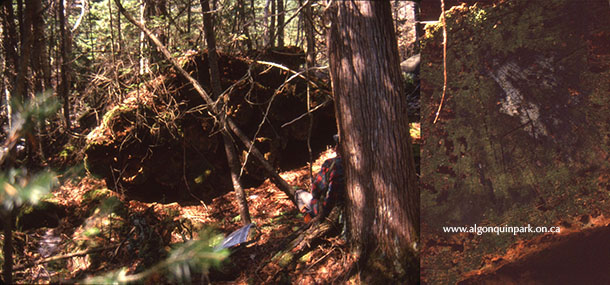
Image: Keen eyed observers travelling through Algonquin Park’s backcountry may discover remnants of the influences of J.R. Booth. This pile of logs, abandoned for unknown reasons in Paxton Township, bears one of the many registered timber marks for the J.R. Booth Lumber Company. But who was J.R. Booth? APPAC, x2025.26.1-4.
Born near Waterloo, Quebec, on April 5, 1827, J.R. Booth was raised with a simple upbringing, not unlike most farm children of Upper and Lower Canada at the time. His earliest work experiences took him away from the family farm, exploring the United States of America as a carpenter’s helper in New York State, joining the gold rush in California, and building railway bridges for the Central Vermont Railroad. Disappointed at his lack of progress in building his fortune, Booth returned to Canada, marrying Rosalinda Cook a short time later, on January 7, 1853. With the added pressure of starting a family, Booth continued to dream of growing his reputation and pushing himself to accomplish the most he could in life.

Image: Portrait of J.R. Booth and wife Rosalinda (Cook) Booth with their children: Ellen, Lila, Charles, and John. September 1871. William James Topley, Library and Archives Canada, PA-033271.
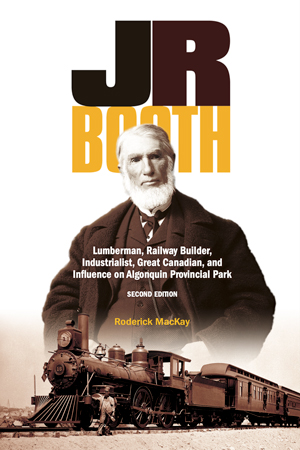 |
Booth, his wife, and new daughter would move to Ottawa, Ontario. As the story goes, Booth only had nine dollars in his pocket. Although equivalent to much more in today’s currency, this was still only a small amount in the early 1850s. Booth began slowly, employed as a carpenter building sawmills. In the evening, he and his wife would split roof shingles, by hand, to supplement his income. After working as manager of a sawmill, Booth operated his own machine shop and then a shingle-making factory before securing a ten-year lease on a sawmill on the Chaudière Falls.
His first big break came in 1859 when he secured the bid to supply lumber for the construction of the Parliament buildings in Ottawa. Although the original Parliament buildings burned in the great fire of 1916, a portion of J.R. Booth’s lumber is still present in the Parliamentary Library, which was saved by quick thinking staff who closed the iron doors. With his recent successes, Booth was able to purchase the sawmill he had been previously leasing. He bought a neighbouring mill and proceeded to build another. It was clear that Booth would require an even larger supply of wood for his sawmill operations.
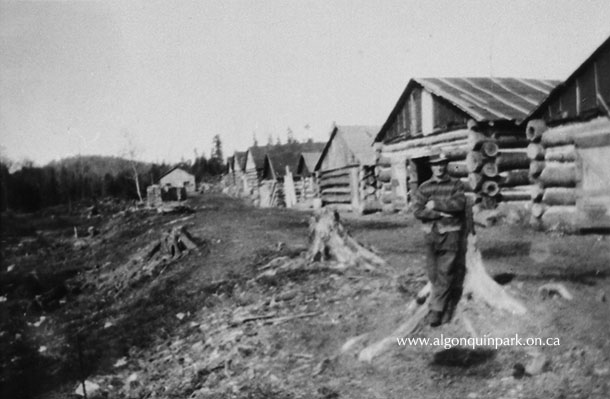
Image: Man leaning against a stump in front of several buildings at the J.R. Booth Lumber camp at the north end of Shirley Lake, Algonquin Park, 1925. APPAC, 1976.74.3, Max Borutski.
Booth bid on and secured numerous timber limits across the Ottawa Valley and Algonquin Park, perhaps none more important than the Egan Estate timber limit on the Madawaska River. The financial gamble, called fool-hardy by many fellow lumbermen, paid off when the limits provided 150,000 to 300,000 sawlogs each season, from 1867 to 1906.
Like the numerous logging companies across Algonquin Park and Ontario, Booth hired lumbermen to work in the logging camps on his timber limits. Perhaps the main difference is that with the size of his lumber empire, Booth as an employer impacted a far greater number of lives. Each fall, thousands of men of all ages would leave their families and travel into the forests to cut, prep, and pile logs for J.R. Booth. Many came from farming families who needed the winter income to supplement their meager crops in the summer season. The men would earn $1 a day, with room and board included for their stay in the camps. The result of their work would be thousands of logs piled high along the frozen banks of lakes and rivers, awaiting the spring breakup when select crews of men would stay on to complete the river drive to Booth’s Ottawa sawmills.

Image: Men working with a log jam on a J.R. Booth river drive. The image is thought to have been captured before 1900 on the Madawaska River. APPAC, 2023.13.1, From the Collection of Barry Donald Pretty.
 |
Make a charitable donation to assist us in protecting Algonquin Park's cultural heritage for future generations. |
Always looking to expand and grow his operations, Booth was restricted by the seasonal hindrances. The only way to transport logs from his timber limits to his mills in Ottawa, and likewise lumber from his mills to the markets, was by the waterways. But, in this northern climate, water is only an ideal transportation method when it is open. The seasonal freeze-up severely hindered his business plan. If only there was a way to transport wood 365 days of the year.
The 19th century was a time of great excitement and popularity for railroad operations, and it is no surprise that an entrepreneur such as Booth would miss such an opportunity for expansion. Alongside business partner and fellow lumbermen, William G. Perley, Booth would invest and build the Canadian Atlantic Railway, connecting Ottawa to the Central Vermont Railway and the seaports of the Eastern Seaboard. But why stop there?
As early as 1883, ten years before the formation of Algonquin Park, Booth set eyes on the creation of a railroad that would connect Ottawa westwards, running through or near many of his timber limits. Of course, some logs would still have to be transported by river drives, and the railway would not be profitable on timber shipments alone, so Booth considered shipping grain from the Prairies as well.
In 1891, surveying began for the proposed railway, and the first trains travelled the completed Ottawa, Arnprior and Parry Sound Railway in 1896. A railway line through Algonquin Park was not advised by the Royal Commission who were directed to report on the formation of such a park and nature reserve, but they did advocate for lumbermen to have continued access to their limits. The rail line would also prove very important to Park Rangers travelling on patrol and for the shipment of supplies. J.R. Booth and fellow lumbermen also played a major role in supporting the formation of Algonquin Park as a forest reserve which would include the suppression of forest fires, thus protecting the trees that were the source of their revenue.
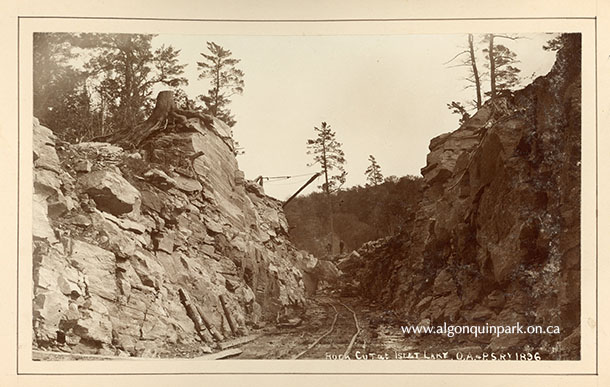
Image: Men working on blasting and clearing a rock cut at Islet Lake, 1896, during construction of the Ottawa, Arnprior and Parry Sound Railway. APPAC, 1976.86.1-54, Photographed by John Walter Le Breton Ross.
Unbeknownst to Booth, the railroad he created would have a much larger impact on the trajectory of Algonquin Park. Before access by train, the only visitors to Algonquin Park could arrive by bumpy wagon rides or canoe trips. In 1899, the Ottawa, Arnprior and Parry Sound Railway was amalgamated with the Canada Atlantic Railway and was eventually sold to the Grand Trunk Railway in 1905. This sale would lead to a large boost in the tourism and reach of Algonquin Park. Advertised in railway brochures and magazines, Algonquin Park would become a destination for Canadian and international travellers, particularly Americans, seeking the angler’s paradise. Grand Trunk Railway, and later the Canadian National Railway, would operate hotels, such as the Highland Inn, and promote the Park as a destination for rest, relaxation, and recreation, all to boost sales on its passenger trains.
Along the rail line, other lumber companies developed mills and communities grew around them as well as the railroad stations. Families worked and lived in tight-knit communities, raising their families in Algonquin Park. When thoroughfare on the rail line was condemned in the 1930s, the previously discussed construction of a highway was finally undertaken as a depression relief project. Highway 60 roughly followed the route of J.R. Booth’s railway through Algonquin Park, connecting its communities and opening the Park to a new and booming group of recreationalists – the car-campers. Campgrounds, museums, and access points continued to grow along the Highway 60 Corridor to support visitors and travellers. Today, the railroad ties and rails are long gone, but the rail bed continues to be enjoyed by cyclists, hikers, snowshoers, and cross-country skiers as the Old Railway Bike Trail, and Track and Tower Trail.
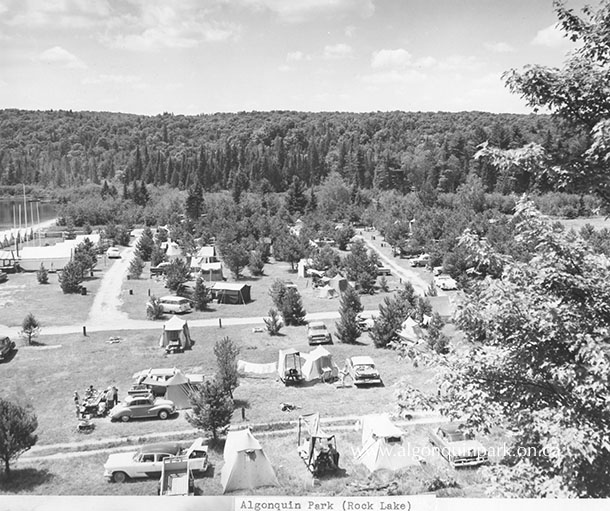
Image: The construction of Highway 60 paved the way for the boom of car camping and campground Algonquin Park experienced in the 1950s and 1960s. High view of Rock Lake Campground, 1958. APPAC, APM 713.
No person can be entirely characterized as good or evil. Each is a shade of grey, a mixture of the positive and negative traits of their personality and actions. J.R. Booth is no different. MacKay’s book does an exemplary job of exploring all aspects and opinions of Booth’s life and personality. Booth agreed to very few interviews and left no personal recollections behind. To begin the task of getting to know the man himself, MacKay was tasked with searching newspaper articles and quotations of the day as well as listening to the stories of people still living who had once met or heard of Booth. The story that emerged is more often than not a favourable one, with Booth remembered as a man who treated his workers and those in need with respect and kindness.
However, alongside his many charitable deeds, paternal employer instincts, and down-to-earth demeanor, Booth’s life story exhibits his shrewd business decisions and limited environmental consciousness. He contributed to and took advantage of the treatment of Indigenous Peoples in his time. As a lumberman expanding his empire during the square timber period, Booth, alongside his contemporaries, acted with the colonialist invasion and resource extraction of the traditional territories of Indigenous Peoples. With the settlement that followed in the Ottawa Valley and the creation of Algonquin Park, the Algonquins were removed from their land. For Booth specifically, he decided to build the western terminus of his railway at Parry Island, an “Indian Reserve” where his engineers found a natural harbour perfect for large steamships. Booth took advantage of legislation that allowed for the forced purchase of Indigenous lands for railway construction, altering the landscape in service of his enterprise.

Image: J.R. Booth left his mark on more than just logs in the forests of his timber limits. His legacy had a far-reaching impact on the lives of average Canadians as well as the Algonquin Park we know today. Stamping hammer from the J.R. Booth Company, photographed October 28, 1970. APPAC, APM 638.
With the good and the bad, Booth has had long-standing impacts and influences on the industries and people of Ontario and Canada. In Algonquin Park alone, we see remnants of his legacy through geographical landmarks named for him, the remains of lumber camps and farm clearings that dot the landscape, and the abandoned rail line which once rumbled with shipments of grain, timber, and people. A hike at Booth’s Rock Trail gives you a glimpse into his own family’s enjoyment of Algonquin Park and the legacy they have left in the remains of the Rock Lake community. Without Booth’s impact on Algonquin Park, the Park that visitors know today would look and feel very different. For most of his life, J.R. Booth had a great influence on the people and places around him. His life is an interesting story to read and learn from, just like those who paid their respects 100 years ago.
Learn More
Learn more about the Algonquin Provincial Park Archives & Collections
- Explore the online database of photographs, archival records, and artifacts.
- Contact the Collections Coordinator to schedule a research appointment or discuss a donation.
- Read more by purchasing historical publications in The Friends of Algonquin Park’s bookstore.
- Support the Archives with a financial donation via The Friends of Algonquin Park, a Canadian registered charity, to assist us in preserving Algonquin Park's cultural heritage for future generations.
October 12, 2025
Capturing a Moment in Time
Each year, we can only guess at the incredible number of photographs that are captured in Algonquin Park. Is it hundreds of thousands? Perhaps millions?
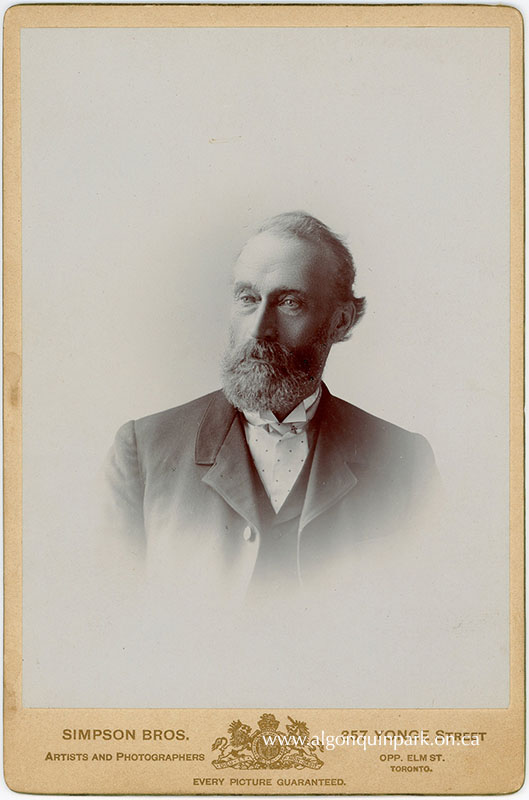 Whether it’s a quick snap on a cellphone camera, or an edited, high-quality image from professional equipment, we all want to cherish our experiences in this beautiful and inspiring setting. Some may purchase an image or a souvenir from a gift shop but even more will create their own memorabilia.
Whether it’s a quick snap on a cellphone camera, or an edited, high-quality image from professional equipment, we all want to cherish our experiences in this beautiful and inspiring setting. Some may purchase an image or a souvenir from a gift shop but even more will create their own memorabilia.
This is a time-honoured tradition. When Algonquin Park was created in 1893, photography, although expensive and difficult, was still a possibility. At the time, photography was mainly used by professionals and Government offices for research, exploration, and surveys. The high cost and tricky development processes meant it was not a hobby that could be enjoyed by everyone. One of the main reasons it was so expensive was that negatives were captured on glass. Beyond the cost, it’s incredible to think that negatives captured on a glass plate could survive to be made into paper prints after surviving the return journey home by railway or canoe, the only transportation options in the Park at the time.
Image: With the high cost and technical expertise needed to operate early camera equipment, photograph studios provided their services to the public. This portrait of Peter Thomson, Algonquin Park’s first Superintendent, was captured sometime between the 1880s and 1895 at the Simpson Bros. studio at 357 Yonge Street, Toronto, Ontario. APPAC, 1976.88.1, H.L. Flood.
The earliest photograph albums at the Algonquin Provincial Park Archives & Collections (APPAC; “Archives”) date to the 1890s. Two of these were created by John Walter Le Breton Ross, while working on the survey crew for the Ottawa, Arnprior & Parry Sound Railway. These albums showcase images he captured from 1894-1896. His images illustrate the scenery he experienced along the soon-to-be railway line and the work of men and horses labouring to create the railroad tracks and bridges. One of the images is even considered to be APPAC’s earliest selfie. Leaning against a tree in the bottom right of the scene, Le Breton Ross holds a trigger in his hand which activates the camera to photograph himself and his colleagues.

Image: Left – Men and horses work together to drive piles (posts) for a railway bridge at Rainy Lake, 1896. APPAC, 1976.86.1.45, Photographed by John Walter Le Breton Ross. Right – John Walter Le Breton Ross leans against a tree in the foreground with the rest of the survey crew behind him in W.S. Cranston's Camp No. 1 at Cache Lake, 1895. APPAC, 1976.86.1.31, Photographed by John Walter Le Breton Ross.
Over time, the process of photography evolved and changed, as new methods of capturing images and developing negatives were invented. Eventually negatives shifted from glass to plastic mediums, creating a much more affordable and easier to use pastime.
In 1900, the Eastman Kodak Company introduced its mass-market Brownie camera which could be purchased for $1 as an entryway into the world of photography. The company would sell 10 million units in the first five years. The Archives similarly sees a boom in photographs from the 1900s onwards. Park visitors, residents, and staff alike captured images of scenery, wildlife, friends, and family. As a nature reserve, hunting in Algonquin Park was prohibited, but “shooting by camera” was advertised to wildlife enthusiasts. Photographs would become a key advertising technique to entice visitors to the hotels and fishing opportunities of Algonquin Park in the early 1900s.
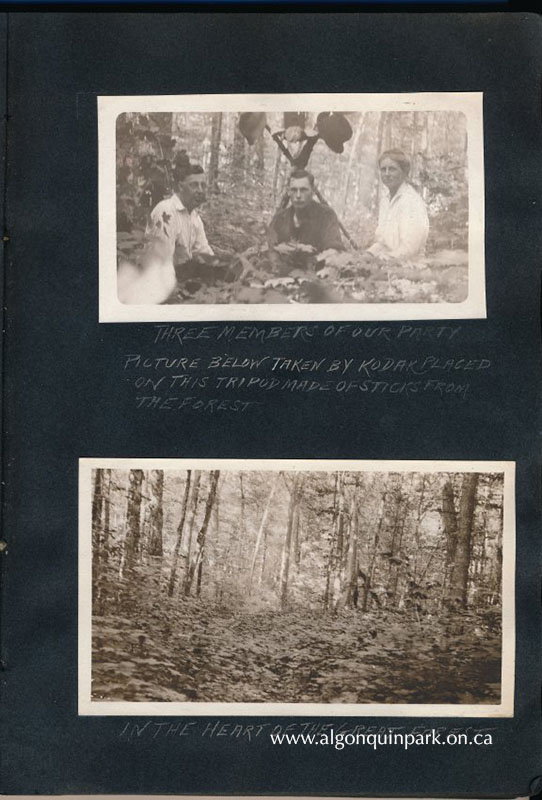
Image: Scrapbook page from album titled “1916 Vacation Scenes Rock Lake, Canada” belonging to Park Ranger Steve Waters. The top image shows three party members sitting in front of a stick tripod with a Brownie camera perched on top. The image below of the forest was taken from this tripod contraption. APPAC, 1998.8.39, From the Collection of Stephen James Waters and Mrs. Albert (Patricia Ware) Swann.
Along with photograph albums, amateur photographers in the early 1900s made their own postcards. Their negatives could be contact printed onto blank postcard stock paper, and the resulting postcard, featuring their very own image, could be mailed to loved ones. One way to tell if a postcard is a “real photo postcard”, and not one mass produced by a printing press, is the relative size of the image to the paper support. In this example below, you can see the image is a little off centre and smaller than the postcard paper.
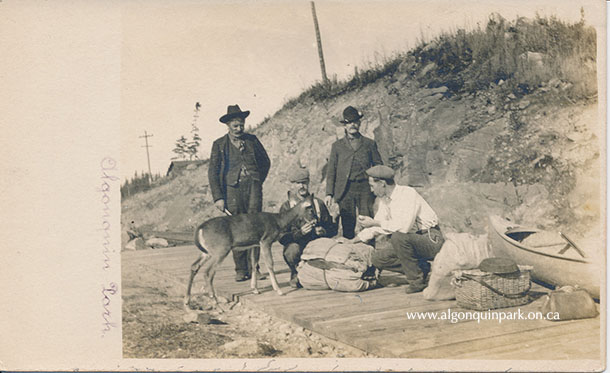
Image: A “real photo” postcard created by Bert Hancock, auditor and bookkeeper at the Highland Inn. The image shows members of a canoe trip party feeding a deer on a railway platform with their canoe and packs nearby. The reverse is postmarked 1908. APPAC, 2023.3.24, Collection of Don Beauprie.
Photographs and postcards were also used as a means for identification. In the rural communities of Algonquin Park, residents relied on their tight knit communities to produce pieces of identification. This photograph of the Thomas family was taken and turned into a postcard by ‘Bert’ Hancock, who worked as bookkeeper and auditor for The Highland Inn. The postcard was taken to the nearest Justice of the Peace to certify their identities so they could apply for passports to England.
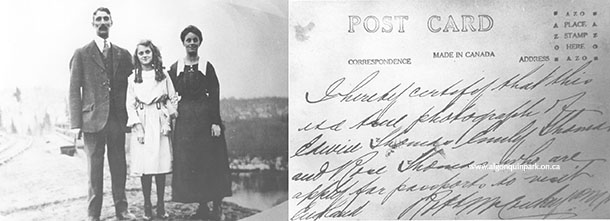
Image: Front and reverse of postcard used by the Thomas family to apply for passports to England, in 1920. Edwin and Emily Thomas lived with their daughter Rose at Canoe Lake. APPAC, 1972.3.32-33, Thomas and Wilkinson.
As technology advanced, photography became more accessible with added features. Cameras began to have manual exposures, f stops, and light meters. With all of these features, photography could be difficult to learn, and in many urban centres, enthusiasts created camera clubs. Camera clubs and conventions allowed people to experiment and learn about photography.
The Thomas and Wilkinson Collection at APPAC includes some special pieces which illustrate these camera clubs. Below is a score card used to adjudicate Rose Thomas’ submission to the “Federation of Ontario Naturalist Photographic Exhibition”. Participants of this photography exhibition submitted four prints to three judges who recorded their scores on the card. Within these clubs and exhibitions women were fairly welcomed, and even residents from rural settings could join. After moving from Canoe Lake, the Thomas family, together with their relative Jack Wilkinson, were the proprietors of Kish-Kaduk Lodge on Cedar Lake in the northern part of Algonquin Park. For her submission of “Wild baby Red Fox”, Rose Thomas received an honourable mention, and her ribbon is present in the Archives’ collection.
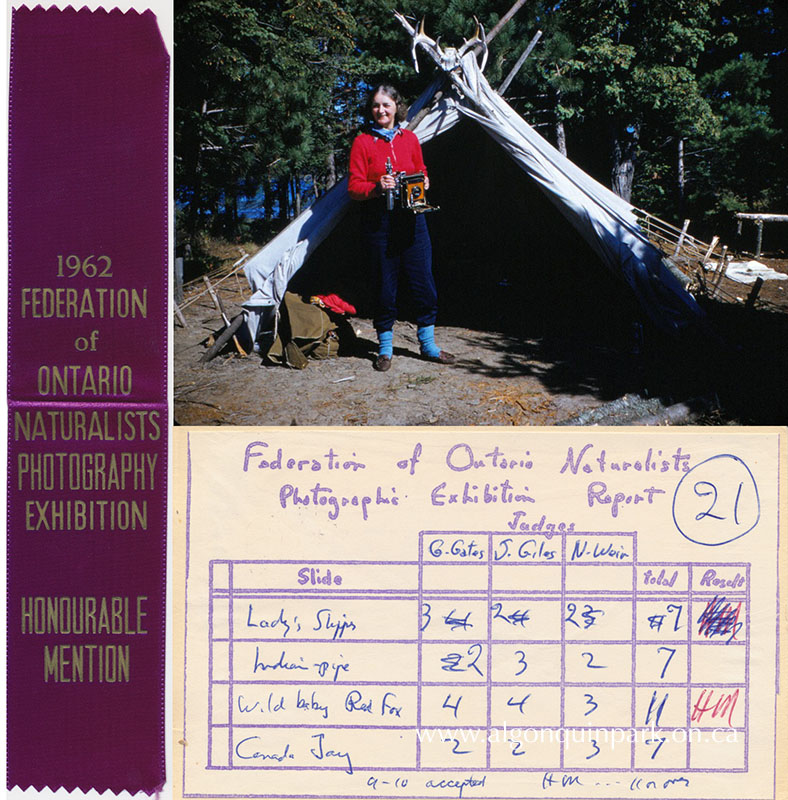
Image: Rose Thomas poses with her camera in front of a canvas tent, c. 1950s – 1970s. The scorecard for her submissions to the 1962 Federation of Ontario Naturalists Photographic Exhibition was mailed to her at Kish-Kaduk Lodge, Algonquin Park. She received this Honourable Mention ribbon for her submission of a photograph of a baby Red Fox. APPAC, 1972.3.109.33,1972.3.246, 1972.3.247, Thomas and Wilkinson.
As for colour photography, its earliest days trace back to the late 1800s, but colour film did not become readily available to the average consumer until the 1930s. Even then, colour images did not become popular until a few decades later. When colour photography finally became all the rage, so did the 35mm transparency slide. Unlike negatives, which are the reverse of an image, these slides were positive films and often housed in plastic or cardboard mounts. They could be arranged in slide carousels and projected onto a screen or wall using a slide projector. Travellers returning home from exciting adventures could curate and present their images to friends and families. At The Friends of Algonquin Park bookstore, if you missed out on a certain wildlife spotting or scene with your own camera, you could purchase a set of slides to add to your collection. 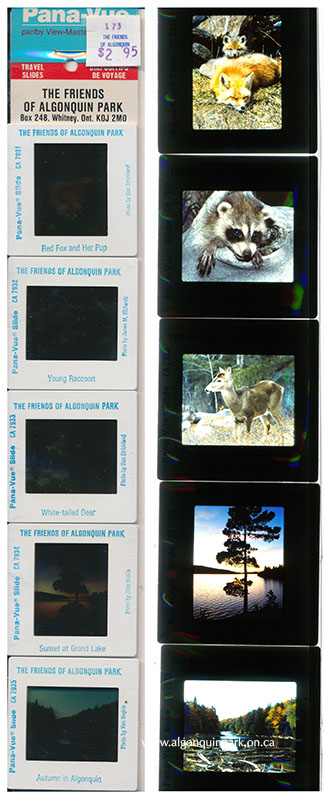
Image: Visitors to The Friends of Algonquin Park bookstore could select from a variety of slide sets to add to their collection. This set of five Pana-Vue by View-Master slides features images of "Red Fox and Her Pup"; "Young Raccoon"; "White-tailed Deer"; "Sunset at Grand Lake"; and "Autumn in Algonquin". APPAC, 2024.7.10.
Today we enjoy the vast leaps and bounds available to us with digital photography. No longer limited by the number of exposures on a single roll of film, today’s camera hunter is free to snap as many images of that elusive bird or mammal as they please, until they dwindle down the number of megabytes remaining on their storage device. Although technology has changed in truly unrecognizable ways to those who enjoyed it over 100 years ago, it's clear that the need to capture and document our lives and beautiful spaces, such as Algonquin Park, will always be timeless.
Learn More
Learn more about the Algonquin Provincial Park Archives & Collections
- Explore the online database of photographs, archival records, and artifacts.
- Contact the Collections Coordinator to schedule a research appointment or discuss a donation.
- Read more by purchasing historical publications in The Friends of Algonquin Park’s bookstore.
- Support the Archives with a financial donation via The Friends of Algonquin Park, a Canadian registered charity, to assist us in preserving Algonquin Park's cultural heritage for future generations.
September 27, 2025
Colouring Algonquin Park
 Tom Thomson, the iconic Canadian artist, is well known for his colourful renditions of the Algonquin Park landscapes so many canoeists and visitors cherish. His love for Algonquin Park is felt through each brushstroke and the impressions he left on those who knew him. He introduced his fellow artists, including the future members of the Group of Seven, to the Park, and his art continues to inspire artists and draw visitors today.
Tom Thomson, the iconic Canadian artist, is well known for his colourful renditions of the Algonquin Park landscapes so many canoeists and visitors cherish. His love for Algonquin Park is felt through each brushstroke and the impressions he left on those who knew him. He introduced his fellow artists, including the future members of the Group of Seven, to the Park, and his art continues to inspire artists and draw visitors today.
But in his time, Thomson was just beginning to receive recognition for his work when he met his untimely fate in Canoe Lake on July 8, 1917. Although ruled accidental drowning, the circumstances surrounding his disappearance, death, and burial continue to draw speculation. Canoeists exploring Canoe Lake can visit a stone cairn crafted by his friends and fellow artists. A replica of the memorial is on display at the Algonquin Park Visitor Centre.
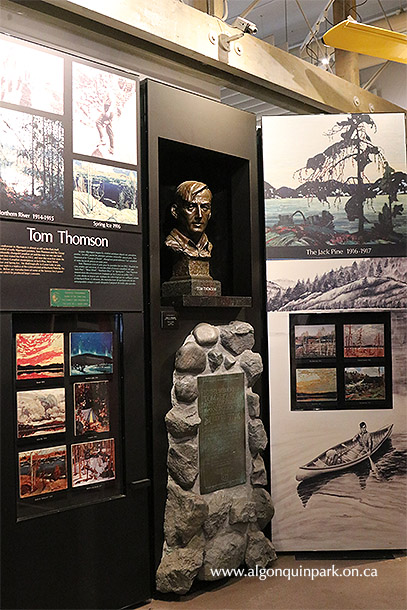
Image: A display in the cultural history exhibits at the Algonquin Visitor Centre highlights the life and works of Tom Thomson. A bust of the artist, sculpted by Sandra J. Shaw, sits above a replica of the stone cairn which is located on Canoe Lake.
Although perhaps the most recognizable and well-known artist connected with Algonquin Park, Tom Thomson is only one of the many who have captured their experiences in these landscapes. For the Algonquin Provincial Park Archives & Collections (APPAC; “Archives”), their work offers a priceless gift to the Park’s history: a glimpse of the Park in colour.
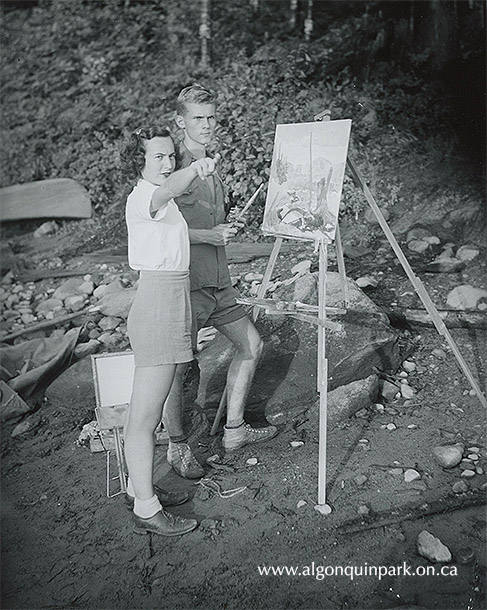
Image: Barbara Caldwell and Robert Bateman, Algonquin Wildlife Research Station, 1949. Bateman stands holding a paint brush next to an easel with a landscape painting in progress. His supplies are visible on the ground behind them. APPAC, x2024.8.2.1.
Before the advent and slow rise of popularity of colour photography, the world was captured in black and white. Through numerous donors, the Archives is fortunate to preserve and share a vast photographic collection that illustrates all aspects of Algonquin Park’s history, but the colours in these scenes are left to the imagination.
Take for instance this photograph of Mowat taken from the village cemetery. Along the shore of Canoe Lake, we can see Mowat Lodge, Blecher's cottage, and other buildings, as well as the remains of the chip yard of the old Gilmour Lumber Company operations. If we were there over 100 years ago when this photograph was captured, we would know the array of colours it represents.
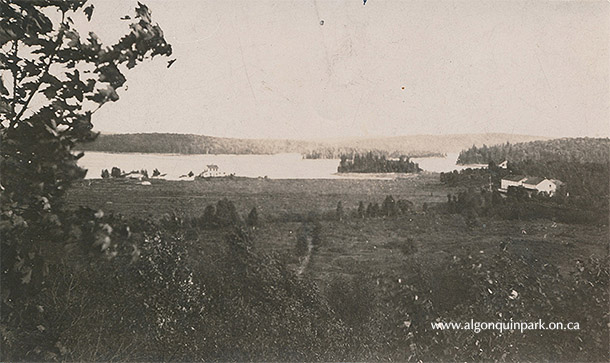
Image: View of Mowat and Canoe Lake from the cemetery, c. 1910s. APPAC, 1995.1.3, Harry and Adele Ebbs.
Tom Thomson helps us visualize what residents and visitors experienced all those years ago. The Tom Thomson Art Gallery in Owen Sound holds a sketch painted by Tom Thomson from a very similar vantage point. His sketch captures the moody sky and lake on the day he sat down to paint the landscape. The white buildings peek out from around the lake, and the brown helps us understand the location of the old logging company’s chip yard.
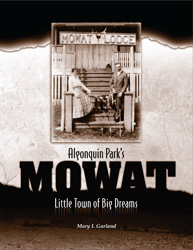 |
| Buy Algonquin Park's Mowat: Little Town of Big Dreams |
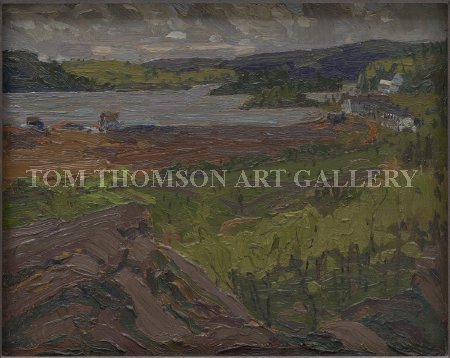
“Canoe Lake, Mowat Lodge”, by Tom Thomson, Summer 1914. Oil on plywood. Tom Thomson Art Gallery, 1988.011.122, Gift from an anonymous donor through the Ontario Heritage Trust, an agency of the Government of Ontario, 1988.
In addition to paintings and drawings, artists would sometimes modify black and white images to create colour photographs. Glass lantern slides and photographic prints could be hand-coloured with paint to illustrate the scene. This technique adds a smattering of colour to an almost entirely black and white collection of early photographs in the Archives.
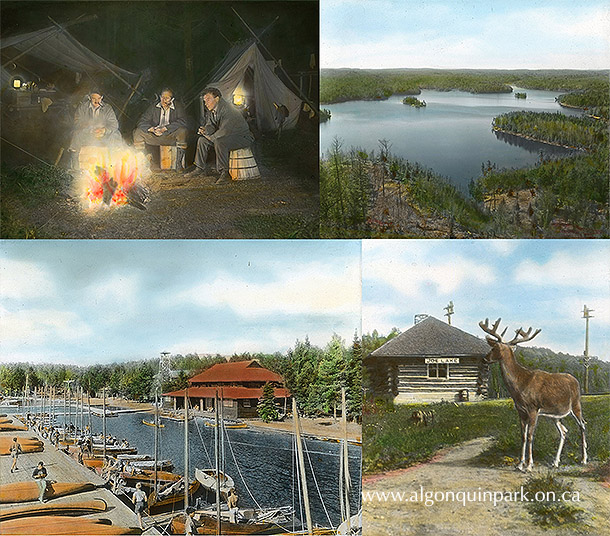
Image: A collection of painted glass lantern slides, c. 1920s – 1940s. An artist has added colour to the original black and white images captured by the camera. Clockwise from top left: three men sit around a fire at their campsite; the view of Cache Lake from the fire tower at Skymount; the docks and buildings of Camp Ahmek, Canoe Lake; “Billy the deer” standing with Joe Lake Station in the background. APPAC, 1976.98.44-47, Collection of Luta and Fletcher Calvert.
One question remains – are these colours accurate? Many artists are devoted to capturing their worlds as accurately as they see them. Mark Robinson’s diary entries and recollections tell us that Tom Thomson was persistent in experimenting with pigments to capture colours such as the grey of an aged stump or the brown of a changing fern.
For those works that might have been created at home or in the photo studio days, months or years after visiting the Park, the colours may be less accurate. In 1925, V.B. Gray, editor of the Rod and Gun Canada magazine, and his fishing party took many black and white photographs as part of their trip through the northern reaches of Algonquin Park. One of these images was the basis for a painting created shortly after the trip and destined to hang in the Canadian National Railway’s New York City office building. When writing to V.B. Gray on November 16, 1925, W.S. Thompson, Director of Publicity, notes the painting “is a striking bit of color except that the water is a little bit too light a shade of blue for Algonquin.” Fortunately for the Archives, Thompson mailed a black and white photograph of the painting to Gray, which can be compared to its muse, but the fate of this painting and its wonderful colours is unknown.
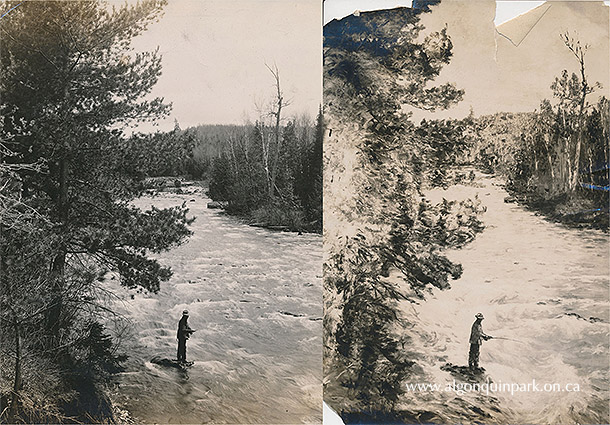
Image: Left – Original photograph of V.B. Gray fly-fishing in White Partridge River, 1925. Right – Black and white photograph of a colour painting sent to V.B. Gray by W.S. Thompson, Canadian National Railway, November 16, 1925. APPAC, x2024.4.1-77.
Whether an accurate depiction or a piece of artistic liberty, the colourful product aids the Park’s history in many ways. If accurate, it provides insight to the colours used and seen by people of that time, and even if slightly altered, the colours remind us that the vibrancy and beauty of the Algonquin Park remains an alluring quality for all who experience it.
Learn More
Learn more about the Algonquin Provincial Park Archives & Collections
- Explore the online database of photographs, archival records, and artifacts.
- Contact the Collections Coordinator to schedule a research appointment or discuss a donation.
- Read more by purchasing historical publications in The Friends of Algonquin Park’s bookstore.
- Support the Archives with a financial donation via The Friends of Algonquin Park, a Canadian registered charity, to assist us in preserving Algonquin Park's cultural heritage for future generations.
August 20, 2025
Your Guide to Algonquin Park

Image: Cover of the 2025 Algonquin Park Information Guide.
Extra, extra! Read all about it!
 First time and frequent visitors alike start their trip to Algonquin Park by picking up the latest “Algonquin Information Guide”, published by The Friends of Algonquin Park. This handy newspaper features all of the campground, reservation, safety, regulation, and program information that visitors need to plan and make the most of their adventures in Algonquin Park.
First time and frequent visitors alike start their trip to Algonquin Park by picking up the latest “Algonquin Information Guide”, published by The Friends of Algonquin Park. This handy newspaper features all of the campground, reservation, safety, regulation, and program information that visitors need to plan and make the most of their adventures in Algonquin Park.
But the information guide visitors know today hasn’t always looked this way, with its newsprint texture, modern photography, and standardized format.
As part of its archival collection, The Algonquin Provincial Park Archives & Collections (APPAC; “Archives”) contains a large collection of Algonquin Park information guides in all shapes and sizes. These documents not only show how information guides have changed and evolved over time, but they also provide a valuable insight into the Park’s history including changes to campgrounds, access, transportation, facilities, programs, and recreational practices.
In the early days of Algonquin Park, advertising and information was produced by the railway companies who hoped to allure visitors to the Park and in turn sell passengers train tickets and stays in their hotels. Their maps and booklets offered prospective visitors a glimpse of the attractions that awaited them and the information needed to plan their trip.
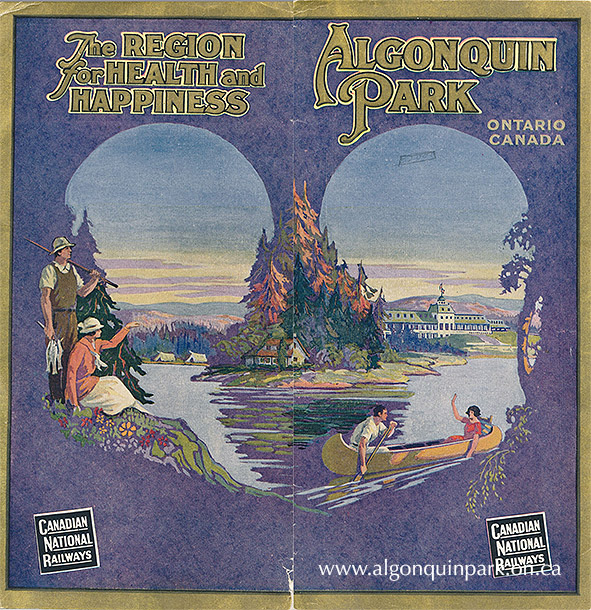
Image: Back and front cover of an advertising booklet titled “Algonquin Park” “The Region for Health and Happiness” published by Canadian National Railways, 1924. The Highland Inn, tents, and a cottage are visible in the background of two couples happily fishing and canoeing. APPAC, I-4-1c.
In stark contrast, the Archives’ earliest “information guide” published by the Government of Ontario is the 1920 all text, no pictures booklet listing 29 “Regulations Respecting Algonquin Provincial Park Ontario”. By 1931, the booklet had been updated to include 43 regulations. Then, like today, visitors were required to obtain travel permits, camping permits, and fishing permits for their visits. This booklet outlined the rules, fees, and responsibilities for those visiting and working in Algonquin Park.
Image: Cover and pg. 4-5 of “Regulations Respecting Algonquin Provincial Park”, published by the Government of Ontario, 1931. APPAC, E-7-6a.
At the same time, local publishers were selling their own guides, providing more information and advice then the bare bones government regulations. This 1937 “Algonquin Provincial Park” booklet published by P.H. Rice of Huntsville, Ontario includes advertisements from the Government of Ontario and local businesses alongside various trip planning information. The booklet describes the history and environment of Algonquin Park, illustrates various canoe routes, provides transportation and regulation information, and places emphasis on the wildlife and fishing opportunities.
Image: Cover of “Algonquin Provincial Park” by P.H. Rice, Huntsville, Ontario, 1937 with sample page. Page 27 provides suggestions for the ideal canoe outfit to be packed for a trip. Information guides provide not only a glimpse into how the Park was at the time of publication, but also the recreational practices and equipment. APPAC, 2023.3.60, D. Beauprie.
In time, the Ontario Department of Lands and Forests, the ministry that once managed the Provincial Park system, began to produce its own booklets intended to attract potential visitors and provide information for their trips. Artwork and photographs in this 1949 booklet illustrate the activities visitors could enjoy and the wildlife they could expect to see during their visit.
Image: Cover and first pages of “Algonquin Provincial Park” published by the Department of Lands and Forests, c. 1949. Among the outdoor recreationalists, photography enthusiasts were encouraged to visit Algonquin Park to capture its wildlife, “such as this raccoon.” APPAC, 2023.3.59, D. Beauprie.
The booklet describes the beauty of the environment and opportunities available to anglers. A description of fisheries management and a list of the lakes closed in alternating years helped anglers plan their canoe routes. Today the text provides modern researchers a look at the history of conservation practices and experiments in Algonquin Park.
The booklet also advertises Algonquin Park’s first public campground, Lake of Two Rivers Campground, which first opened in 1938. With the booming popularity of car-camping in the 1950s, more campgrounds were cleared and expanded to meet the demand.
The Ontario Department of Lands and Forests, and its successor, the Ontario Ministry of Natural Resources (formed in 1972), continued to publish booklets, and later shorter leaflets and brochures. APPAC holds select examples from the 1950s and 1960s and a comprehensive collection of brochures beginning with the 1970s. Generalized Algonquin Park brochures were supplemented by specific campground brochures. The Archives holds brochures for Tea Lake, Lake of Two Rivers, Mew Lake, Canisbay Lake, Pog Lake, Kearney Lake, Rock Lake, and Raccoon Lake Campgrounds from 1983 - 2003, and Opeongo Lake Campground from 1983 – 1985.
Image: Map from the Opeongo Lake Campground brochure, 1983. The campground was permanently closed in 1987. APPAC, M-17-1j.
The newspaper style of information guide known today first arrived on the scene in 1990. Two information guides, “Parkway Corridor: Day Users’ Information” and “The Park Interior: Interior User’s Information” were published in English and French by The Friends of Algonquin Park for the Ontario Ministry of Natural Resources. The Friends of Algonquin Park were first formed in 1983 to reprint government publications, such as the canoe routes map, so that proceeds could be directly reinvested into Algonquin Park. Their publication role has grown and evolved since then, and the charity supports a variety of initiatives to support the educational and interpretive programs of Algonquin Park.
Image: Cover pages of the 1990 information guides: “Parkway Corridor” and “The Park Interior”. APPAC, M-15-1a; M-15-1c.
Like today’s information guide, these early newspapers included news from the Park and information about regulations, reservations, events, wildlife, and safety. In 2003, the two newspapers would be combined into the “Algonquin Information Guide” and mark the last year the campground leaflets were separate from the guide. In 2004, readers could find all of the campground, corridor, and interior information they needed in one handy resource.
Image: Cover of the 2004 “Algonquin Information Guide” – the first year all of the Park’s information was compiled into one handy resource. APPAC, M-15-2x.
Each and every year, APPAC continues to preserve copies of the information guide as well as a variety of other Algonquin Park publications. They also appreciate the support of donors who help to fill in the gaps of the earliest publications. Collecting today’s materials preserves Algonquin Park history for future generations, just as collecting the past supports our growing understanding of how Algonquin Park was enjoyed, managed, and advertised.
Learn More
Learn more about the Algonquin Provincial Park Archives & Collections
- Explore the online database of photographs, archival records, and artifacts.
- Contact the Collections Coordinator to schedule a research appointment or discuss a donation.
- Read more by purchasing historical publications in The Friends of Algonquin Park’s bookstore.
- Support the Archives with a financial donation via The Friends of Algonquin Park, a Canadian registered charity, to assist us in preserving Algonquin Park's cultural heritage for future generations.
July 29, 2025
The Last Stand: White Pine Nature Reserves in Algonquin Park
 Each year, researchers who call Algonquin Park their laboratory share their research with visitors at Meet the Researcher Day. This event, hosted in partnership between the Algonquin Wildlife Research Station; The Friends of Algonquin Park; Ontario Parks; and Harkness Laboratory of Fisheries Research, allows curious minds to ask questions of those who study reptiles and amphibians, birds, small mammals, fish, wolves, and even humans (through archaeology).
Each year, researchers who call Algonquin Park their laboratory share their research with visitors at Meet the Researcher Day. This event, hosted in partnership between the Algonquin Wildlife Research Station; The Friends of Algonquin Park; Ontario Parks; and Harkness Laboratory of Fisheries Research, allows curious minds to ask questions of those who study reptiles and amphibians, birds, small mammals, fish, wolves, and even humans (through archaeology).
In honour of this year’s Meet the Researcher Day, the Algonquin Provincial Park Archives and Collections (APPAC; “Archives”) is highlighting a researcher who like many others was influenced by his early time in Algonquin Provincial Park. Duncan MacLulich was a student at the University of Toronto when he came into the Park to complete field research in the 1930s. This formative time influenced his passion for ecology and ecosystem preservation throughout his life and career.
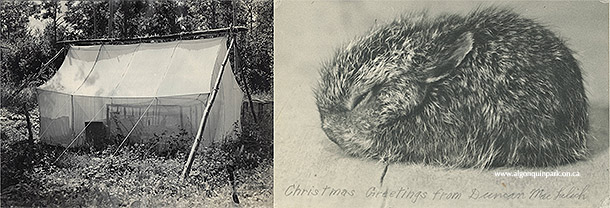
Image: Left - “Field Office” of D. MacLulich during his Varying Hare study, c. 1930s. APPAC, 1977.9.186. Right - Christmas card from MacLulich during his Snowshoe Hare study, c. 1930s. APPAC, 1977.9.234. From the life works and personal possessions of Dr. Duncan A. MacLulich (from daughter M.A. Capstick).
In the 1930s, MacLulich was a student studying forest ecology and later the population of Snowshoe Hare in Algonquin Park. For researchers at this time, the Park was important due to the many opportunities to study animals and environments that had been relatively untouched by humans. However, there were few research facilities available to researchers in Algonquin Park at this time. The one and only in the 1930s was the Ontario Fisheries Research Laboratory (OFRL) which opened a station on Lake Opeongo in 1936.
In exchange for helping haul nets and measure fish, MacLulich, and other researchers, were able to live and work in the Park and run their own field research. MacLulich described the lab as “having a broad view of their responsibility to biology as a whole”. These early years conducting research within the Park and in the Ontario wilderness led MacLulich to create lasting relationships with not only the people in the Park but with the environment as well.

Image: D.A. MacLulich pictured sitting in the Ontario Fisheries Research Laboratory, at Lake Opeongo, 1938. APPAC, 1977.9.229. Donated from the Collection of Dr. Duncan A. MacLulich by daughter M.A. Capstick
 |
Make a charitable donation to assist us in protecting Algonquin Park's cultural heritage for future generations. |
After graduating from the University of Toronto, MacLulich was offered a job as a Park Ranger in Algonquin Park by Superintendent Frank MacDougall.
Superintendent MacDougall believed that it was essential to have biology research within the Park although no such positions existed on Park Staff at the time. MacLulich was hired as a ranger and given ranger duties while being encouraged to do research on the side. The Archives also consider him to be the first Park Naturalist on staff, setting out the first interpretive trail on the Canisbay Lake portage in 1938. In addition to his duties, MacLulich completed studies on animal populations and was asked to run a trout parasite survey by Professor Harkness of the OFRL. He covered 7 watersheds and several lakes, sampling Brook Trout.
MacLulich was even with Professor Harkness studying the data of the trout research when he received a telegram requesting his arrival at the Royal Canadian Air Force (RCAF) Trenton Station to undergo an Officer’s Navigation course as part of the war efforts for World War II. MacLulich served in the RCAF until his retirement at the age of 60, interrupting his time in the Park. However, he continued to publish and have correspondence with biology groups and professionals while he served, even publishing his trout survey in 1943.
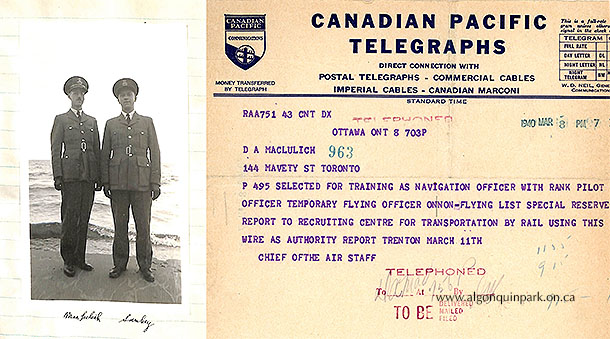
Image: Left - MacLulich in RCAF uniform, 1941. APPAC 1977.9.97. Right - Telegram from RCAF to report for duty, March 8, 1940. Donated from the Collection of Dr. Duncan A. MacLulich by daughter M.A. Capstick.
Upon his retirement in 1960, MacLulich re-entered academia to start his “third career” as a teacher and department chair at Wilfred Laurier University (WLU) (previously Waterloo Lutheran University). He returned once more to his roots, sitting on the board of an advisory committee created to recommend specific areas to the Government of Ontario that should be reserved or acquired as Nature Reserves, and to advise on broad fields of interest and study within those reserves.
The committee did slightly more than that, even creating a way to define areas of need, using the International Biological Program classification sheets to identify areas. In a press release MacLulich states that Nature Reserve Areas should be preserved “to be enjoyed by the present generation and generations to come [as] Once they are gone, they can never be restored”. These reserves would also be essential places for scientific investigation. When being interviewed about this system, MacLulich was adamant that all ecosystems of the region be preserved including those seen as ‘unique’ or special. As he states, “Unique means there’s only one of it and there’s hardly anything that’s that scarce”. MacLulich and the committee recommended and had the Coldspring Watershed designated as a nature reserve here within Algonquin Park, as well as other areas within Ontario.
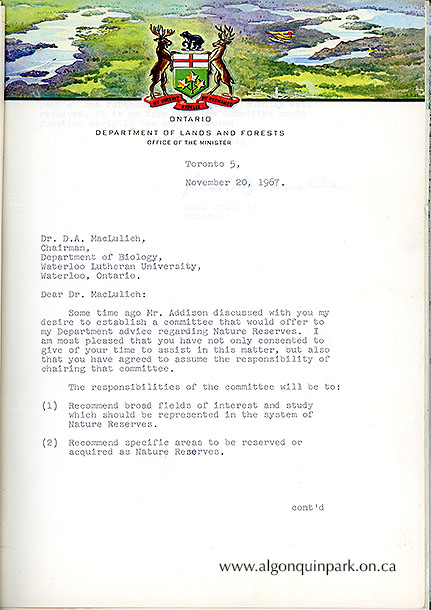
Image: Memorandum from Ontario Department of Lands and Forests to MacLulich about the advisory committee for nature reserves. This letter is written by Minister Rene Brunelle, November 20, 1967. APPAC, 1977.9.57. Donated from the Collection of Dr. Duncan A. MacLulich by daughter M.A. Capstick
MacLulich’s early history with Algonquin Park was not forgotten in his new role. His personal history with the preservation of ecosystems had begun almost 30 years earlier on a camping trip with his father.
When MacLulich was a Ranger in 1938, he and his father, Donald MacLulich, had travelled up the Crow River (North of Lake Opeongo) in search of White Pine. MacLulich had heard that there were some good pine trees up there, and so they searched, finding the pristine forest of old growth pine. Upon returning, MacLulich tried to preserve this area as a “White Pine Monument” for fear that a lumber company would log it, cutting down the impressive trees. He reached out to Superintendent MacDougall and the Federation of Ontario Naturalists with no luck.
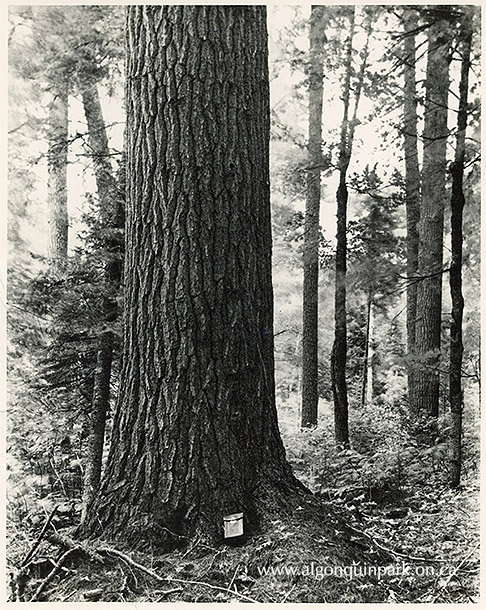
Image: Old White Pine from Big Crow Lake, 1938. APPAC, 1977.9.208. Donated from the Collection of Dr. Duncan A. MacLulich by daughter M.A. Capstick
Even on this advisory board in the 1960s, MacLulich never forgot about the White Pine at Big Crow. In the 1960s he obtained a research grant to investigate White Pine within the Park. So, with a student from WLU, MacLulich began to search Algonquin Park for White Pine, to create a reserve and to study them. They searched all over the Park, hearing of areas through word of mouth. They used MacLulich’s ‘science van’ (a Volkswagen bus that he converted to a moving lab), a canoe, and some idea of the areas they were looking for.
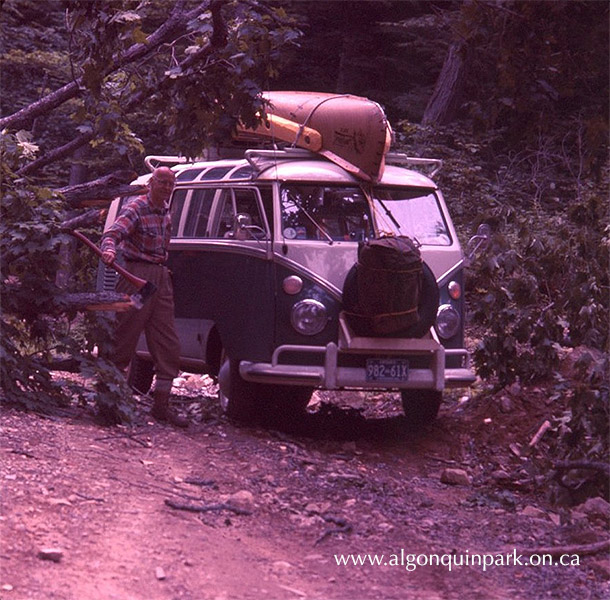
Image: MacLulich on Opeongo Road, 1967. APPAC, 1977.9.237.3. Donated from the Collection of Dr. Duncan A. MacLulich by daughter M.A. Capstick
Algonquin Park Superintendent Bill Hueston became very excited about their project and asked them to expand their search to inform the Park of other areas to be preserved. They received additional support from the Park and were flown in the Beaver aircraft to search for White Pine. During their search, they found a large area of pine at Big Crow, the area MacLulich and his father had visited in 1938. Unknown to MacLulich, Superintendent MacDougall had preserved a small section of trees. The area at Big Crow was perfect for MacLulich’s study, and their field work was finished in 1966, the report delivered in 1968. The area was expanded and became a nature reserve, which over the years has been visited by many canoeists who walk the same trail MacLulich blazed all those years before. MacLulich even created a movie about their work, “Searching for the White Pines”, an early form of science communication our current researchers still employ today to educate the public about their studies. Today, MacLulich’s data, journals, films, and other collections are housed in, and made accessible to historical and scientific researchers by the Park’s Archives.
MacLulich was a staunch defender of wild and natural places, and a lifelong learner and a lover of Algonquin Park. Many that come here spend decades coming back to Algonquin Park, and MacLulich recognized the importance of preserving these environments. He is one of many who have benefitted and supported the continued preservation of Algonquin Park. The old growth pine that were centuries old when MacLulich saw them in his twenties are still around today to be protected and researched.
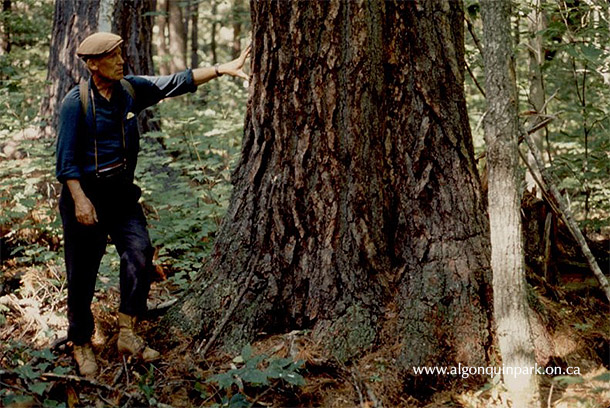
Image: George McGee, friend of MacLulich, under White Pine at Big Crow in August of 1974. APPAC, 1977.9.237.15. Donated from the Collection of Dr. Duncan A. MacLulich by daughter M.A. Capstick
Learn More
Learn more about the Algonquin Provincial Park Archives & Collections
- Explore the online database of photographs, archival records, and artifacts.
- Contact the Collections Coordinator to schedule a research appointment or discuss a donation.
- Read more by purchasing historical publications in The Friends of Algonquin Park’s bookstore.
- Support the Archives with a financial donation via The Friends of Algonquin Park, a Canadian registered charity, to assist us in preserving Algonquin Park's cultural heritage for future generations.
July 22, 2025
The Little Donkey Engine That Could
 Each July the Algonquin Logging Museum is brought to life during Loggers Day, a special event hosted by The Friends of Algonquin Park and the Algonquin Forestry Authority in cooperation with Ontario Parks. Through this day of demonstrations, interpreters tell the stories of the objects, machines, and buildings that depict the eras of logging along the museum’s trail.
Each July the Algonquin Logging Museum is brought to life during Loggers Day, a special event hosted by The Friends of Algonquin Park and the Algonquin Forestry Authority in cooperation with Ontario Parks. Through this day of demonstrations, interpreters tell the stories of the objects, machines, and buildings that depict the eras of logging along the museum’s trail.
One such piece of equipment is an oddly named machine, tucked away inside a log cabin.
This section of the trail begins the story of the technological revolution when machines replaced the man-powered, horse-powered, and water-powered ways of logging. But step inside the cabin, and you’ll see a machine that was not built to replace horses in logging companies, but to help them.
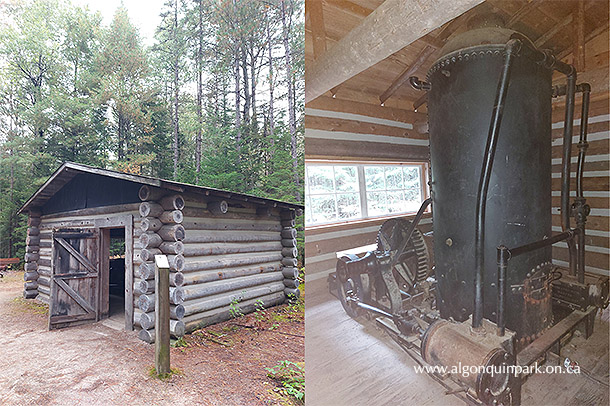
Image: Left: Log cabin at Station 16, Algonquin Logging Museum. Right: As your eyes adjust to the dim interior, a large machine towers over you – the donkey engine.
The donkey engine completed a task that a team of horses could not. Horses’ incredible strength was ideal for pulling heavy sleigh loads of logs downhill or on flat land, but they could not pull them up steep grades of hills. Usually, this limitation didn’t matter. Logs were being taken downhill to a river or lake where they would be piled high until the spring melt. But sometimes loggers needed to move logs over a height of land. The company may have established haul roads over that hill, or an improved water route for the river drive, that they needed to reach.
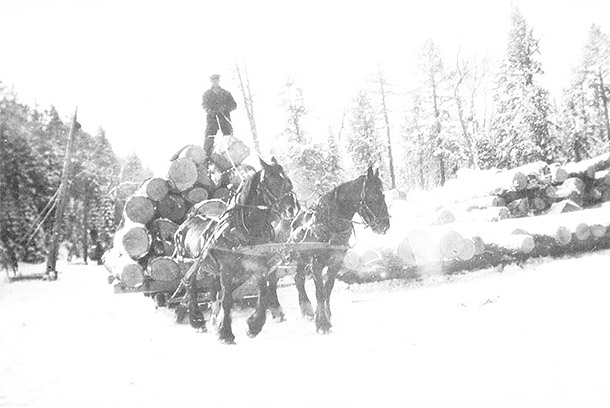
Image: A horse team pulls a sleigh of logs in winter near Brule Lake, c. 1935-1936. A man stands on top of the load, holding the reins. A large pile of logs and a jammer are visible in the background. APPAC, APM 3655, W. Coutts.
The development of the donkey engine solved this problem. Essentially the machine is a steam powered winch. After a horse team reached the bottom of the hill with their load of logs, the sleigh was unhooked from the horses and attached to the cable running from the donkey engine. The horses were removed so that if the cable broke, they would not be killed by the slipping and falling logs and sleigh. The donkey engine would winch the log sleigh up the hill, just like “the little engine that could”. Once at the top, the cable was removed, and the horses could be re-attached to the sleigh to continue the journey.
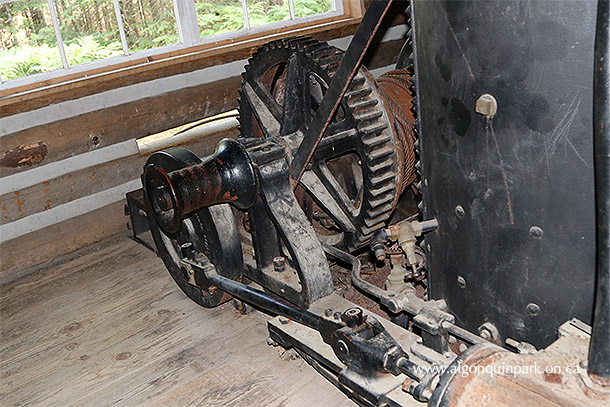
Image: Detail of the winch on the front of the donkey engine, Algonquin Logging Museum. The thick metal cable runs through an opening in the building towards the hill where it would be attached to a sleigh.
 |
Make a charitable donation to assist us in protecting Algonquin Park's cultural heritage for future generations. |
The donkey engine was enclosed in small wooden building. Men worked almost 24 hours a day to keep the machine’s steam powered boiler fed and working. The building not only protected the men but also the machine from extremely cold and freezing temperatures during the winter’s work! A wood stove and various tools and objects would have been found in this building. The stove was also essentially for warming the donkey engine before it was fired up for the first time each season.
These machines were used in many different work forces, not just logging, and came in many shapes, sizes, and capabilities. The name “donkey engine” or “steam donkey” originates from sailing and cargo ships which had small secondary steam engines for loading and unloading cargo, raising large sails, and running pumps. In the logging industry, donkey engines were also useful for loading logs onto rails cars.
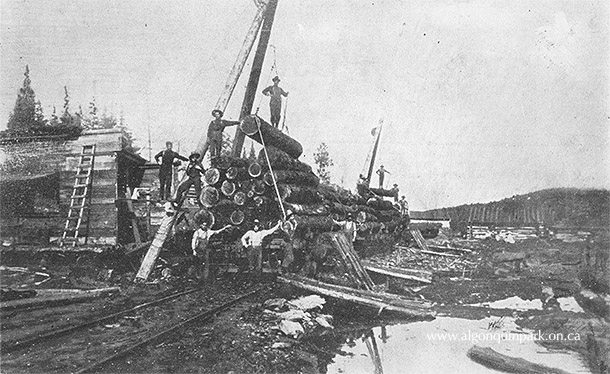
Image: Logs are being loaded onto a railcar using a steam-powered winch which is housed in the building to the left. Lake Opeongo, 1910. APPAC, APM 3298, R.J. Taylor.
Like many objects along the Algonquin Logging Museum trail, this machine has a unique origin story. This donkey engine was built by Marsh & Henthorn Ltd. of Belleville, Ontario in the late 1800s to early 1900s. The machine was one of two that worked side by side at Proulx Lake, Algonquin Park in the 1940s. Markings on the machine read “J.R.B.”, likely the initials of lumber and railway magnate, John Rudolphus Booth. The J.R. Booth Company had timber limits covering the land where this donkey engine was located. They likely had the machine marked as part of their property for the logging operation. Once the logs were pulled up the hill at Proulx Lake, they would continue by sleigh, south and downhill, to a log dump area on the ice and shore of Lake Opeongo.
The two donkey engines were rediscovered in 1990 by Ray Townsend who was accompanied on his journey by Ron Cahill: both staff members of the Algonquin Forestry Authority. While working for a lumber company in the 1970s, Townsend had heard stories about a donkey engine somewhere between Proulx and Opeongo Lakes. Using aerial photographs and contour maps, he scouted possible locations. After only one wrong educated guess, Townsend and Cahill came upon the two donkey engines, the wooden buildings that had once surrounded them since rotted to the ground.
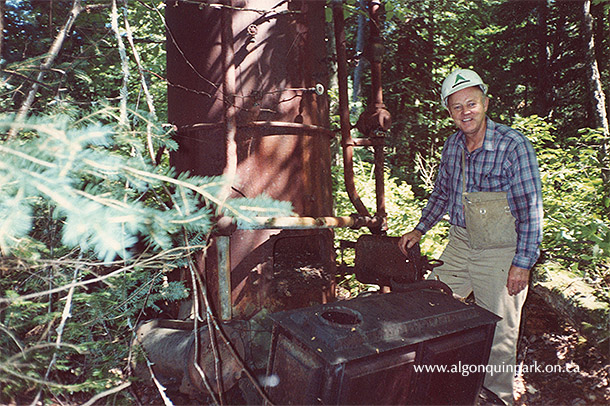
Image: Ray Townsend stands with one of the two donkey engines re-discovered near Proulx Lake, 1990. Although the wooden buildings that once sheltered the machines were long gone, other artifacts remained from the operation, including a wood stove visible in the foreground of this image.
At this time, Algonquin Park’s new Algonquin Logging Museum was being developed and Ontario Ministry of Natural Resources staff expressed interest in exhibiting these pieces of machinery. The AFA aided the project by retrieving the winches from the original site. Using heavy machinery, they delivered them to McRae’s Lumber Co. who sandblasted and painted them. In 1998, work was completed on a clearing along the museum’s trail to interpret one of the two donkey engines. The other was kept in storage.
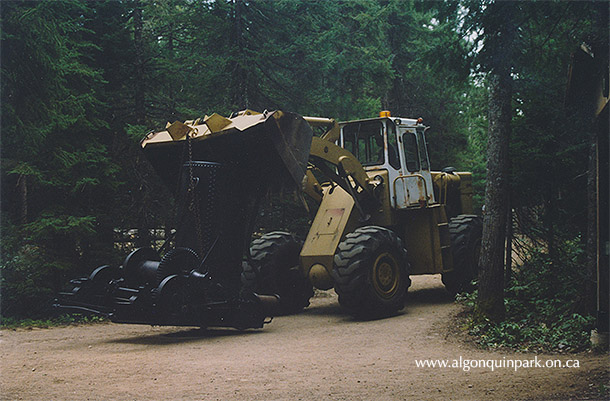
Image: Heavy machinery brings the donkey engine to its new home down the trail at the Algonquin Logging Museum, 1998. APPAC, 2020.18.2.119, J. Mihell.

Image: Staff working with chainsaws to construct the log cabin around the donkey engine, Algonquin Logging Museum, 1998. APPAC, 2020.18.2.120, J. Mihell.
The donkey engine is just one of the many artifacts along the Algonquin Logging Museum’s interpretive trail that illustrates the changes in logging practices and the lives of those who worked in the industry. Whether you attend a guided hike, take part in Loggers Day, or wander the trail on your next trip through Algonquin Park, these objects eagerly anticipate telling you their stories.
Do you know what to do if you find an artifact, big or small, while exploring Algonquin Park?
Do not disturb, move, or collect the object! Archaeologists learn about historic sites by knowing the exact location of an object, how deep in the soil it was found, and its relationship to other objects around it! When an artifact is disturbed, all scientific value of the artifact is lost.
Help us protect and study our sites by:
- Taking a picture of the object with something for scale.
- Recording the location as best you can – GPS coordinates are good if you also make a sketch of the site.
- Reporting your observations to the Algonquin Park Visitor Centre.
Learn More
Learn more about the Algonquin Provincial Park Archives & Collections
- Explore the online database of photographs, archival records, and artifacts.
- Contact the Collections Coordinator to schedule a research appointment or discuss a donation.
- Read more by purchasing historical publications in The Friends of Algonquin Park’s bookstore.
- Support the Archives with a financial donation via The Friends of Algonquin Park, a Canadian registered charity, to assist us in preserving Algonquin Park's cultural heritage for future generations.
May 27, 2025
A Birthday Cake for Algonquin Park
Happy Birthday Algonquin Park! One hundred and thirty-two years have passed since the Ontario legislature enacted the “Algonquin National Park Act”. On May 27, 1893, this bill established the initial boundaries of Algonquin Park and laid out its purpose and regulations.

Image: Map of Algonquin National Park of Ontario, 1893. "Prepared to accompany Report of Park Commissioners to the Honorable A.S. Hardy, Commissioner of Crown Lands”. APPAC, 2018.9.1.
During special anniversary years, Algonquin Park’s birthday celebrations have included large events to recognize these milestones. Centennial celebrations in 1993 included the opening of the Algonquin Park Visitor Centre and Centennial Ridges Trail. Since Algonquin Park’s birthday is also an anniversary for Ontario Parks, 2018 marked the 125th anniversary and the many celebrations included the creation of a time capsule which was placed in the lobby of the Algonquin Visitor Centre. It is scheduled to be opened in 2043.

Image: The Ontario Parks 125th Anniversary Time Capsule in the lobby of the Algonquin Visitor Centre.
 Birthdays come with a variety of traditions and celebrations. Often this includes friends and families gathering to chime in with the time-honoured lyrics of “Happy Birthday” as the individual blows out the candles on their birthday cake.
Birthdays come with a variety of traditions and celebrations. Often this includes friends and families gathering to chime in with the time-honoured lyrics of “Happy Birthday” as the individual blows out the candles on their birthday cake.
If you wanted to make Algonquin Park a birthday cake, how would you do it? Today it’s not too much of a challenge. Avid home bakers could whip up a dessert in their modern kitchen or purchase a cake, perhaps even custom, from a bakery or grocery store.
So, let’s imagine 100 years ago. How would an Algonquin Park resident create a cake for friends and family to enjoy?
First, they’d need a recipe, perhaps one passed down through many generations. “The Recipes of Jean Kirkhope Pirie (Bertram) 1884-1965”, compiled and edited by her grandson, C.A. (Sandy) Lewis, contains an entire chapter dedicated to cakes and squares. The Pirie Family were leaseholders on Canoe Lake beginning in 1905. They purchased the two houses on Gilmour Island which previously belonged to the owners of the Gilmour Lumber Company who had operated a sawmill at Mowat.
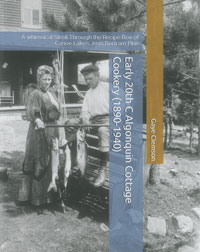 |
| For an annotated edition of Jean Pirie’s recipes, see “Early 20th Century Algonquin Cottage Cookery (1890 - 1940)” |
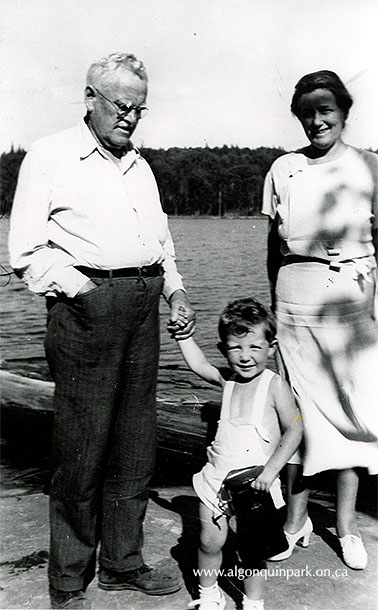
Image: Alexander and Jean Pirie with their grandson, Sandy Lewis on Gilmour Island, Canoe Lake, 1938. APPAC, 1997.18.4, C.A. Lewis.
From the long list of cakes included in the recipe book, it seems the guest of honour could have a difficult time choosing the flavour of their birthday dessert. Strawberry shortcake, apple cake, chocolate cake, sponge cake, meringue layer cake, and angel cake are just a few of the mouthwatering options. The full list illustrates the variety of flavours and fruits that were popular then and still today.
Despite the recipe, a baker always needs a few staples for a cake: flour, baking soda, butter, eggs, milk, water, and vanilla.
Cottagers would bring supplies with them when planning their trip into Algonquin Park. They, and year-round residents, could also arrange for orders to be shipped from department stores. All of these supplies would arrive by the railway (Highway 60 wouldn’t be completed until 1936). The Piries would spend a whole day at Eaton’s (T. Eaton Company Limited) planning and ordering supplies for their two months stay at their leasehold. Once in the Park, the supplies were rowed over to the island.
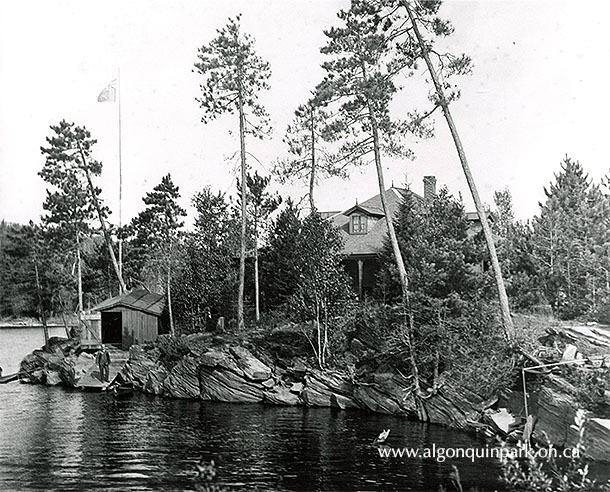
Image: One of the cottages on Gilmour Island, Canoe Lake, c. 1925 – 1930. APPAC, 1977.18.7, C.A. Lewis.
If a resident or visitor needed to top up their supplies or purchase an item, stores in small communities or at lodges offered these services. For example, at Rock Lake, the McCourt Store supplied outfitting gear, such as canoes and life jackets, but was also a general store. They offered all of the necessities, from household and hardware items such as razors, brushes, and coal-oil lamp parts, to groceries including canned goods, dried goods, produce, and dairy items. Milk, butter, and ice cream were kept cold with ice cut from Rock Lake during the winter months.

Image: The McCourt Store at Rock Lake, c. 1915 – 1920. APPAC, APM 2250, V.A. McCourt.
Could residents source fresh products to make a cake? Lodges, lumber company farms, and some residents would also have livestock such as cows and chickens. Their animals would provide fresh products such as eggs and milk. Fresh butter could be churned by hand. If a cake featured berries, jam, or fruit, residents would often pick them in season or grab a jar of preserves from the cellar.

Image: Left: Postcard featuring a black and white image of Edwin Thomas milking a cow, likely in the Canoe Lake area, c. 1910s – 1920s. APPAC, 1972.3.116.1, R. Thomas & J. Wilkinson. Right: A horse-drawn wagon load of people on a berry picking excursion near the Highland Inn. APPAC, 1976.7.5, J. Martin.
As for water, cottagers often used a water pump to ease the chore of carrying water from the lake or river.
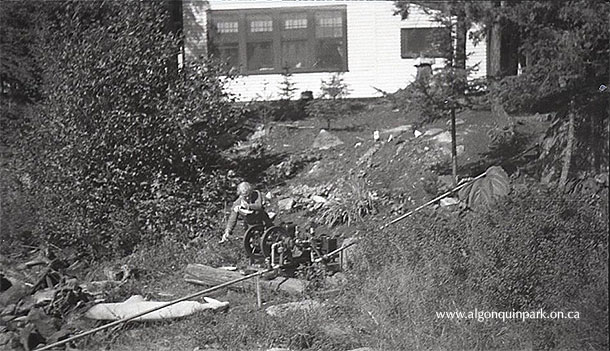
Image: A cottager at the King Leasehold on Cache Lake watches a water pump on the hillside, 1936. Pipes lead from the lake (not seen) to the cottage above. APPAC, 2002.5.183, H.M. King.
With all of the supplies gathered, the precise quantities can be measured and the batter mixed together. But you may wonder, how did they bake the cake? Cottages, hotels, and homes relied on woodstoves as a heat source both for warming the building and for cooking meals. Working with wood fires to bake cakes and pastries was a delicate exercise. The fire would need to be regulated to maintain the required temperature needed to bake. Cooks would know the best tricks for their woodstoves, how much and what kinds of wood to add, and how to manage the air dampers carefully.
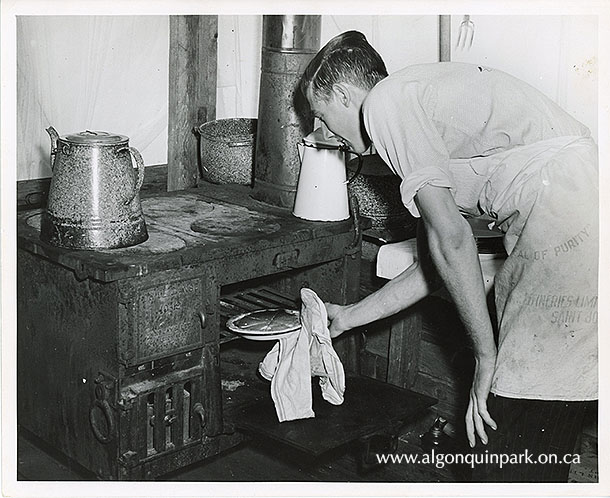
Image: A cook at the Algonquin Wildlife Research Station with a pie in the cookstove in the kitchen tent, c. 1947. APPAC, x2024.8.1.10.
Out on canoe trips, campers might also use a reflector oven to bake desserts such as pies made from berries picked along the route. In “Paddling My Own Canoe”, Esther Keyser explains she found this standard piece of camping equipment awkward to take on canoe trips due to its weight and size – it did not fit easily into a pack. Esther resourcefully discovered she could craft a make-shift reflector oven by using the items in her cook kit. By turning a tall pot on its side facing the fire, a frying pan could then sit inside the pot (“reflector oven”) to bake a variety of savoury and sweet treats. Just like a woodstove, using a reflector oven required the same attentiveness to the pastry and the fire.
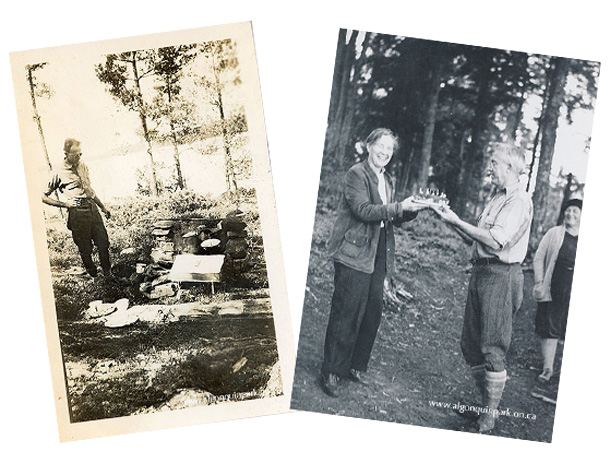
Image (left): A canoe tripper supervises the meal being cooked in the stone camp fireplace, c. 1920s – 1930s. A delightful pastry or bread must be baking in the reflector oven seen at the front of the fire. APPAC, 2002.30.65. S. & M. Cline. Image (right): Mary Markworth and H.M. King celebrate their shared birthday with a cake, September 11, 1938. APPAC, 2023.28.10, H.M. King.
Although more challenging 100 years ago, cakes and desserts were still welcome treats to enjoy in the Algonquin Park “wilderness”.
What kind of cake would you make for Algonquin Park’s birthday?
Learn More
Learn more about the Algonquin Provincial Park Archives & Collections
- Explore the online database of photographs, archival records, and artifacts.
- Contact the Collections Coordinator to schedule a research appointment or discuss a donation.
- Read more by purchasing historical publications in The Friends of Algonquin Park’s bookstore.
- Support the Archives with a financial donation via The Friends of Algonquin Park, a Canadian registered charity, to assist us in preserving Algonquin Park's cultural heritage for future generations.
May 15, 2025
History of Trees: Birch Bark
The Algonquin Provincial Park Archives & Collections (APPAC, “Archives”) records and shares the human history of Algonquin Park, a history that is deeply intwined with the interactions humans have had with the natural environment. This interaction includes the ways in which the environment has shaped society and in turn, the ways in which humans have shaped the environment. When it comes to Algonquin Park’s forests, APPAC’s photographs, records, and artifacts highlight the varied interactions with the trees, including logging, forestry management, and research.
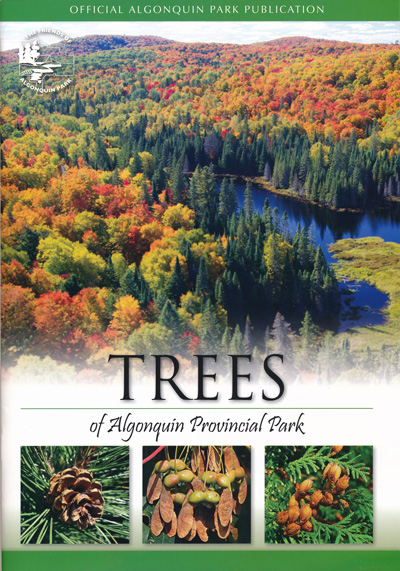 |
| Learn more about the diverse forest landscape in Trees of Algonquin Provincial Park. |
Our thoughts often turn to the towering White Pines when asked to consider how humans have interacted with the forests of Algonquin Park. Of course, these were the source of the logs in such high demand for the expanding British economy and the draw for Euro-Canadian loggers who came searching for them in the 1830s. But White Pine are not the only trees in this landscape. Many other species of trees have had equally important roles and at times even longer histories in the lives of humans.
Take for instance the White Birch, easily recognizable by its brilliantly white and papery bark. Indigenous peoples utilized the resources of the White Birch, including its bark which was used alongside other tree species to craft canoes and containers. At the Algonquin Park Visitor Centre, you can find four birch bark canoes on display with the oldest being a c. 1890 canoe built at Golden Lake, Ontario. The newest is a 2022 canoe built by Master Birch Bark Canoe Builder Chuck Commanda and his partner Joanne Dumoulin alongside Indigenous community members, and visitors in Algonquin Park. Chuck Commanda explained this canoe build was a ceremony intended to strengthen community relationships. He led this build to honour his grandparents Mary and William Commanda who taught him how to build birch bark canoes and baskets from a young age. The canoe build took place over two weeks during Waaseyaa Consulting and Algonquin Outfitters’ “Algonquin Birch Bark Canoe Build” project which is on loan to the Algonquin Park Visitor Centre.
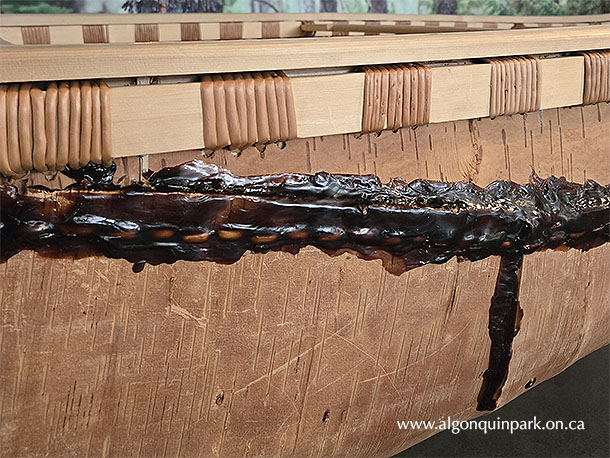
Image: Detail of the birch bark canoe built by Chuck Commanda, Joanne Dumoulin and community partners in 2022. The canoe is on loan to the Algonquin Park Visitor Centre.
A birch bark canoe from the Archives is also on display in the Out-Side-In at Achray. This canoe belonged to Joe Tait, Park Ranger on the East Side of Algonquin Park, stationed at Stonecliffe from 1917-1937. He later served as Deputy Chief Ranger, Chief Ranger, and Forest Protection Supervisor at Stonecliffe, Whitney, and Pembroke. APPAC also holds photographs of birch bark canoes being built and used in and around Algonquin Park, including those used by Park Rangers.

Image: A woman in Park Ranger W.C. Leggett’s birch bark canoe. APPAC, APM 3579, W.C. Leggett.
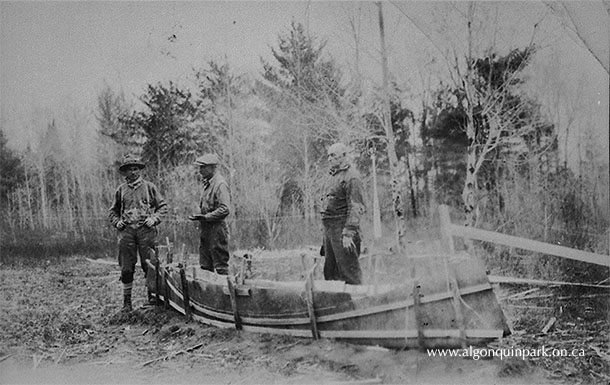
Image: A canoe build at Golden Lake, Ontario. APPAC, 1976.22.2, Jocko.
Less commonly considered are the ways in which birch bark was used for communication and record-keeping. When peeled, the white birch bark has an orange inner surface. The inner surface can be scraped to show a contrasting colour underneath. Depending on the season, the scraped colour revealed will vary. In the fall/winter, the dark layer is scraped to reveal the lighter layers below, and in the spring vice versa. In addition to scraping, the bark biting technique (using the artist’s teeth) can be used to create designs. Indigenous peoples utilized the science behind birch bark anatomy to decorate and record stories on birch bark objects such as canoes, baskets, and more.
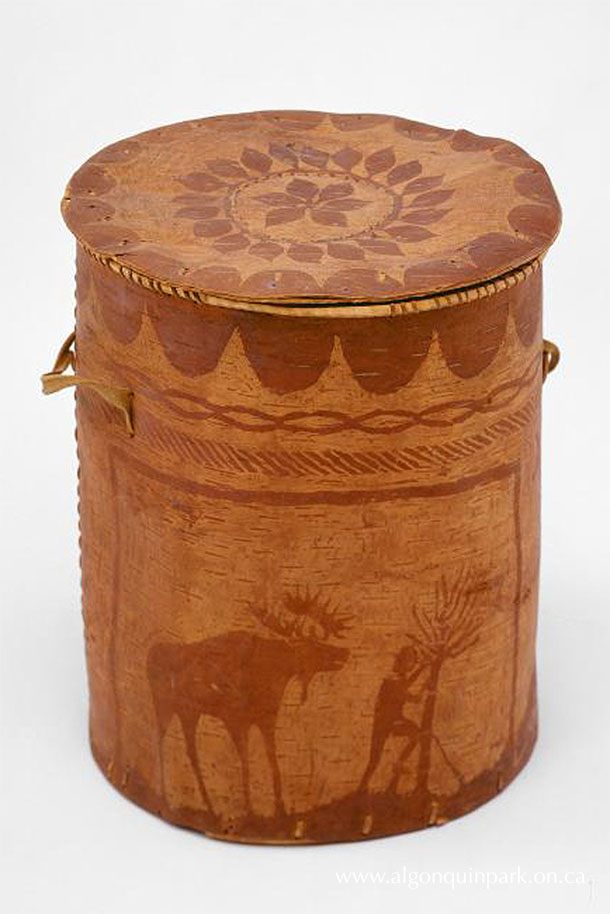
Image: This container held by the McCord Stewart Museum illustrates the scraping technique used to decorate birch bark objects. Birch bark, spruce root (?), wood and hide box made by the Atikamekw Peoples of Quebec, Canada, 1900-1950, McCord Stewart Museum, ME986.219.A-B, Gift of David M. Lank. For more details on birch bark techniques, check out McCord Stewart Museum’s blog post: “Embellishing birchbark: All bark, and some bite".
APPAC holds a very different example of birch bark used for communication – a set of two birch bark postcards, one of which was actually mailed! The two postcards feature ink drawings instead of the Indigenous practice of birch bark scraping. Each postcard depicts a scene from a camping trip. In one, a man carries a loaded pack up a hill, and in the other, a man portages a canoe.
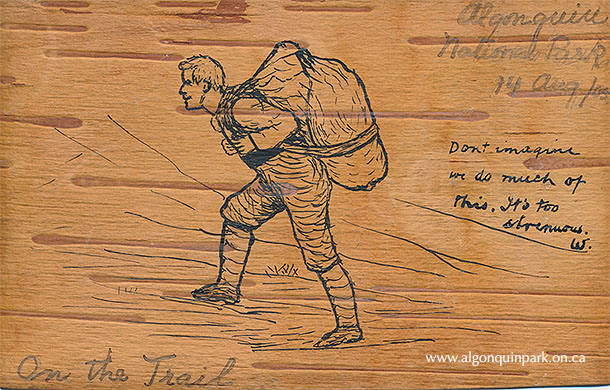
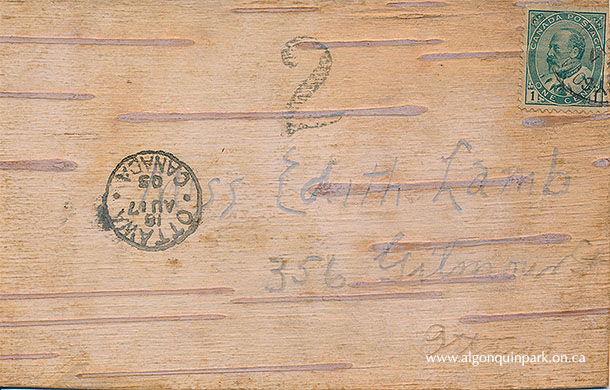
Image: Birch bark postcard and reverse with stamp and postmark. “On the Trail”, 14 cm x 8.8 cm, birch bark and ink. APPAC, 2021.8.1.
The postcards date to August 1905 and were intended for Edith Lamb of Ottawa, Ontario. The messages were written by Edith’s brother, Walter Lamb, who endearingly refers to her as ‘Dith. His humorous messages describe the strenuous and difficult nature of his camping trip, which, in his opinion, the illustrations do not accurately represent. When donating these postcards to the Archives, the family was unsure if Walter was the artist or if he had purchased the postcards from an artist on Cache Lake.
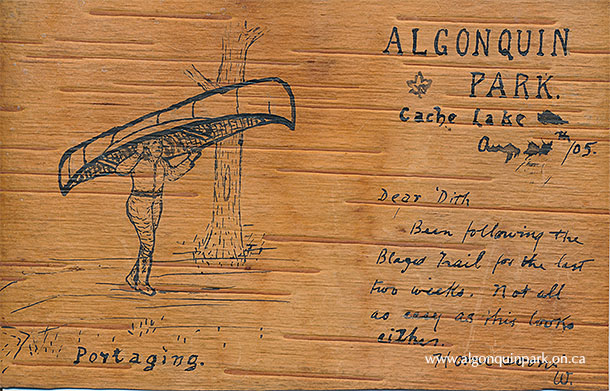
Image: Birch bark postcard. “Portaging”, 14cm x 8.8 cm, birch bark and ink. APPAC, 2021.8.2.
Today, Park regulations prohibit the killing, cutting, removal, or harming of plants. Backcountry regulations encourage respect for vegetation: “It is forbidden to cut or damage any living tree or other plant. This specifically prohibits such disfiguring and outmoded practices as cutting evergreen boughs for bedding; cutting birch bark from living trees; and embedding nails, axes or other objects in trees.” For frivolous items and practices (such as postcards!), this regulation is one of many in place to protect Algonquin Park’s natural and cultural resources.
However, for Indigenous communities, foraging and harvesting are important aspects to their cultural traditions. In a 2024 blog post, Ontario Parks explains that Indigenous “Constitutional rights to harvest for food, ceremonial or social purposes can be exercised within a provincial park or conservation reserve at any time, provided safety and conservation considerations are satisfied.”
When driving by the now replica “birch bark map” sign at Algonquin Park’s West Gate, we hope you will consider the many ways we have benefited from the resources of our natural environment and the ongoing efforts to manage the enjoyment, preservation, and utilization of these resources for generations to come.
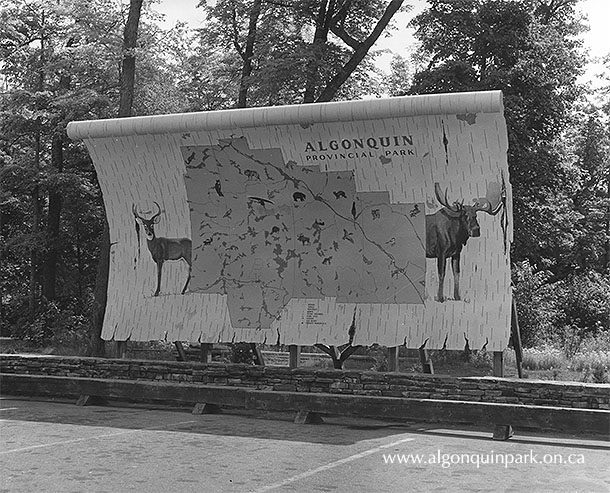
Image: The birch bark map sign at Algonquin Park’s West Gate, 1960. APPAC, APM 793.
Learn More
Learn more about the Algonquin Provincial Park Archives & Collections
- Explore the online database of photographs, archival records, and artifacts.
- Contact the Collections Coordinator to schedule a research appointment or discuss a donation.
- Read more by purchasing historical publications in The Friends of Algonquin Park’s bookstore.
- Support the Archives with a financial donation via The Friends of Algonquin Park, a Canadian registered charity, to assist us in protecting Algonquin Park's cultural heritage for future generations.
April 25, 2025
Angler’s Paradise
 Tomorrow marks the opening of trout fishing season in Algonquin Park. Patiently impatient anglers watching the passing days and melting ice can once again dream of the next catch and new memories made with friends on the lakes and streams.
Tomorrow marks the opening of trout fishing season in Algonquin Park. Patiently impatient anglers watching the passing days and melting ice can once again dream of the next catch and new memories made with friends on the lakes and streams.
Algonquin Park has a long history as a fishing destination, but what did a fishing trip look like 100 years ago?
Among the photographs and albums at the Algonquin Provincial Park Archives and Collections (APPAC; “Archives”), is a scrapbook containing 75 B&W images attached to black paper pages using photo corners or glue. The cover is debossed with gold coloured text “V.B. Gray Algonquin Park, May 21 – June 1, 1925”.

Image: Cover of photograph album debossed “V.B. Gray Algonquin Park, May 21 – June 1, 1925”, APPAC, x2024.4.1-77.
This unassuming album belonged to V.B. Gray, editor of “The Rod and Gun Canada” magazine from the Plain Dealer in Cleveland, Ohio. The images, which are stunning in quality and composition, depict all aspects of the party’s trip including fish and fly-fishing rods; canoes and portages; and meals and camps. Let’s explore some of these images and the stories they have to tell.

Image: V.B. Gray and his fishing party sitting on a log overhanging the Petawawa River near their tent camp on Forbes Creek, 1925. APPAC, x2024.4.1-77.
How did anglers reach Algonquin Park’s lakes 100 years ago? In 1925, visitors couldn’t reach Algonquin Park by car. Highway 60 wouldn’t be constructed for another 11 years. Visitors relied on two rail lines which passed through the Park, one in the north and one in the south. V.B. Gray and his party travelled through the northern reaches of the Park, transporting their canoes by the Canadian National Railway cars.

Image: Loading canoes on a Canadian National Railway car in northern Algonquin Park, 1925. APPAC, x2024.4.1-77.
The party camped in canvas tents erected with cut wooden poles. Tent camps were set up at Forbes Creek and Grand Lake. Photographs with captions also identify locations such as the Petawawa River, White Partridge River, Carcajou Creek, and Lavieille Creek. We can presume their travels took them through the associated lakes in the Lake Travers and Grand Lake region. The images also capture historical places and structures in Algonquin Park including the Out-Side-In Ranger Cabin at Achray, with the sign painted by Tom Thomson.

Image: Weighing a fish in front of one of the tents at the fishing party’s camp at Grand Lake, 1925. APPAC, x2024.4.1-77.

Image: Paddling “Under the palisades of the Petawawa River”, 1925. APPAC, x2024.4.1-77.
It was highly recommended that canoe trippers and fishermen be accompanied by guides on their trips. Each canoe would be accompanied by a guide who paddled steadily for trolling fishing lines, landed fish in nets, carried heavy packs across portages, cooked meals at camp, and provided the expertise for navigating and fishing Algonquin Park. V.B. Gray’s album only provides one reference to a guide, George Wade, although it is likely a party of his size had more than one aiding the fishermen.

Image: Guide George Wade stands behind V.B. Gray who is fly fishing in Lavieille Creek, 1925. Guide Wade holds a net strung with Gray’s catch so far. APPAC, x2024.4.1-77.
The Archives does not hold any copies of The Rod & Gun Canada magazine, but I would wager some of these images were used alongside an article shortly after their trip. We do know one of the images was used to create a painting which hung in the Canadian National Railway’s New York City office building. W.S. Thompson, Director of Publicity, sent a letter to V.B. Gray on November 16, 1925. He discusses an image of the painting he enclosed with the letter, notifying V.B. Gray that he has achieved “immortality” in a 4 foot (1.2 metres) high oil painting which will have a distinguished place in the new offices. He notes the painting “is a striking bit of color except that the water is a little bit too light a shade of blue for Algonquin.”

Image: Black and white photographic print of a colour painting made of one of the photographs from V.B. Gray’s fishing trip, 1925. The painting was to hang in the Canadian National Railway’s office building in New York City. APPAC, x2024.4.1-77.
The connection to CNR runs deeper, and it seems V.B. Gray’s trip may have been funded or partnered with the railway. Some of the images appear in Canadian National Railway promotional brochures, such as a 1928 “Algonquin Park Ontario Canada” brochure advertising “2721 Square Miles of Playground” and inviting readers to “Paddle – Fish and Camp Amid 1500 Sparkling Lakes”. Descriptions of rail service, hotels, camps, cottage leases, camping, canoeing, and the “angler’s paradise” are illustrated with images from V.B. Gray and his fishing party including paddling the Petawawa Gorge, fishing White Partridge Creek, and tent camping on Grand Lake. The brochure also provides details on the prices of guides and trips as well as the fishing regulations of the day, which explain the incredibly large catches that are pictured in various photographs in the Archives.

Image: Clockwise from top left - Picture postcard with image of large catch of fish, Canoe Lake, 1916. APPAC, 1972.3.180, Thomas & Wilkinson. Brochure cover, Algonquin Park Ontario Canada, Canadian National Railway, 1928. APPAC, I-4-1b. Photograph from V.B. Gray’s fishing trip captioned “W.J. (Dad) Taylor of Woodstock takes a few beauties for breakfast”, 1925. APPAC, x2024.4.1-77.
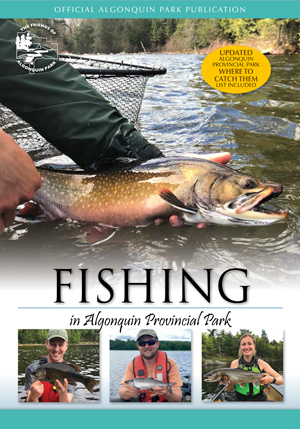 Although your fishing trip may not be sponsored by a major railway, or photographed by professional magazine photographers, the emotions and experiences of fishing in Algonquin Park rival those of 100 years ago. Much has changed, the need for guides has diminished, the equipment and food has evolved and diversified, transportation has altered how visitors reach and explore Algonquin Park – but much also remains the same, the thrill of the catch, the haunting call of the loon on a lake, the sparkling sun on a wind-chopped lake, and the memories created with friends. Enjoy your fishing this weekend and bring back the tall tales!
Although your fishing trip may not be sponsored by a major railway, or photographed by professional magazine photographers, the emotions and experiences of fishing in Algonquin Park rival those of 100 years ago. Much has changed, the need for guides has diminished, the equipment and food has evolved and diversified, transportation has altered how visitors reach and explore Algonquin Park – but much also remains the same, the thrill of the catch, the haunting call of the loon on a lake, the sparkling sun on a wind-chopped lake, and the memories created with friends. Enjoy your fishing this weekend and bring back the tall tales!
Learn More
Learn more about the Algonquin Provincial Park Archives & Collections
- Explore the online database of photographs, archival records, and artifacts.
- Contact the Collections Coordinator to schedule a research appointment or discuss a donation.
- Read more by purchasing historical publications in The Friends of Algonquin Park’s bookstore.
- Support the Archives with a financial donation via The Friends of Algonquin Park, a Canadian registered charity, to assist us in protecting Algonquin Park's cultural heritage for future generations.
April 15, 2025
#ArchivesFunFacts
 This April, the Algonquin Provincial Park Archives & Collections (APPAC, “Archives”) is joining in with the Archives of Ontario’s #ArchivesFunFacts campaign to share intriguing, fascinating, and inspiring stories from heritage organizations.
This April, the Algonquin Provincial Park Archives & Collections (APPAC, “Archives”) is joining in with the Archives of Ontario’s #ArchivesFunFacts campaign to share intriguing, fascinating, and inspiring stories from heritage organizations.
We’ve compiled 22 fun facts to reminiscence about Algonquin Park’s history and museums. Read one every weekday in April or enjoy them all in one go, the choice is yours! Happy reading!
1. Algonquin Park’s first museum opened in 1946 at Cache Lake. This tent museum was assisted by the Royal Ontario Museum and offered displays of models, taxidermy mounts, and live plants and animals. Dr. J.R. Dymond, and later additional naturalist staff, answered questions from visitors and leaseholders, even identifying the reptiles and amphibians children would bring to the tent.
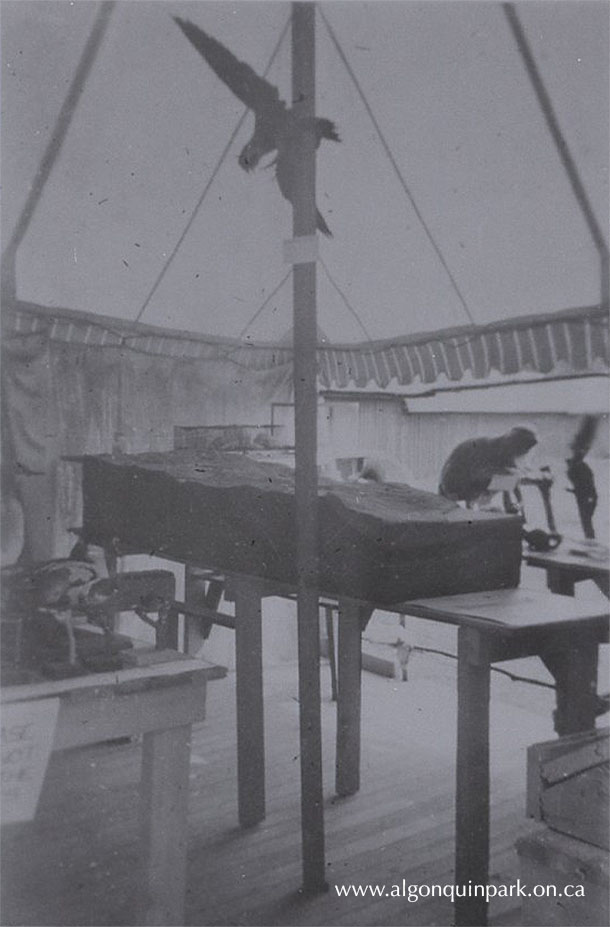
Image: Interior of the first Algonquin Park Museum, a tent at Cache Lake, c. 1946. APPAC, 1994.3.23.
2. Interpretation of Algonquin Park’s cultural history began in 1959 at the Pioneer Logging Exhibit (PLE). A smaller precursor to today’s Algonquin Logging Museum, the PLE offered a look at the lives of 1800s loggers through machinery, reconstructed buildings, and exhibits.
3. Seventeen lodges once offered accommodations, meals, and outfitting services to visitors. Today only three lodges are still in operation. The lodges are well represented in the Archives’ photographs, brochures, and artifacts through which we can learn more about the luxuries of a visit to the Park, advertising techniques, and hotel amenities.
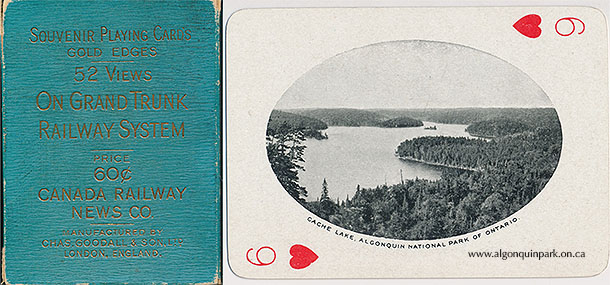
Image: A deck of playing cards produced for the Grand Trunk Railway System, c. 1910s, advertises the scenic locations a traveler could experience with a trip on their railcars. Algonquin National Park is advertised on seven of the cards with images of a winter snowshoe, fishing parties, the Highland Inn, and this view of Cache Lake which visitors still visit today from the Track and Tower Trail. APPAC, 2024.12.1.
4. Park Rangers were required to keep a daily journal as part of their duties which included enforcing regulations, assisting visitors, maintaining portages, patrolling for poachers, and much more. Not many of these early journals have survived the passage of time, but APPAC holds a small collection that provides a valuable insight into the lives of the Park’s early workforce.
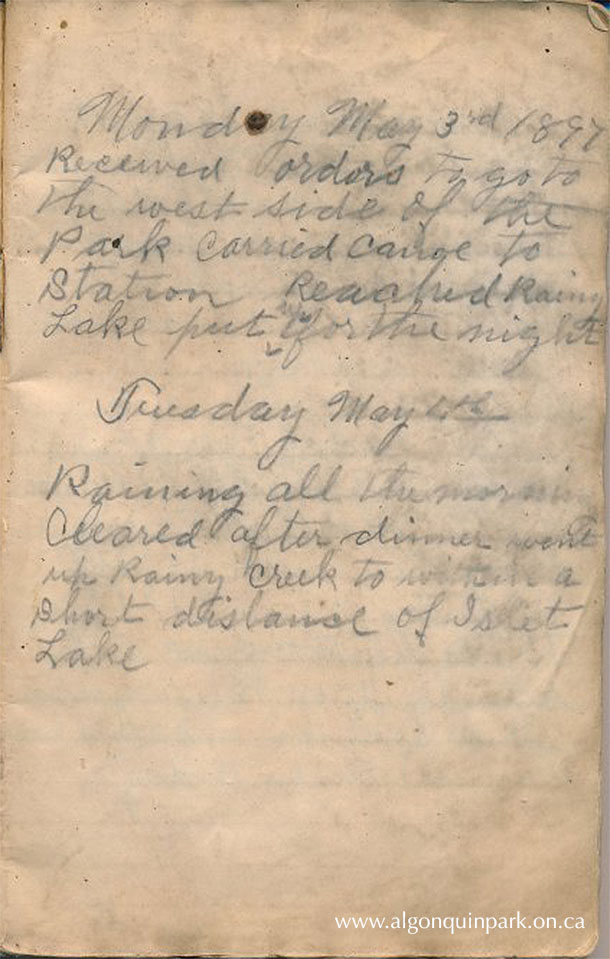
Image: Entries from the diary of Ranger Stephen Waters, May 1897. APPAC, 1998.8.11, From the Collection of Stephen James Waters and Mrs. Albert (Patricia Ware) Swann.
5. The Park Museum opened at Found Lake in 1953 to support the growing interest in Algonquin Park and its natural education program. Staff were excited by the space and the realm of possibilities for the building, but when it opened, they remarked they had already outgrown it! The opening of the museum coincided with the surge in popularity of camping and outdoor experiences. The first program in the lecture hall, which could hold about 100 people, was standing room only with people peering in from outside the doors! Staff soon had to move to outdoor programs.
 |
Make a charitable donation to assist us in protecting Algonquin Park's cultural heritage for future generations. |
6. APPAC’s largest artifact sits on the shore of a pond created by the replica logging chute and dam at the Algonquin Logging Museum. The William M. was once a working alligator boat, a vehicle so named for its ability to move on water and land. It was transported over 275 kilometres from Brent on Cedar Lake, where it was to move logs by the Gillies Bros. Lumber Company. Since being added to the museum, it has been completely refurbished twice to repair the wooden components, but all of its metal parts are still those that once steamed and warped their way across Algonquin Park’s lakes.
7. It’s difficult for the Collections Coordinator to pick a favourite object in the collection, but this transom window from the Highland Inn ranks highly on her list. Located above the hotel room doors, transom windows could be opened slightly to provide air circulation. Although it appears to be stained glass, it is actually a faux design, merely painted with a fleur-de-lis pattern to give the appearance of a high-class amenity.
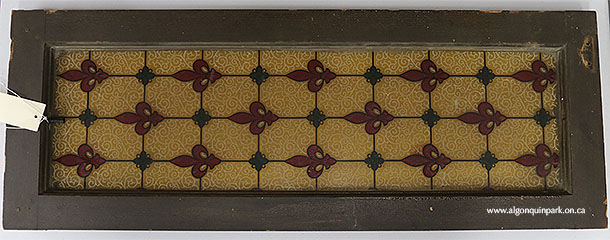
Image: Faux “stained glass” transom window from the Highland Inn. APPAC, 2005.31.1, From the Collection of Don Beauprie.
8. APPAC includes a library which is housed at the Algonquin Park Visitor Centre. Over 11,000 books and journal articles are searchable online and available to researchers during scheduled appointments. The library doubles as a reading room where researchers can view archival records, photographs, and artifacts during their visits.
9. When travelling to vacation destinations, we often return home with souvenirs to remember our trips by and share with family and friends. The Archives contains many examples of postcards, trinkets, and memorabilia which were once sold to visitors in lodge and Park gift shops. An accurate souvenir should represent the environment visited to bring back memories of the trip. Does anything strike you as odd about this pennant?
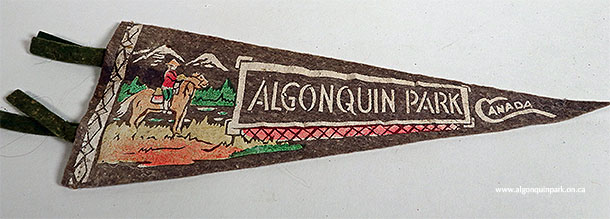
Image: An “Algonquin Park Canada” pennant purchased during a vacation to the Highland Inn, Cache Lake, during the 1950s. A Canadian “Mountie” RCMP officer appears to be riding a horse with mountains in the background – a scene not represented in the Algonquin Park landscape. APPAC, 2013.1.17.
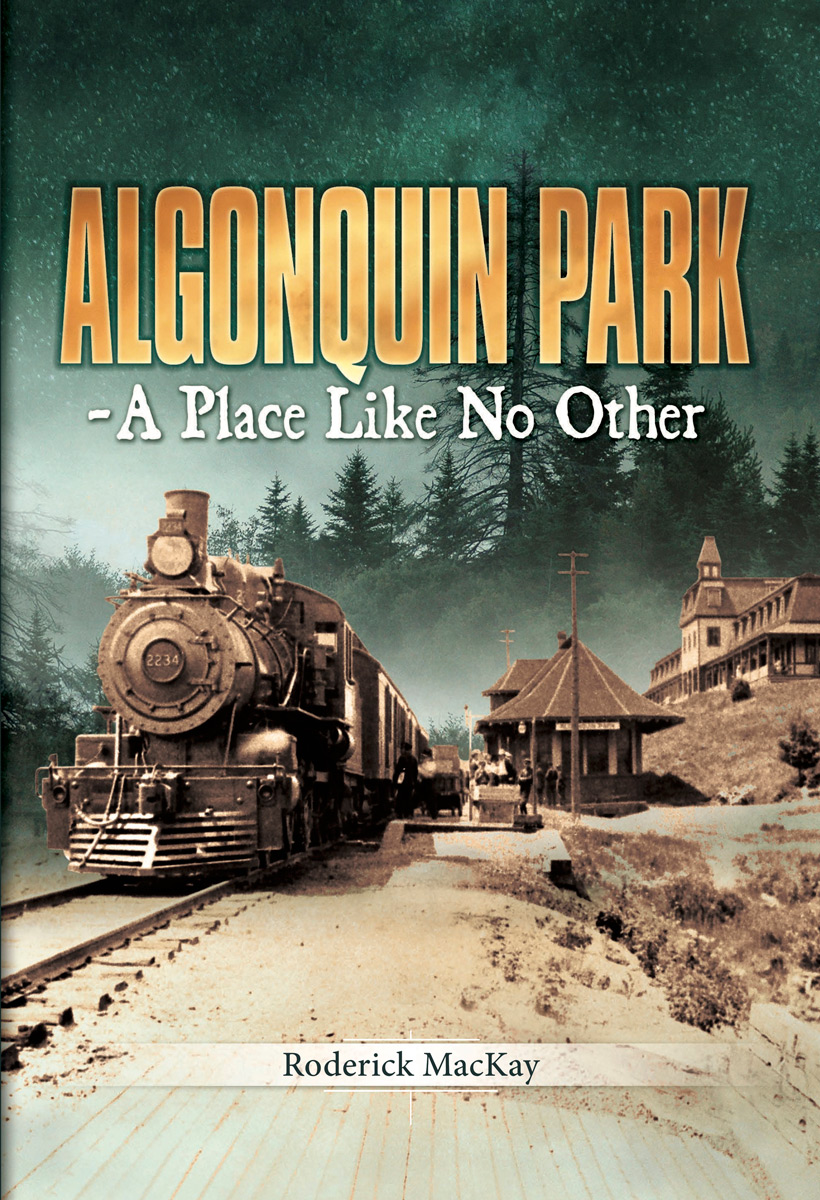 |
| Learn more about history in Algonquin Park - A Place Like No Other. |
10. On May 20, 1993, a ribbon cutting ceremony was held to open the Algonquin Park Visitor Centre as part of the celebrations for Algonquin Park’s centennial year. The design included a purpose-built archival storage space to care for the collection moved from the old Park Museum (now the Algonquin Art Centre).
11. In the 1970s, forward thinking staff started a project to interview Algonquin Park’s “old-timers” to record their stories and recollections. The Oral History Collection now contains over 200 interviews providing a priceless source of information that helps to fill the gaps in written and visual records.
12. Two of the oldest photograph albums in the collection date to 1894-1895 and capture images of the construction of the Ottawa, Arnprior and Parry Sound Railway in Algonquin Park. We can even call one of these images a selfie! In this image John Walter Le Breton Ross, sitting against a tree in the bottom right, holds a trigger in his hand which activates the camera to photograph himself and his colleagues.
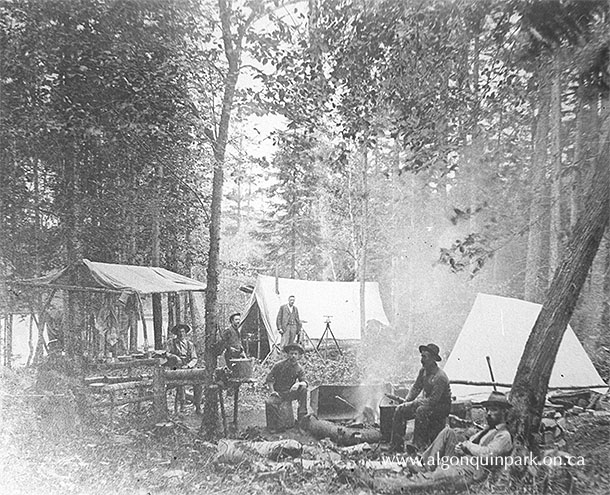
Image: W.S. Cranston's Survey Camp, No. 1, Cache Lake, 1895. APPAC, APM 148, Photographed by John Walter Le Breton Ross.
13. APPAC’s oldest artifacts are thousands of years old. When archaeological excavations are conducted in Algonquin Park, the artifacts are stored with APPAC. For thousands of years, Indigenous Peoples travelled and lived throughout this region, and their descendants continue to use these lands for their traditional values today. The archaeological artifacts in the Archives include Indigenous artifacts such as projectile points, adzes, and scrapers, and change with time to remains of logging camps and settler communities.
14. In 1983, The Friends of Algonquin Park (FOAP) became the first Friends Organization established to support an Ontario Provincial Park. Created out of a need to reprint official government publications such as canoe routes maps, trail guides, and educational publications, the FOAP now supports a wide range of initiatives to enhance the education and interpretation of Algonquin Park, creating new stewards for the future.
15. APPAC’s collections include a taxidermy and herbarium collection used by Ontario Parks staff for programming such as “Ask the Naturalist”. The collection also includes historical specimens which provide a valuable source of information for natural history researchers.
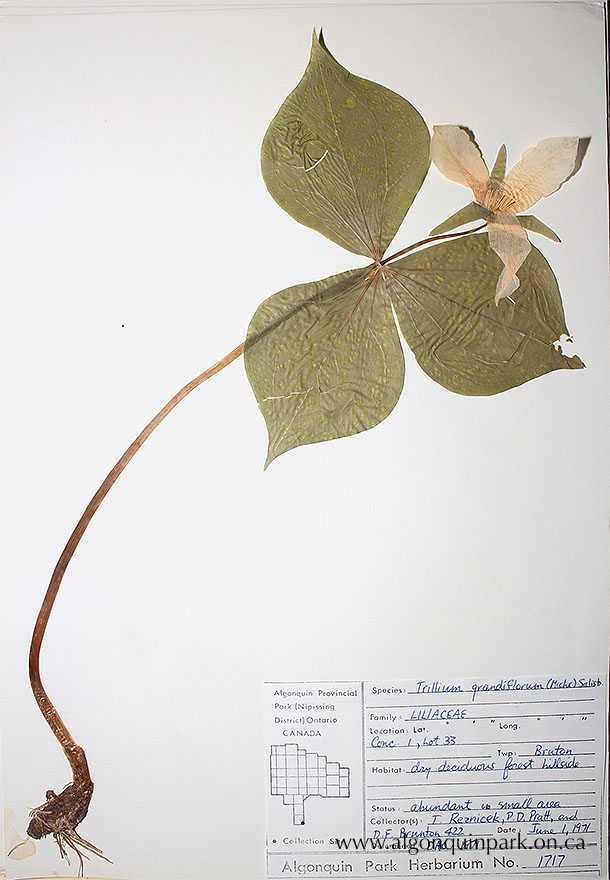
Image: Herbarium record #1717, Large White Trillium (Trillium grandiflorum). Collected June 1, 1971.
16. At the Algonquin Logging Museum you are invited to walk through history! The 1.5 km trail through time takes visitors through recreated buildings and exhibits showing the square timber days up to contemporary forestry techniques. The buildings are brought to life each year through programming at the annual Loggers Day event held on the last Saturday of July.
17. The Friends of Algonquin Park funds APPAC’s online database and digitization efforts to preserve and share its historical resources. Over 17,000 photographs, artifacts, and records are searchable online. More documents and photographs are added each year as work continues to make the collection accessible to researchers far and wide.
18. Who would use a chalkboard in Algonquin Park? Schoolchildren of course! Small communities grew around railroad stations and lumber mills in Algonquin Park. These families often had young children who attended small one-room schools and enjoyed the experiences offered by the Park’s environment when not following along with their teacher’s lessons.
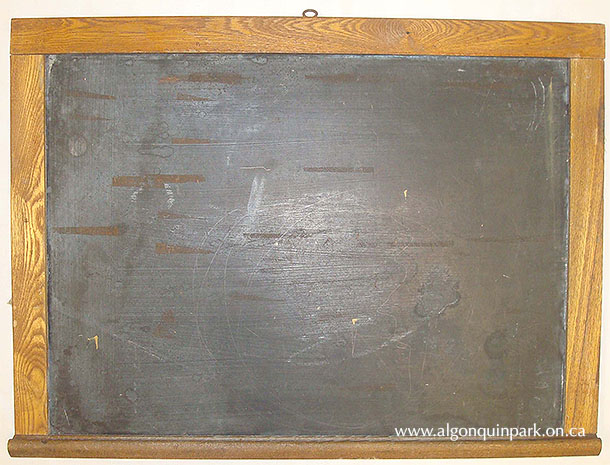
Image: A small chalkboard, 61.2 cm x 45 cm x 4 cm, used at the Cache Lake Schoolhouse, c. 1940s. APPAC, 2015.15.1.
19. Today’s visitors come to Algonquin Park in hopes of spotting a moose, but up until the 1960s, White-tailed Deer were the popular roadside attraction, even advertised on postcards. First fed from scraps at the Highland Inn, deer in the Cache Lake area were later attracted to any slowing car on Highway 60 with hopes of an easy snack. In the 1960s, the moose population would begin to outrank the deer population as the ban on hunting wolves restored the prey-predator relationships in the ecosystem.
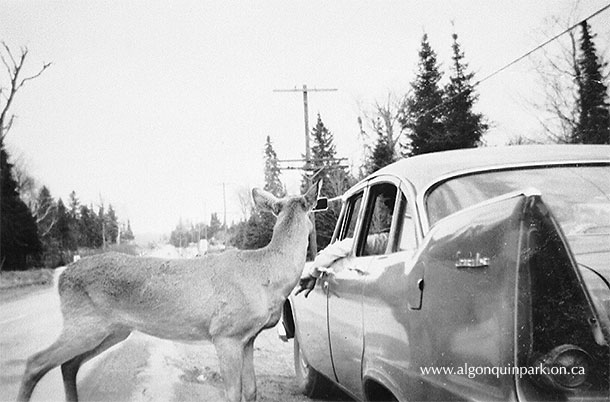
Image: A White-tailed Deer being fed from a car along Highway 60, 1957. APPAC, APM 2922, J. Kuiack.
20. Not only do APPAC’s holdings record Algonquin Park’s history, they also show the changes in technology over the decades. Whether it’s film reels to VHS tapes to DVDS or glass negatives to film negatives to digital images, the ways visitors capture and record their experiences in the Park has varied greatly. No matter the method, the desire to capture these memories remains constant. For APPAC staff, this evolution of technology means they need to consider a variety of storage conditions and digitization techniques for each unique object.
21. More visitors means more trash! It’s an inevitable conundrum for backcountry camping. Campers were, and still are, encouraged to handle their garbage respectfully. This litter bag, with its humorous cartoon of an angry moose watching a camper toss a can in its direction, contains a list of instructions on the flip side for the campers. Today’s modern can and bottle ban is a further initiative to help campers follow the “Leave No Trace” philosophy.
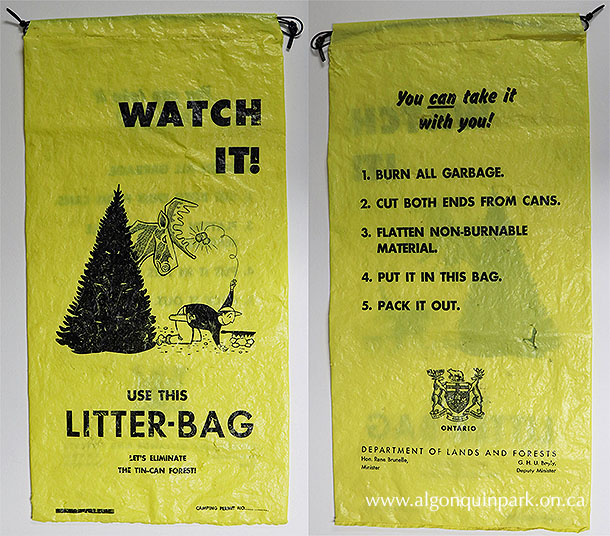
Image: A plastic “litter-bag” with a drawstring produced by the Department of Lands and Forests. From the Minister listed, the bag dates to c. 1966 - 1972. APPAC, 2024.27.2.
22. APPAC doesn’t only collect the past! Staff are actively recording and collecting the photographs and stories that will be Algonquin Park’s history in the next 100+ years. Whether it’s photographing changes to Park buildings, making note of updates to invasive species, recording oral history interviews, and more, staff make sure to keep an eye on the history of tomorrow. What part will you play in Algonquin Park’s history?
Learn More
Learn more about the Algonquin Provincial Park Archives & Collections
- Explore the online database of photographs, archival records, and artifacts.
- Contact the Collections Coordinator to schedule a research appointment or discuss a donation.
- Read more by purchasing historical publications in The Friends of Algonquin Park’s bookstore.
- Support the Archives with a financial donation via The Friends of Algonquin Park, a Canadian registered charity, to assist us in protecting Algonquin Park's cultural heritage for future generations.
April 4, 2025
Algonquin Park Connections
 Our connection to Algonquin Park is often multigenerational. Whether it’s a youth camper following in the footsteps of their alumni parents, a line of leaseholders caring for their family's cottage, or visitors enjoying their annual backcountry or campground traditions, the love and support for Algonquin Park runs deep. Same is true for the generations of families that have worked to produce the Park we know today.
Our connection to Algonquin Park is often multigenerational. Whether it’s a youth camper following in the footsteps of their alumni parents, a line of leaseholders caring for their family's cottage, or visitors enjoying their annual backcountry or campground traditions, the love and support for Algonquin Park runs deep. Same is true for the generations of families that have worked to produce the Park we know today.
Last time we featured letters and postcards from the collection of Ranger William Hughes in the Algonquin Provincial Park Archives & Collections (APPAC; Archives). This same family’s donation highlights the multigenerational connection through the inclusion of photographs of the construction of Highway 60, from the collection of Norman W. Gurr. But you may wonder, how are the two men related?
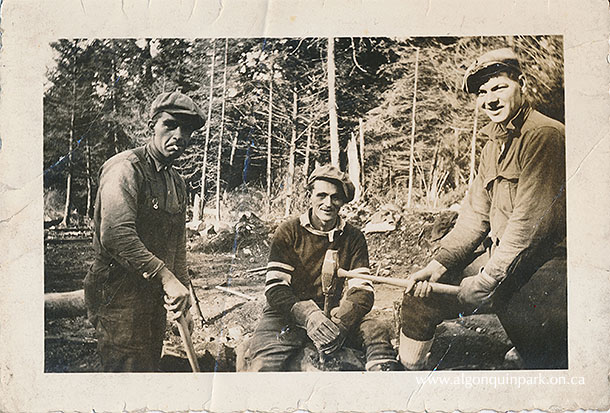
Image: Three Highway 60 construction workers posing with rock drilling tools, c. 1934 – 1936. The man in the middle holds a metal drill while Norman W. Gurr hits it with a sledgehammer. The holes would be filled with charges for blasting with dynamite. APPAC, 2021.18.37. Estate of Janet Ivel (Hughes) Gurr.
Among William Hughes’ siblings was James Hughes. Remember last time when I said William Hughes married Charlotte Green? Well, his brother James married Ellen Green. It wasn’t uncommon at this time and in small communities for multiple members of two families to be connected. As such, Charlotte and Ellen were also sisters. Of James and Ellen’s children, their daughter, Janet Jessie Ivel Hughes, married Norman W. Gurr, providing the familial connection we observe in this donation.
 |
Make a charitable donation to assist us in preserving Algonquin Park's cultural heritage for future generations. |
The Archives is fortunate to contain a collection of photographs and records related to the construction of Highway 60, c. 1934 – 1936, from the gifts of many donors. Most of the images showcase the construction itself and life at the construction camps, especially the camp that was situated at Lost (now Found) Lake. Although there were 7 camps located along the route, the majority of the images come from this one. You trace the men’s footsteps when using the parking lot at the Algonquin Art Centre today.
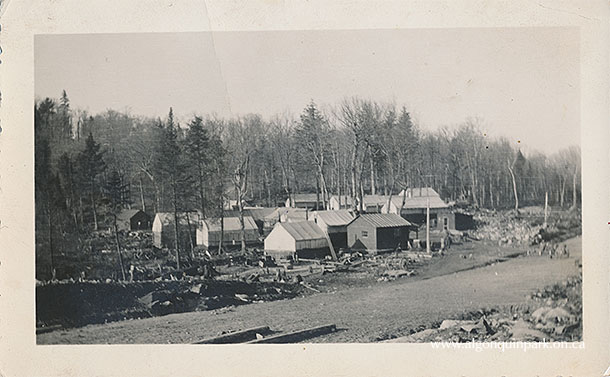
Image: Highway 60 construction camp at Lost (Found) Lake, c. 1934 – 1936. APPAC, 2021.18.40. Estate of Janet Ivel (Hughes) Gurr.
Norman W. Gurr’s photograph collection adds to our understanding of the life and work of the road crews. Images from the camps show an elaborate Superintendent’s shack, a dining tent, “spring cleaning”, horse stables, and good old-fashioned entertainment – lively games of horseshoes on the highway itself.
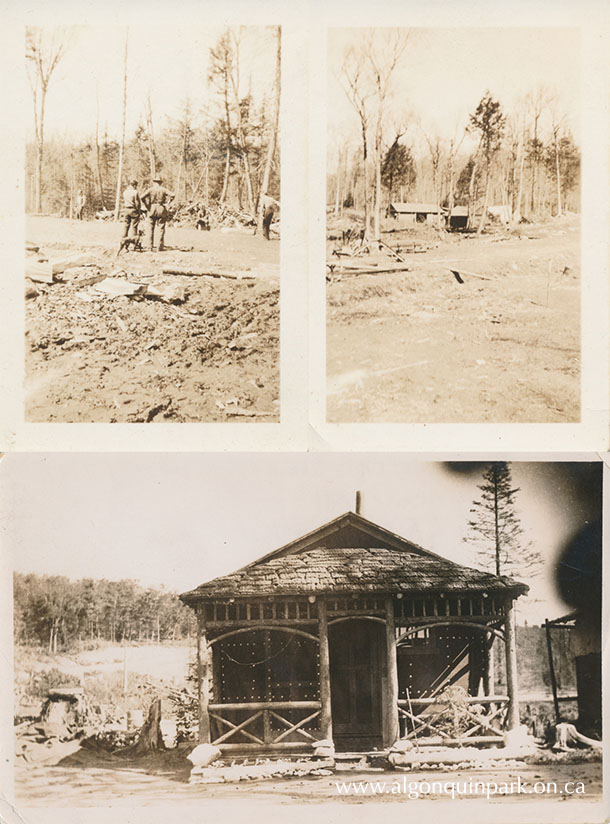
Image (clockwise from top left): Road Crew Superintendent watching a game of horseshoes (note the dog behind him); stables; Superintendent’s shack at Found Lake (note Highway 60 climbing the hill around the lake in the background). c. 1934 – 1936. APPAC, 2021.18.32, 28, 53. Estate of Janet Ivel (Hughes) Gurr.
In Algonquin Park: A Place Like No Other by Rory MacKay, the chapter “Picks and Shovels Was All We Had” provides an excellent summary of the political & Park decision-making for the road’s construction and the toil of its workers. Drawing upon oral history interviews held by the Archives, the worker’s efforts to clear the route of trees, hand-drill holes in rock, blast them with dynamite, pile the debris on sleds, drag them away by horse, and level and fill hills & holes by wheelbarrow (!) are well described. The images bring these stories to life.
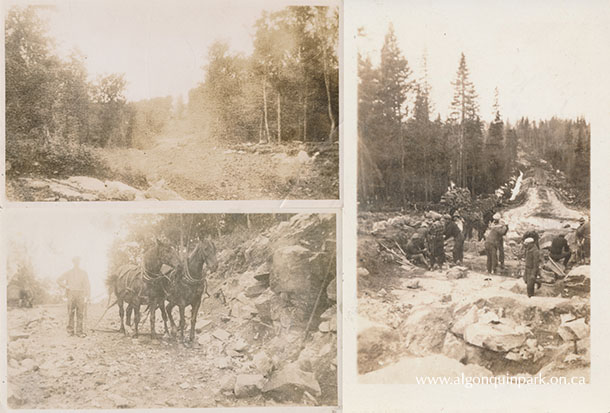
Image (clockwise from top left): “The explosion”; the blurred appearance of the image is likely the resulting debris and dust from a dynamite blast; men and horses stand on a road construction project which extends in the distance (note the pile of logs on the left bank in the background created by clearing the route of trees); J. Harrington and team of horse on a road construction project. c. 1934 – 1936. APPAC, 2021.18.52, 36, 54. Estate of Janet Ivel (Hughes) Gurr.
The images with ink captions or identifiable content can be easily described in APPAC’s database as depicting the construction of Highway 60. For others without information, it’s a little more difficult, but from the context of the collection, we can say they appear to be associated with the same event. However, one image is quite odd. In this image “Val. Rose” stands on a large boulder holding a jack hammer. The air hose is seen running out of the frame on our right.
Why is this image odd? The descriptions of the construction of Highway 60 are always that the work was done by hand – wheelbarrow, shovel, sledgehammer … but not with power tools. Was this image (and perhaps then maybe others) taken at a different construction site? Does it show one of the exceptions where Highway 60 work was carried out by a construction company? Or were there some instances of power tools used by men of the Park’s construction camps? The image remains a curiosity.

Image: "Val. Rose and the Jack Hammer." APPAC, 2021.18.55. Estate of Janet Ivel (Hughes) Gurr.
Descendants of the Hughes and Gurr families enjoy a multigeneration connection to Algonquin Park through their relation to both a Park Ranger and a Highway 60 construction worker, but that is likely just the tip of the iceberg. There are many ways each of us finds relation to Algonquin Park. Take a moment to reflect on your own connection, not only the past but also the future. How will you share your passion for Algonquin Park with friends and family? What traditions and stories can you create for them to cherish for years to come?
Learn More
Learn more about the Algonquin Provincial Park Archives & Collections
- Explore the online database of photographs, archival records, and artifacts.
- Contact the Collections Coordinator to schedule a research appointment or discuss a donation.
- Read more by purchasing historical publications in The Friends of Algonquin Park’s bookstore.
- Support the Archives with a financial donation via The Friends of Algonquin Park, a Canadian registered charity, to assist us in protecting Algonquin Park's cultural heritage for future generations.
March 20, 2025
Words from the Past
 Historical letters from respected figures or celebrities can leave the modern reader with a sense of awe at seeing the handwriting and words of such a notable person. Once the feeling subsides, today’s reader can begin to appreciate the time in which the letter was written and the wealth of historical context it contains.
Historical letters from respected figures or celebrities can leave the modern reader with a sense of awe at seeing the handwriting and words of such a notable person. Once the feeling subsides, today’s reader can begin to appreciate the time in which the letter was written and the wealth of historical context it contains.
Take for example a collection of letters and postcards at the Algonquin Provincial Park Archives & Collections (APPAC; Archives) which belonged to William Hughes, Park Ranger from 1910-1920. Most of the letters come from the pen of George W. Bartlett, Superintendent from 1898-1922. It is hard not to get swept up in the Algonquin National Park of Ontario letterhead and the flowing cursive, or the purple-blue ink of the typewriter. But once you sit down to the words, the hints and references to Algonquin Park’s history come to light.
![Instructions from Superintendent Bartlett to Ranger Hughes to aid [Ranger] Shields with the search for [Ranger] Becker’s lost canoe, May 24th, 1913. APPAC, 2020.20.1. Estate of Janet Ivel (Hughes) Gurr. Instructions from Superintendent Bartlett to Ranger Hughes to aid [Ranger] Shields with the search for [Ranger] Becker’s lost canoe, May 24th, 1913. APPAC, 2020.20.1. Estate of Janet Ivel (Hughes) Gurr.](../../images/archives-blog-2025-5-09.jpg)
Image: Instructions from Superintendent Bartlett to Ranger Hughes to aid [Ranger] Shields with the search for [Ranger] Becker’s lost canoe, May 24th, 1913. APPAC, 2020.20.1. Estate of Janet Ivel (Hughes) Gurr.
To the original recipient, the letter represented different meanings and emotions. For Hughes, the letters are directives from his boss and provide researchers another glimpse into the work of a Ranger. Often Bartlett is sending instructions to Hughes, notes on shipments of supplies, or even reprimands for spending too much time fishing with Park visitors during peak fire season.
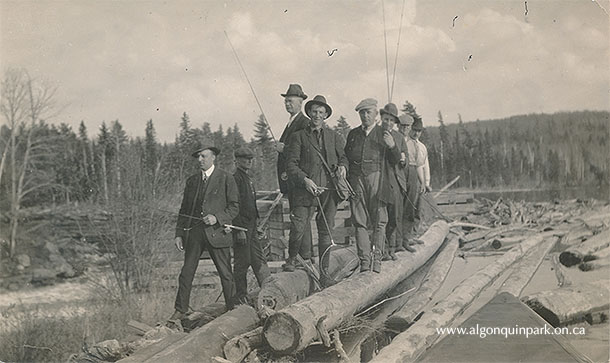
Image: William Hughes, Park Ranger 1910-1920, stands holding a net in the middle of a group of fishermen. Brent, Cedar Lake, c. 1917-1920. APPAC, 2020.20.22. Estate of Janet Ivel (Hughes) Gurr.
We can track where Hughes worked in the Park (his “beats”) through the Superintendent’s letters. At first correspondence is addressed to Hughes at Rock Lake. Later, he is stationed at Basin Depot, and many of the letters around this time reference the financial settlements made to evict “squatters” during the expansion of Algonquin Park’s boundary in 1914. Hughes was instructed to meet with the families and have the settlement documents signed.
Image: Letter from G.A. Bartlett on behalf of Superintendent G.W. Bartlett to Ranger Hughes with instructions to provide a cheque to Mr. Dennis McGuey for settlement on possession of his buildings at Basin Depot, March 18, 1915. The reverse contains a statement written and signed by Dennis McGuey on March 22, 1915. APPAC, 2020.20.13. Estate of Janet Ivel (Hughes) Gurr.
Hughes’ time at Basin Depot ends in 1917 when Bartlett writes to explain the new leases and Park plans at Cedar Lake. He promotes features of the Brent community and asks Hughes if he would consider moving to Cedar Lake as “I have got to have someone there who can write and look after licenses… the [divisional] point is only a half mile down the lake from the depot and there is no doubt this will be an important point so far as Tourists go”. Hughes and his family do move to Cedar Lake, and further letters discuss the arrangements for the move. These letters provide a key role in narrowing down the dates of photographs in this donation, as images from Brent can generally be dated to the later years of Hughes career in Algonquin Park.
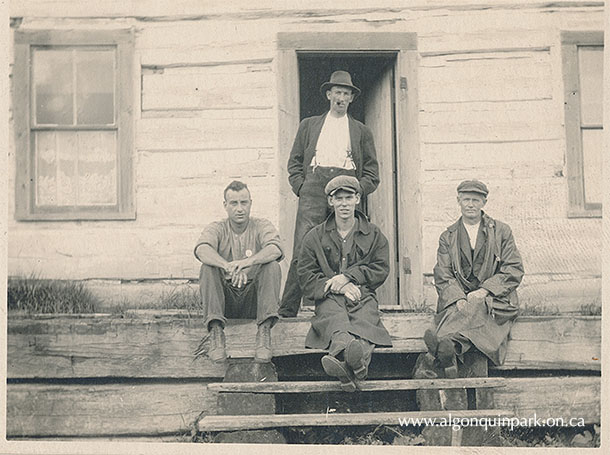
Image: Ranger William Hughes standing behind three men, Brent, Cedar Lake, c. 1917-1920. The others are likely Rangers as well; note the badge on the shirt of the man on the left. APPAC, 2021.18.12. Estate of Janet Ivel (Hughes) Gurr.
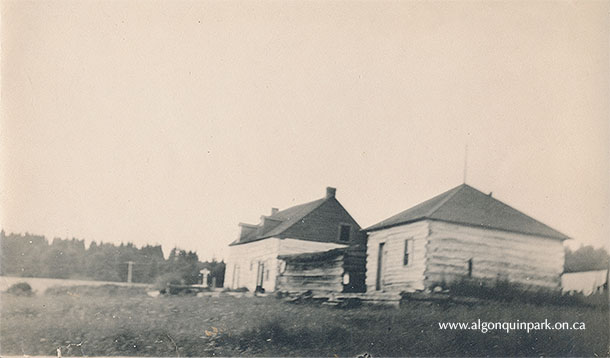
Other letters provide historical hints to the work and life of Superintendent George Bartlett at Park Headquarters on Cache Lake and the general operations of Algonquin Park in this time period. On December 16, 1914, Bartlett writes to Hughes hoping that he will get a lot of wolves this year. At this time, wolves were viewed as a negative presence in the environment and were even referred to as pests. Immense efforts went towards destroying them: deer carcasses filled with poison bait; wire snares; metal traps; and bullets.
Bartlett continues “I want to get a Lynx for my collection see if you can’t get me one they used to be plentiful in that section.” Bartlett is well known for the taxidermy collection he housed in his office, and for his attempts, like other early Superintendents, to populate the Park with various species in hopes of “improving” it. Bartlett introduced animals such as Smallmouth Bass and Wood Grouse. Some species did not survive, while unfortunately others were successful. Smallmouth Bass spread throughout the Park and beyond, with negative impacts on the native Brook Trout populations.

Image: Superintendent Bartlett’s office, Park Headquarters, Cache Lake, featuring a vast collection of taxidermy specimens. APPAC, APM 2992. Photographed by Reuben Sallows, Donated by Ottelyn Addison.
A few months later, on February 16, 1915, Bartlett updates Hughes writing “Nadon sent me a Wolverine or rather a Lynx for my collection it is a very small one though but a nice specimen”. He lets Hughes know that Ranger Wattie recently brought in seven wolves and Ranger Watson, three more, but the other Rangers had been unsuccessful since early in the season when Ranger Callighen had killed two. Hughes is to expect wolf poison bait and snowshoes by mail, and Bartlett remarks off-handedly “It is very quiet here the inn being closed it will not open till June then Miss Lindsay is to run the Inn and the camps.” The reference is made to the Highland Inn and its outpost lodges or “camps”, Nominigan Camp and Minnesing Camp. All were constructed by the Grand Trunk Railway - the Highland Inn in 1908 and the camps in 1913. It’s incredible such brief letters can provide so many hints into how the Park was in the 1910s.
On a more personal note, the collection includes postcards, one of which Hughes mailed to Miss Lottie Green on October 16, 1910, in the first year of his employment as a Park Ranger. On the front we see an image of a man and a woman standing on a rock in front of a Ranger Cabin. The man holds a fish in one hand and a fishing rod in the other. Perhaps these are some of the visitors Hughes was reprimanded for spending too much time fishing with.
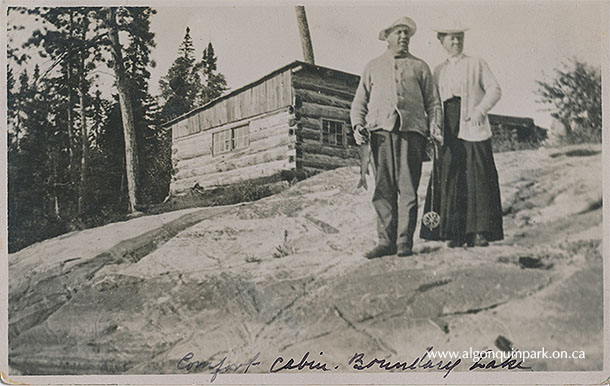
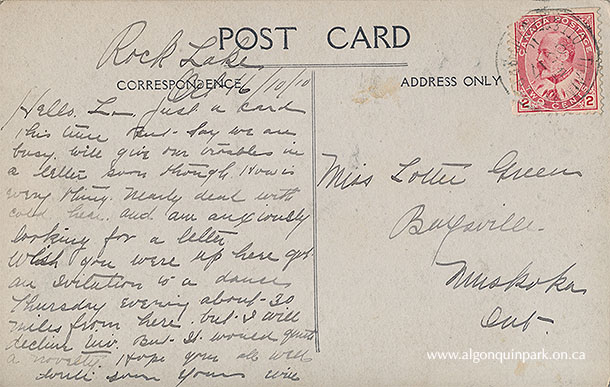
Image: Postmarked postcard sent to Miss Lottie Green from Ranger William Hughes; reverse message written October 16, 1910. The image is captioned “Comfort cabin. Boundary Lake”. Boundary Lake is now known as Harness Lake and is located west of Rock Lake. The lake was previously named for its location on the southern boundary of the Park, as it was at that time. APPAC, 2021.18.89. Estate of Janet Ivel (Hughes) Gurr.
Hughes writes a short note from Rock Lake, promising a letter to Lottie soon. He laments the cold weather, saying he is nearly dead with it. I wonder how he felt when true winter set in. He anxiously awaits a letter from her as he wishes she was there. He received an invitation to a dance Thursday evening about “30 miles from here” (perhaps at the Highland Inn or in Whitney, Ontario). He signs off “Will”.
William Hughes and Charlotte would later marry in June 1912. The postcard provides a glimpse of the life and emotions of a new Ranger. Altogether, these letters and postcards show how a few words from the past can provide so much insight to the history and people of Algonquin Park.
Learn More
Learn more about the Algonquin Provincial Park Archives & Collections
- Explore the online database of photographs, archival records, and artifacts.
- Contact the Collections Coordinator to schedule a research appointment or discuss a donation.
- Read more by purchasing historical publications in The Friends of Algonquin Park’s bookstore.
- Support the Archives with a financial donation via The Friends of Algonquin Park, a Canadian registered charity, to assist us in protecting Algonquin Park's cultural heritage for future generations.
February 19, 2025
Capture the Flag!
Sixty years have passed since the red and white maple leaf design was officially adopted as the Canadian Flag on February 15, 1965. That same year, Ontario also adopted its official flag, a variation of the Red Ensign.
In 1945, the Red Ensign was the flag authorized for use in Canada until an official flag was adopted. However, the history of Canada’s flags is long and varied, with the British Union Flag and the Canadian Red Ensign being used in various designs, times, and places.
 |
 |
 |
| Canadian Flag | Red Ensign Flag | British Flag |
Flags are captured in predictable and unexpected ways throughout the Algonquin Provincial Park Archives & Collections (APPAC; Archives). In written records, we find reference in Park rules and regulations. 1920s and 1930s booklets titled "Regulations Respecting Algonquin Provincial Park Ontario, by the Government of Ontario", contain a specific statement on flags:
“If any flag is at any time flown or displayed in the Park, it shall be the British Flag”.
This regulation was upheld by Fred Cook and his comrades when they decided to fly a flag on their camping trip in the early 1910s, as shown in an album held by Library and Archives Canada.
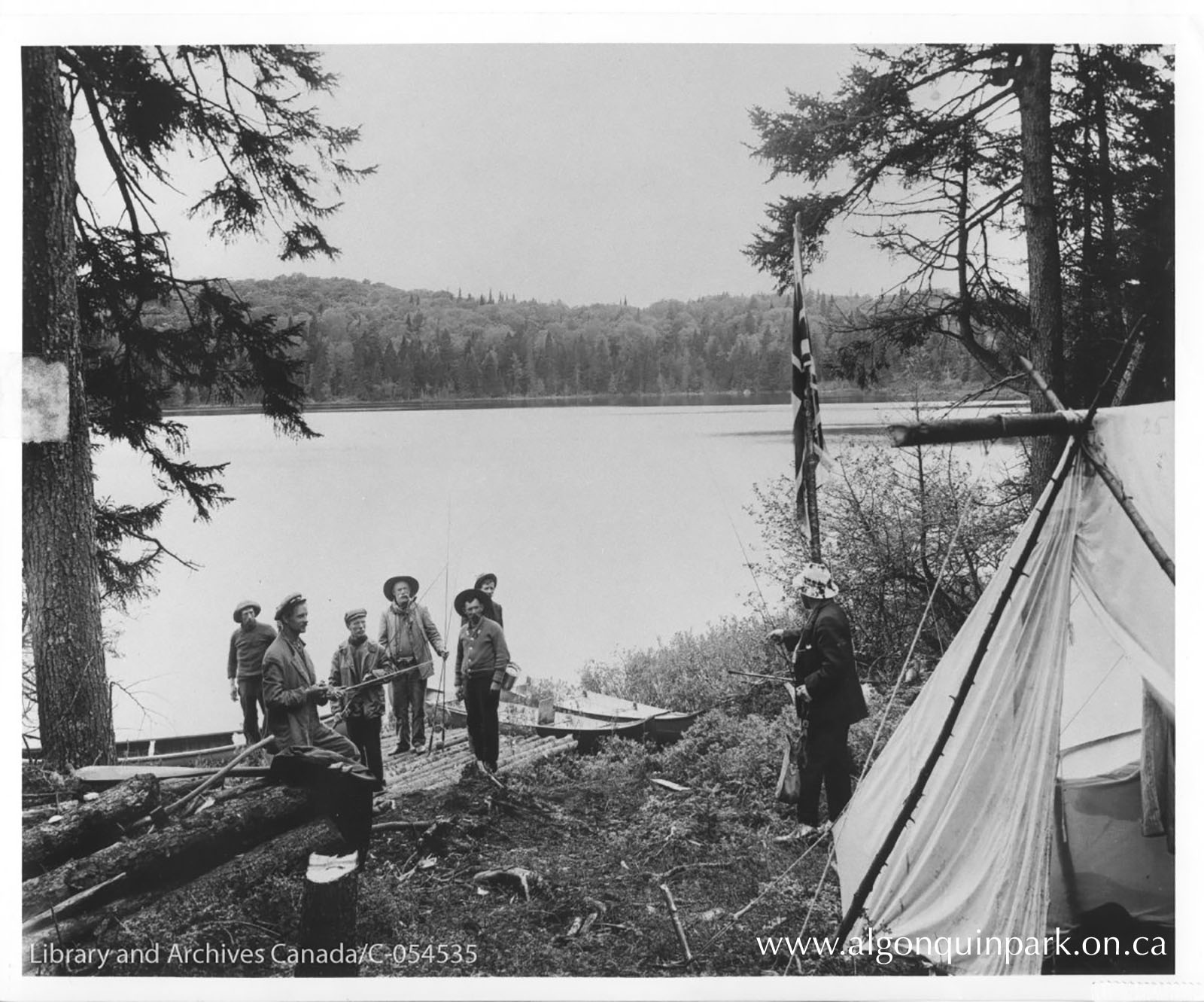
Image: A fishing party stands on a landing by a lake. Fred Cook raises the Union Flag at their campsite. Library and Archives Canada/C-054535.
Park Rangers were responsible for enforcing Algonquin Park’s regulations as part of their duties. They were also required to keep a daily journal. Mark Robinson’s diaries, held at Trent University Archives, are one of the most detailed surviving records of the life and work of a Park Ranger (later Chief Ranger and Superintendent). His diaries provide a glimpse into how the enforcement task included flags.
On Friday, August 19, 1910, he wrote: "Found Mr. Bletcher flying Stars and Stripes. I asked him to take them in. He did so."
 |
American Flag |
He writes again on Sunday, August 21, 1910: " Mr. Bletcher hung out Stars and Stripes this morning. I was told many amusing things when I was informed it was with Supt's [Superintendent's] orders. I could only allow it, etc." (Trent University Archives, 97-011, Donated by the Addison Family).
The Bletchers were an American family who had a leasehold on Canoe Lake, and it is understandable why Mr. Bletcher wanted to fly the American flag from his flagpole. Flags are a symbol of identity, pride, and allegiance, and they are respected objects to this very day. However, under Algonquin Park’s regulations, only flags representing the Government’s identity were allowed.
APPAC’s holdings of photographs and postcards show flags flown at various Park buildings including Park Headquarters, Entrance Gates, Smoke Lake Hangar, and some Ranger Cabins. Private individuals such as leaseholders and lodges also flew flags. It seems both the Union Flag and the Red Ensign were acceptable by the Park’s regulations.
Image: Postcard of Park Headquarters at Cache Lake, pre-1913. A flagpole is situated prominently in the grounds near the Superintendent house and staff house. APPAC, 2023.3.69, From the Collection of Don Beauprie.
Image: Aerial photograph of the Highland Inn and Algonquin Park Station, Cache Lake. Note the two flag poles, one at the bottom left on the edge of Park Headquarters. The other, atop the Highland Inn itself. APPAC, APM 753, Yascovitch.
Image: The Red Ensign is visible flying from the flagpole at this cottage on the Pirie leasehold, Gilmour Island, Canoe Lake, c. 1925 – 1930. APPAC, 1977.18.7, Lewis.
In the time when an image was taken, the flag was a symbol for those who flew it. Today, that same flag can play a different role for the Archives.
Take for instance this postcard of the “Entrance to Algonquin Park” by Fry’s Photo Shoppe in Gravenhurst, Ontario. The image shows visitors entering and leaving Algonquin Park’s West Gate, but the image has no date.
Image: Postcard of Algonquin Park’s West Gate, by Henry Fry, Fry’s Photo Shoppe. APPAC, 2024.24.1.
 |
Make a charitable donation to assist us in protecting Algonquin Park's cultural heritage for future generations. |
From the vintage of the cars, we can begin to guess when it might have been captured, but other clues help us narrow the range. We know the West Gate complex was opened in 1953, providing us with a potential first date for the image. But when was the latest it could have been taken?
Here we turn to the flagpole. The blue, red, and white of the Union Flag is unmistakeable. Since we know our national and provincial flags were adopted in 1965, the image could be taken no later than this year.
Museum and archives staff often find little ways to help them understand the mysteries in their collections, but what can you do to help your archivist or your descendants?
Take a moment to record what you know or remember about the history of an item. The date, identities of individuals, place, and context are incredibly helpful to future generations. You can write captions on the back of items (press softly) or create notes to accompany them.
Archives and museum staff appreciate all donations, and the thrill of solving a mystery about an unknown image or person can be exciting, but even more so is being able to care for and preserve as much information as we can for years to come.
Today at Algonquin Park’s West Gate, the Ontario and Canadian flags fly high from the flag poles to greet visitors. Perhaps when you see them, you will remember these images and the roles flags play in the representation of our identities. What are the flags that have special meaning in your life? How have you captured them in your photographs and memories to be shared with generations to come?
Learn More
Learn more about the Algonquin Provincial Park Archives & Collections
- Explore the online database of photographs, archival records, and artifacts.
- Contact the Collections Coordinator to schedule a research appointment or discuss a donation.
- Read more by purchasing historical publications in The Friends of Algonquin Park’s bookstore.
- Support the Archives with a financial donation via The Friends of Algonquin Park, a Canadian registered charity, to assist us in protecting Algonquin Park's cultural heritage for future generations.
February 12, 2025
A Romantic Winter in Algonquin Park
 Winter in Algonquin Park is a magical and romantic season. Fresh snowfall graces the boughs of evergreen trees. Pillars of ice defy gravity. Wind sweeps across frozen lakes and rivers. Snow crunches underfoot. Birds chirp and wings flutter. Snow crystals glitter across the hills. The sentiments we express today about this enchanting season are in many ways similar to those who enjoyed the snow and ice of 100 years ago.
Winter in Algonquin Park is a magical and romantic season. Fresh snowfall graces the boughs of evergreen trees. Pillars of ice defy gravity. Wind sweeps across frozen lakes and rivers. Snow crunches underfoot. Birds chirp and wings flutter. Snow crystals glitter across the hills. The sentiments we express today about this enchanting season are in many ways similar to those who enjoyed the snow and ice of 100 years ago.
Even honeymooners visited the winter landscape of Algonquin Park. On January 17, 1922, guests attended the wedding of Mr. Alfred William Eustace vanSomeren and Miss Jessie Rogers Crompton at the Brantford Avenue Church in Brantford, Ontario. A newspaper clipping describes the programme of the event, attendees, and the wedding party’s attire. After a reception at the home of the bride’s father, “the bride donned her travelling costume” and “Mr. and Mrs. vanSomeren left to spend a honeymoon at Algonquin Park”.
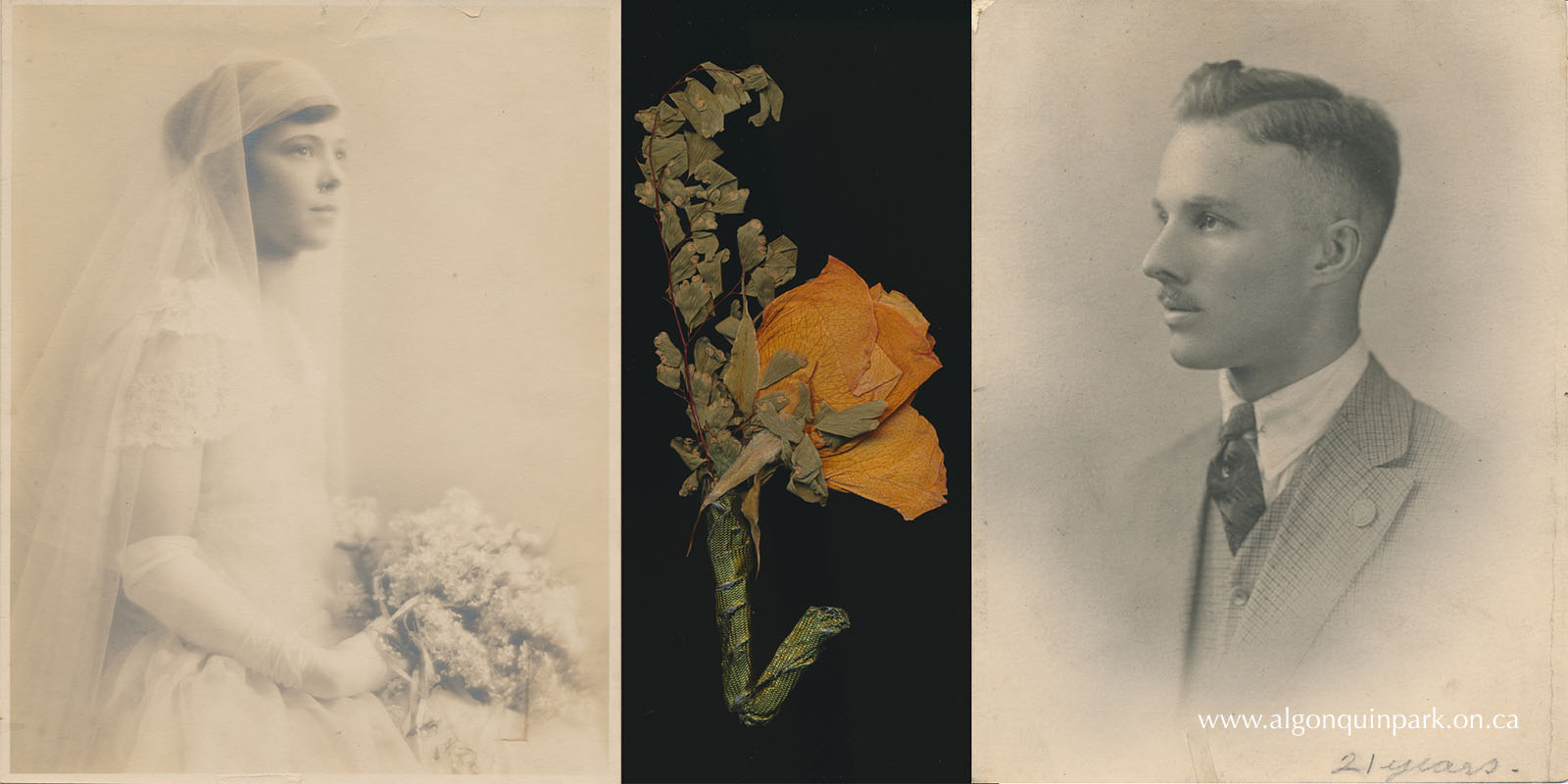
Image (Left to Right): Portrait of Jessie Rogers Crompton in her wedding attire holding a bouquet; Alfred vanSomeren’s boutonniere made with a rose, now dried to a yellow/orange colour, and green foliage, contained in an envelope with his handwriting “My Wedding Flower Jan. 17th 1922”; portrait of Alfred vanSomeren at age 21, a few years before his wedding day. APPAC, 2022.4.13-15. Donated by Pam Garratt Dunlop on behalf of the vanSomeren Family.
At this time, visitors travelling to Algonquin Park relied on train service on two rail lines which passed through the Park – one in the north and one in the south. The vanSomerens were destined for a stay at the Highland Inn, the largest and perhaps most well-known of Algonquin Park’s lodges. Coming from southern Ontario, the newlyweds travelled from Toronto with the Grand Trunk Railway System, arriving at Algonquin Park Station, Cache Lake on January 18, 1922.
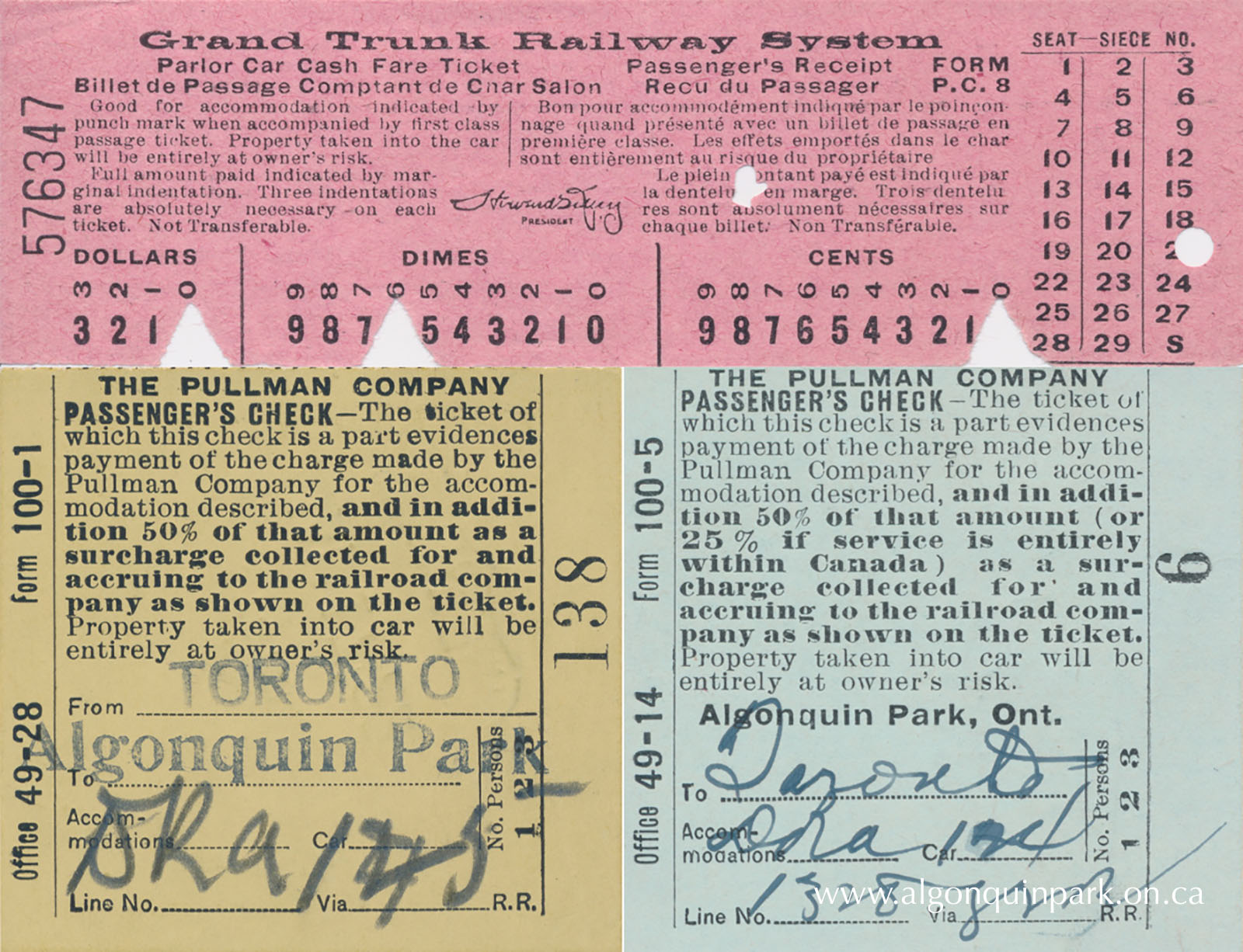
Image: Ticket stubs from the vanSomeren’s travel on the Grand Trunk Railway System from Toronto, Ontario to Algonquin Park, January 17th and return on January 28th, 1922. APPAC, 2022.4.7, 9, 10. Donated by Pam Garratt Dunlop on behalf of the vanSomeren Family.
Built in 1908 by the Grand Trunk Railway System, the Highland Inn was one of only a few that welcomed guests during winter. As part of their marketing to sell Canadians and Americans on a prospective stay at the lodge and travel on their rail cars, The Grand Trunk Railway System produced promotional booklets such as a 1921-1922 issue titled “Enjoy Winter in Ontario Highlands: Algonquin Park Ontario Canada”. This 15-page booklet uses photographs and poetic descriptions to describe the experiences one could expect during their visit and the benefits they could enjoy from the winter destination.
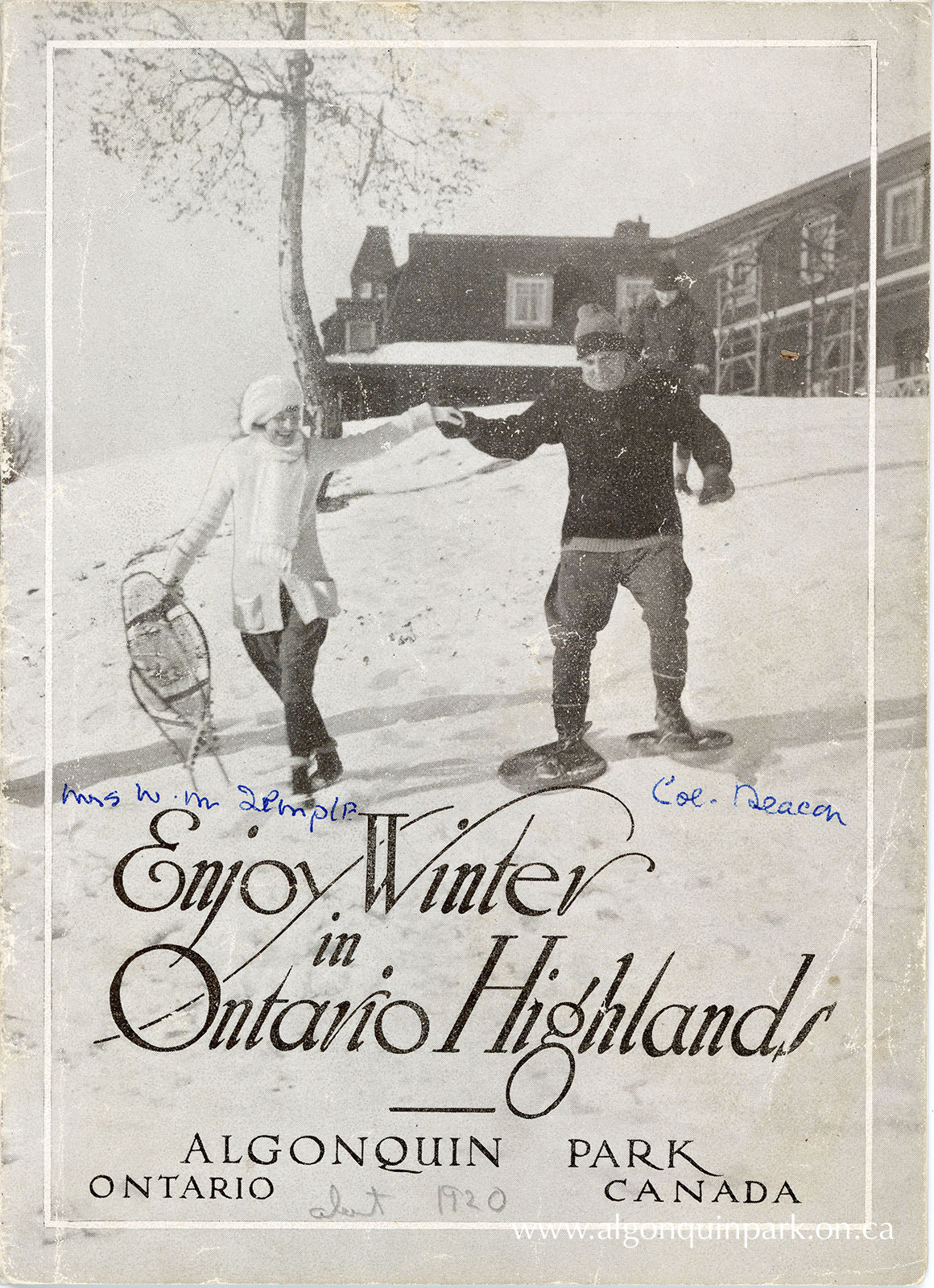
Image: Cover of “Enjoy Winter in Ontario Highlands: Algonquin Park Ontario Canada”, 1921-1922 by the Grand Trunk Railway System. A previous owner has used pen to identify the individuals pictured. APPAC, 1977.9.1.1, From the Collection of Dr. Duncan A. MacLulich, Donated by M.A. Capstick.
At the time of the booklet, the Highland Inn has been recently renovated and could accommodate 150 people with advertised amenities including plumbing, steam heat, and electric light. Rates of stay, with meals for a week, ranged from $30 - $42 per person depending on the style of the room and number of guests. In addition to sleeping rooms, lounging rooms, and the dining room (where “cuisine is a matter of special attention”), guests could enjoy a writing room, billiard room, and music room.
The vanSomerens’ bill for their stay from January 18 to 28, 1922, totaled $115.70. Their receipt shows the rate for their stay, and additional items they purchased including two lunches (perhaps for snowshoe tramps – see below), playing cards, cigarettes, and telegram service. Today, their bill would equal approximately $2,000. At first glance that price does not seem unreasonable for two adults to stay 10 days with meals included. However, we must remember the time period and that the amount of money spent was quite an extravagant purchase.
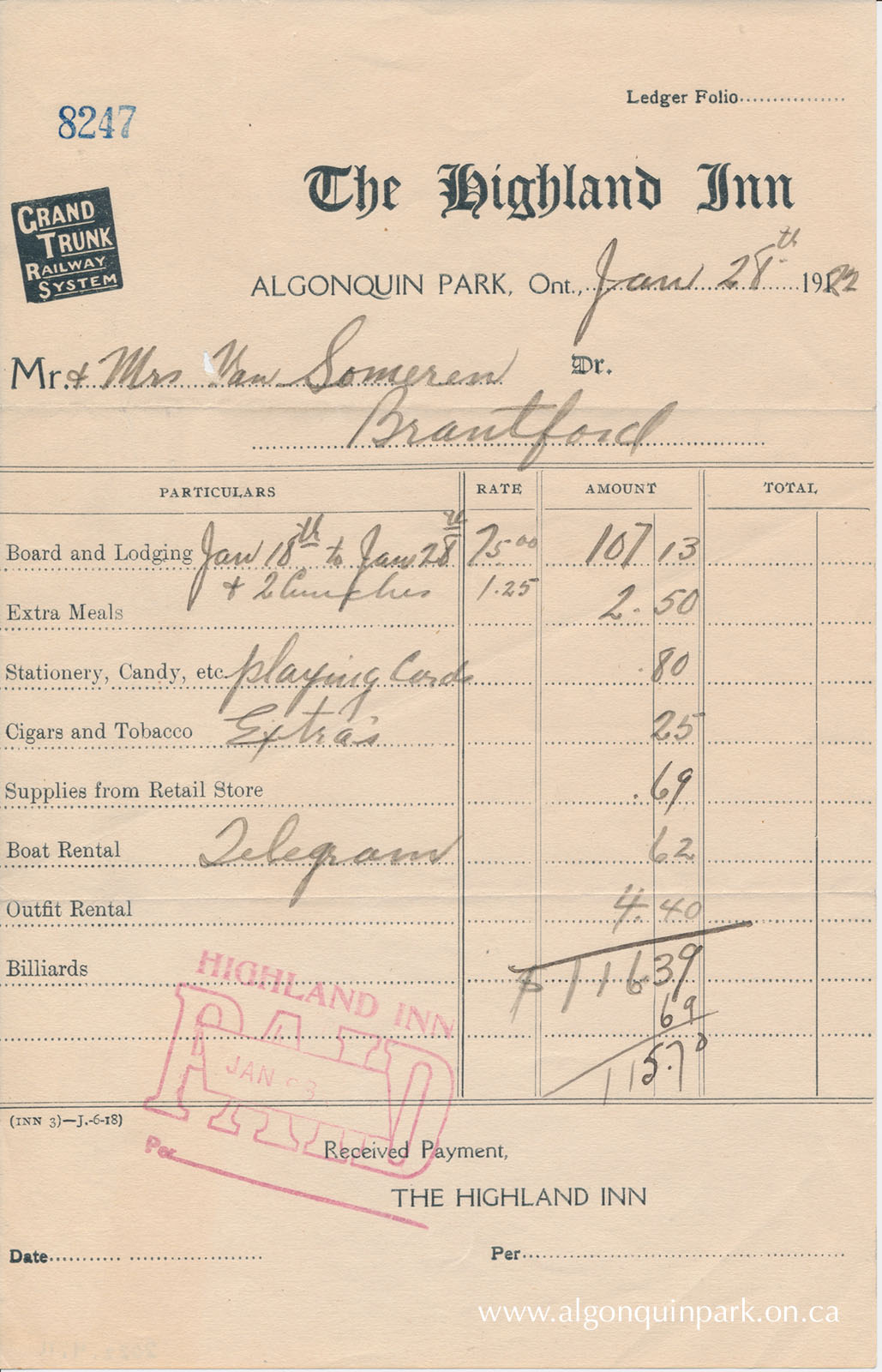
Image: The Highland Inn bill issued to Mr. and Mrs. vanSomeren for their stay from January 18 to 28, 1922. The paper is stamped Paid. APPAC, 2022.4.11. Donated by Pam Garratt Dunlop on behalf of the vanSomeren Family.
A stay at the Highland Inn was advertised as having all the first-class comforts of hotel service while providing the atmosphere and familiarity of the home. The booklet describes and promotes the benefits of visiting Algonquin Park made possible by staying with their lodge. Emphasis is placed on guests’ enjoyment of a wide range of winter sports for which Canada is well known, and the proposed health benefits of the climate and wilderness. At the time, clean air, thought to be purified by pine and balsam forests, was advised as treatment for tuberculosis patients and widely promoted for encouraging people to experience the outdoors. Promotion for the Highland Inn made sure to state that no cases of tuberculosis would be received, likely hoping to instill a sense of safety in prospective visitors.
Guests interested in wildlife, photography, and social camaraderie found inspiration to visit through descriptions of wildlife encounters, animal tracks, group outings, and social activities. A “testimony” from a Toronto businessman shares how it had been one of his most enjoyable and beneficial holidays, far better in bringing him “back to normal” than travelling to southern destinations: “Not forty-eight hours had passed before I felt the wonderous effect of the air: the scent of the balsam, pine, spruce and hemlock” … I have commenced to show the results of my holiday in ruddy cheeks, sound sleep and increased weight. I could not believe that a week here could possibly work such changes in my health and outlook.”
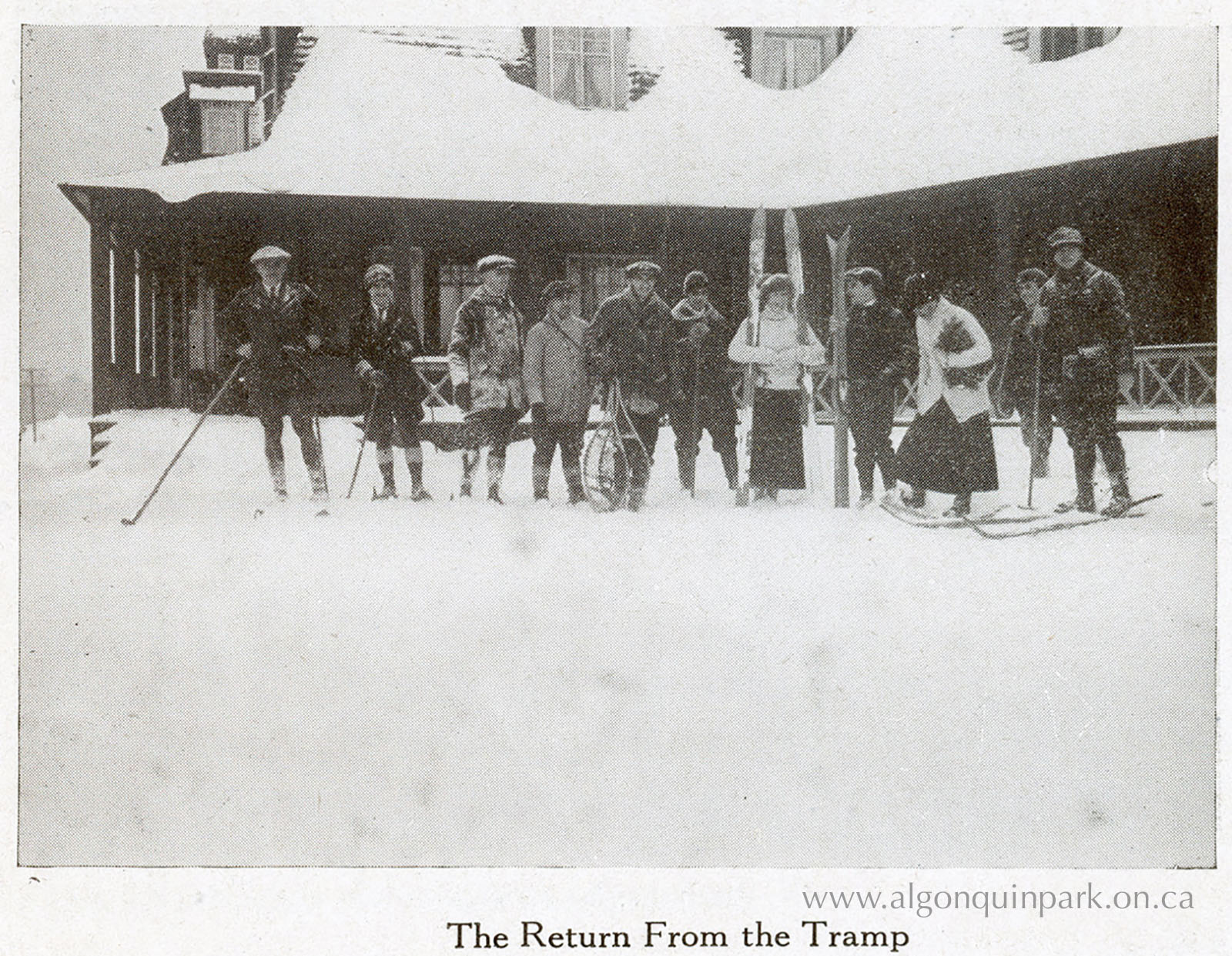
Image: Guests stand outside the Highland Inn in winter clothing with snowshoes, skis, and poles. “The Return From The Tramp”, in “Enjoy Winter in Ontario Highlands: Algonquin Park Ontario Canada”, 1921-1922. APPAC, 1977.9.1.1, From the Collection of Dr. Duncan A. MacLulich, Donated by M.A. Capstick.
 |
Work in the Algonquin Provincial Park Archives and Collections this summer. Apply today! |
What winter experiences did the vanSomerens and other guests enjoy during their stay? Both men and women participated in three hour or longer snowshoe tramps wearing sweaters, wool caps, and stocking-filled moccasins. For prospective guests concerned about the cold temperatures, the booklet claimed that “no matter how cold it is, the man with a sweater never suffers discomfort”. Lunch could be enjoyed back at the Inn, or picnic lunches in the forest could be arranged by the hotel manager. Snowshoe excursions even took place at night, and are romantically described in the booklet:
“But at night, with the moonlight that is found alone in the north, the trails across the lakes and around the island beckon irresistibly. The dead silence, the undimmed glamor of the moon, the crisp crunch of the snow under the raquette, the tingle of the frost in the veins, the merry shouts of the line before and behind, are delights to be dreamt of long after the holiday is over.”
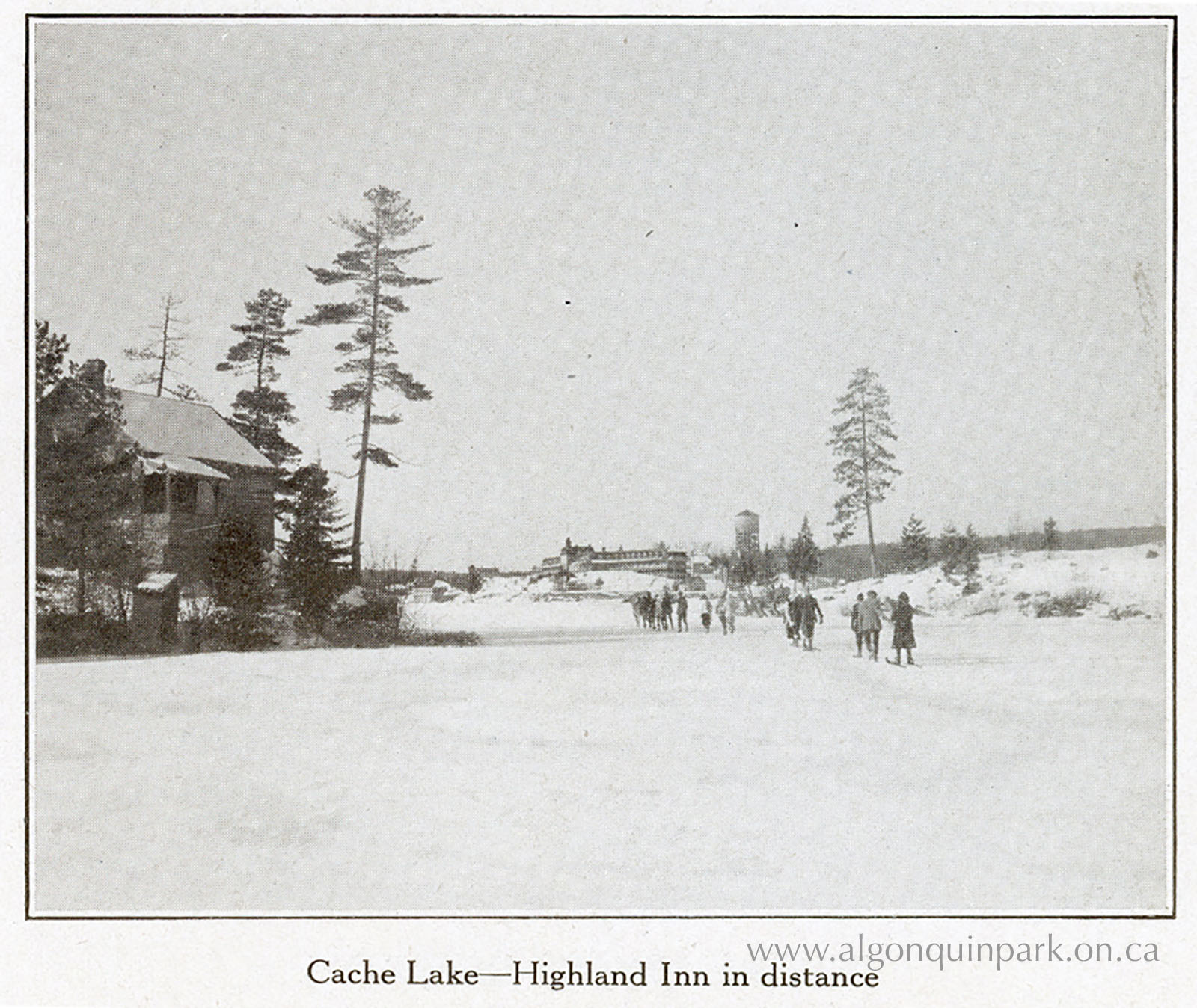
Image: A line of guests on snowshoes and skis making their way back to the Highland Inn across the frozen surface of Cache Lake. “Cache Lake – Highland Inn in distance”, in “Enjoy Winter in Ontario Highlands: Algonquin Park Ontario Canada”, 1921-1922. APPAC, 1977.9.1.1, From the Collection of Dr. Duncan A. MacLulich, Donated by M.A. Capstick.
Back at the hotel, thrill seekers could enjoy a toboggan slide with a grade of nearly 150 metres (500 feet) and a total run of about 400 metres (1/4 mile). Cross-country skiers could enjoy several trails designed for various skill levels, including a trail down the slopes of Skymount, known today as the hilltop visited by the Track and Tower Trail. A ski jump was also available, a mere five minutes’ walk from the hotel grounds.

Image: View of the Highland Inn, Winter 1915. The toboggan slide is visible on the far right. At the bottom of the hill below the hotel is Algonquin Park Station and the railroad tracks. APPAC, 1995.1.9, Collection of Harry and Adele Ebbs.
A section of Cache Lake was cleared for ice skating, and guests were requested to bring their own skates. The outfitting store at the Highland Inn provided snowshoes and skis for rental or purchase. A line of winter clothing, including sweaters, coats, moccasins, and toques, was also available for sale.
Ice-fishing was promoted as a recreational activity, a practice that is prohibited in Algonquin Park today as part of its fisheries management. The businessman’s “testimony” describes his success and the large catches which were once permitted in the Park: “We had excellent luck fishing for lake trout through the ice and our trips resulted in thirty-five beauties. It was a novel experience for me, and how good the fried fish, bacon, etc., tasted on the edge of the lake with a big blazing fire to sit beside!”
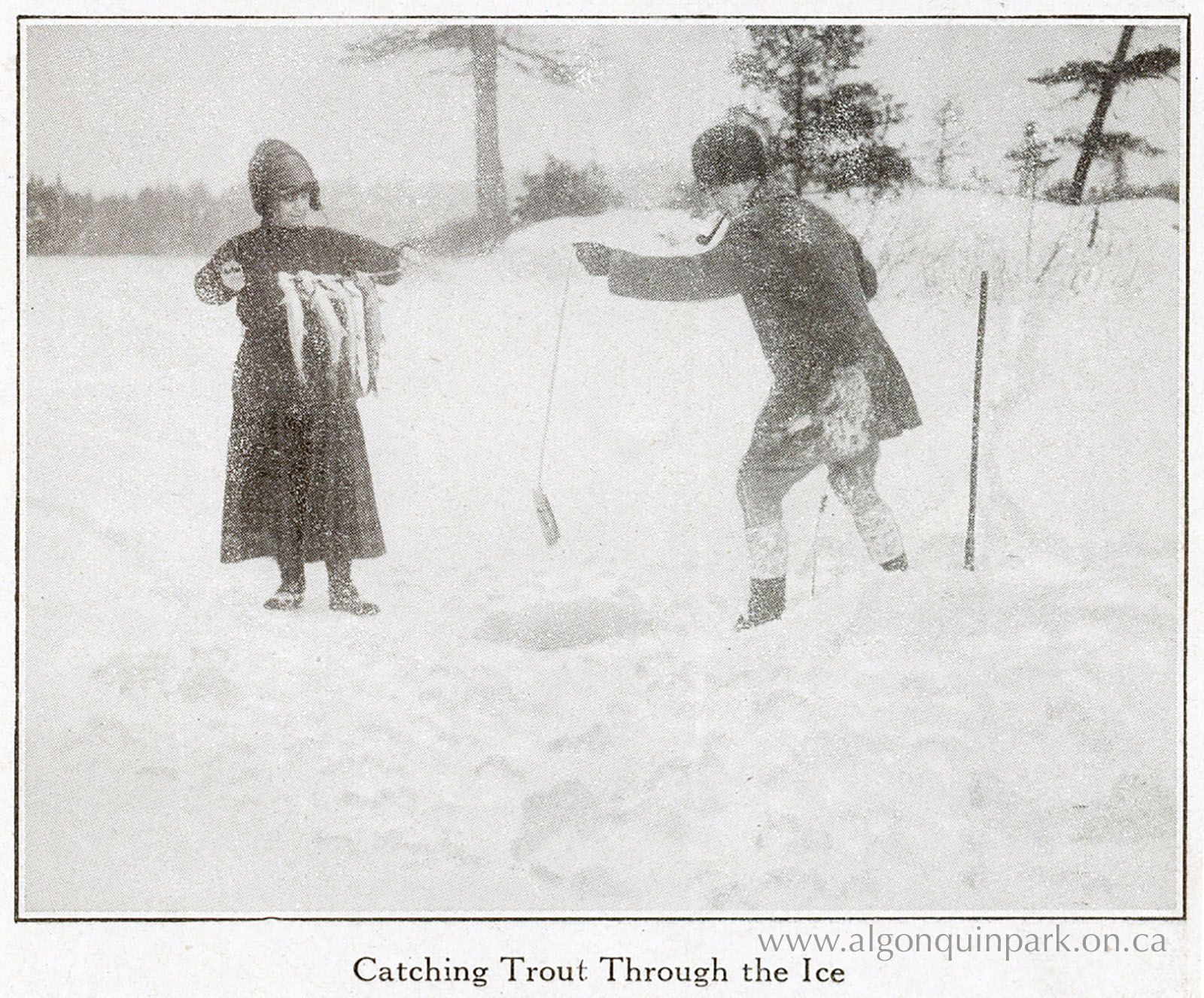
Image: A man and woman ice-fishing. “Catching Trout Through the Ice”, in “Enjoy Winter in Ontario Highlands: Algonquin Park Ontario Canada”, 1921-1922. APPAC, 1977.9.1.1, From the Collection of Dr. Duncan A. MacLulich, Donated by M.A. Capstick.
At the end of their honeymoon, the vanSomerens made the return journey, this time to the newlyweds’ home in Hamilton, Ontario. A newspaper piece announces the newcomer, Mrs. A. E. W. vanSomeren, being at home for the first time since her marriage. “A large number of callers bade this young bride welcome to the city”. I’m sure she had many stories to tell from her adventures in Algonquin Park; memories that the Grand Trunk Railway System romantically describes:
“Days spent in snowshoe tramps through primitive forests where every leaf and bough bears its weight of glistening crystals, in the breathless flight of the toboggan or ski, and in the ring of steel against the icy covering of some lake, together with evenings spent in social converse in the cosy warmth of an old-fashioned log fire – these slip away unnoticed; but those who have once experienced them return to their avocations with renewed energies with hardened muscles, and a grateful memory of the Park.”
Documents and photographs are two pieces of the puzzle that help us better understand the Park’s history. As the Algonquin Provincial Park Archives & Collections (APPAC) continues to collect and research these items, the stories become richer and fuller. We are able to understand more about the experiences of the vanSomerens and others who visited Algonquin Park.
Interested in visiting Algonquin Park to make your own winter memories? Learn more about visiting Algonquin Park in winter. Also check out Algonquin Park’s Winter in the Wild Festival on February 15, 2025 to celebrate the winter season.
Learn More
Learn more about the Algonquin Provincial Park Archives & Collections
- Explore the online database of photographs, archival records, and artifacts.
- Contact the Collections Coordinator to schedule a research appointment or discuss a donation.
- Read more by purchasing historical publications in The Friends of Algonquin Park’s bookstore.
- Support the Archives with a financial donation via The Friends of Algonquin Park, a Canadian registered charity, to assist us in protecting Algonquin Park's cultural heritage for future generations.
February 3, 2025
Sharing the Collection
When visiting the exhibits at the Algonquin Park Visitor Centre or walking the trail at the Algonquin Logging Museum, you see a selection of the artifacts, photographs and records that are held by the Algonquin Provincial Park Archives & Collections (APPAC; “Archives”). But you may wonder, what happens with the remainder of the collection?
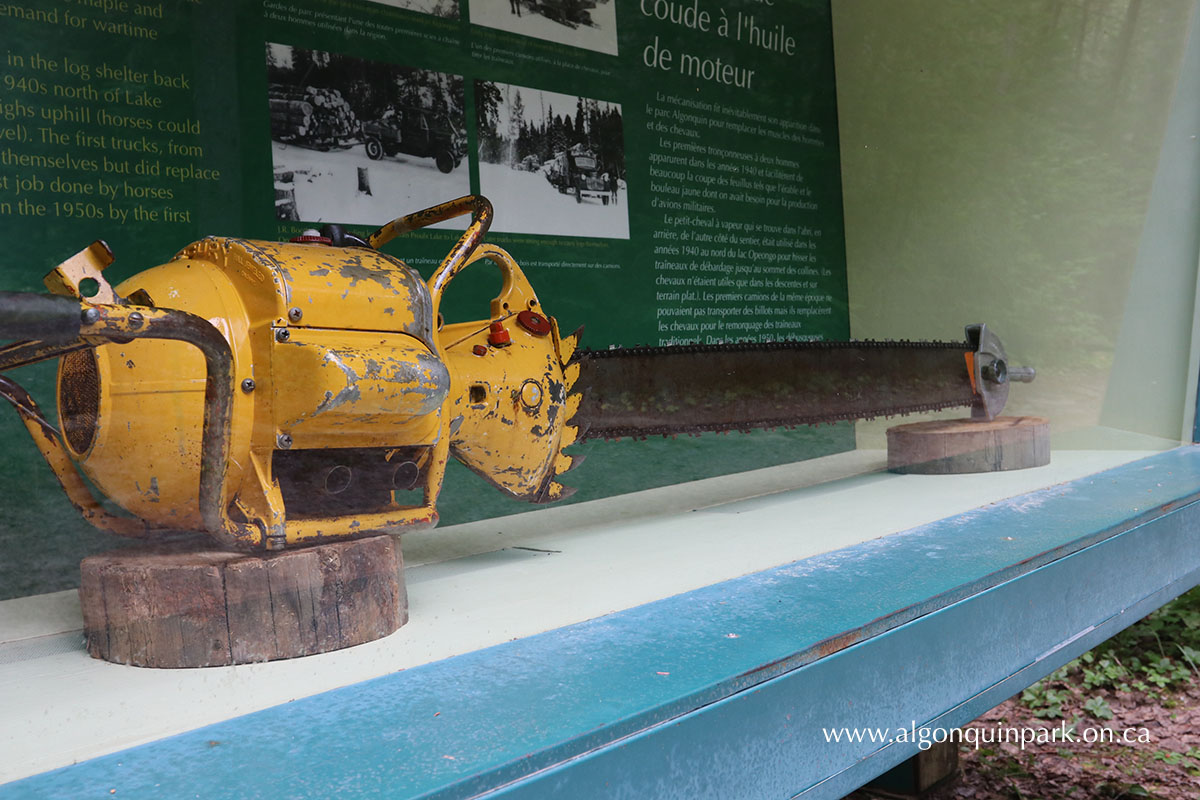
Image: Close up of a two-man chainsaw on display at Station 16 of the Algonquin Logging Museum trail. Historical images from APPAC are used to illustrate the interpretive panels.
The majority of the Archives’ artifacts and archival records are catalogued, labelled, and placed in collection storage. This secured space is carefully monitored to ensure the items are preserved for many generations to come.
With only a small portion on display at any one time, the challenge then becomes, how can the Archives share its collection with the public?
One of APPAC’s main goals is to digitize and share the holdings online. The Friends of Algonquin Park funds and hosts the Archives’ online collection database. Researchers can search the list of holdings and explore resources they can access during scheduled visits. Staff are also working on digitizing as much of the collection as possible so anyone can view photographs, see artifacts, and read archival items from their own homes.
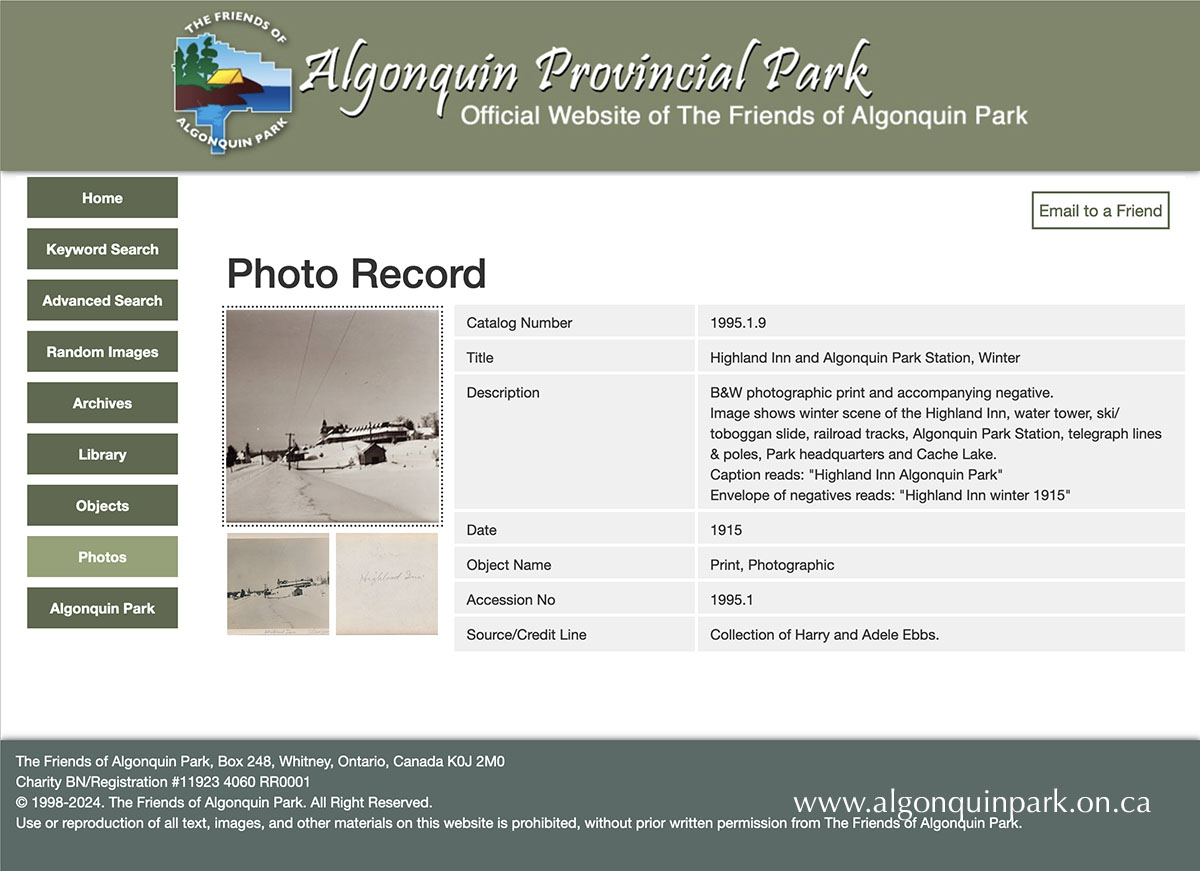
Image: A photograph record (1995.1.9) in APPAC’s online database. Researchers can search the archival, artifact, library, and photograph collections.
Small items are relatively easy for staff and volunteers to digitize in-house. A photo studio on-site is used to photograph three-dimensional objects while flatbed scanners with transparency units can tackle small to medium paper documents, photographic prints, and negatives. To date, the majority of the photographic collection is digitized and viewable online.
Larger items and more unique mediums prove more difficult to digitize and can require out-sourcing. The APPAC is currently exploring options for digitizing its historical motion picture collection and has already begun to digitize portions of its cartographic collection.
In February 2024, The Friends of Algonquin Park funded the digitization of 12 of the Archives’ oldest and most fragile maps. These maps were transported to and from Toronto, Ontario where they were digitized at high resolutions on a large overhead scanner. The scanner hovers over the surface of a document creating a contactless process which is crucial for historical items in quite fragile conditions.
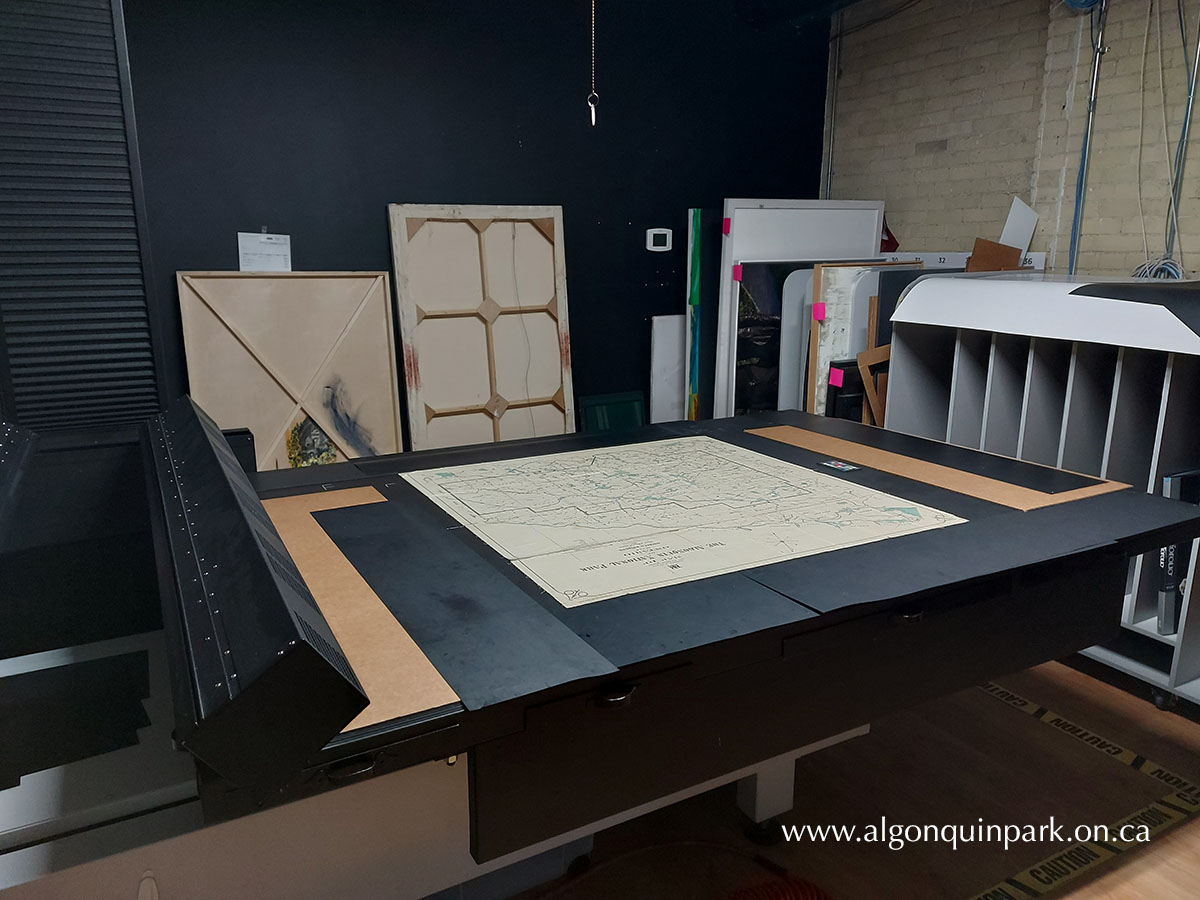
Images: Preparing a large format map from APPAC for high resolution scanning. Digitization funded by The Friends of Algonquin Park.

Images: High-resolution scanning of maps from APPAC. Note the bright lights (see below).
 |
Help us scan more fragile maps and documents. Make a charitable donation to assist us in protecting Algonquin Park's cultural heritage for future generations. |
After looking at these images, are you worried about the bright lights shining on the historical documents?
You’re right to be concerned about light damage, but in this case the risk assessment shows us this task is actually beneficial! Exposing the map under bright light for a minimal amount of time then allows us to store that map in dark storage for an even longer amount of time. How so? Researchers and staff are able to view the maps through APPAC’s online database and access the data on the maps without needing to pull them from storage. Fewer hands handling the maps means they’ll last for many more generations to enjoy.
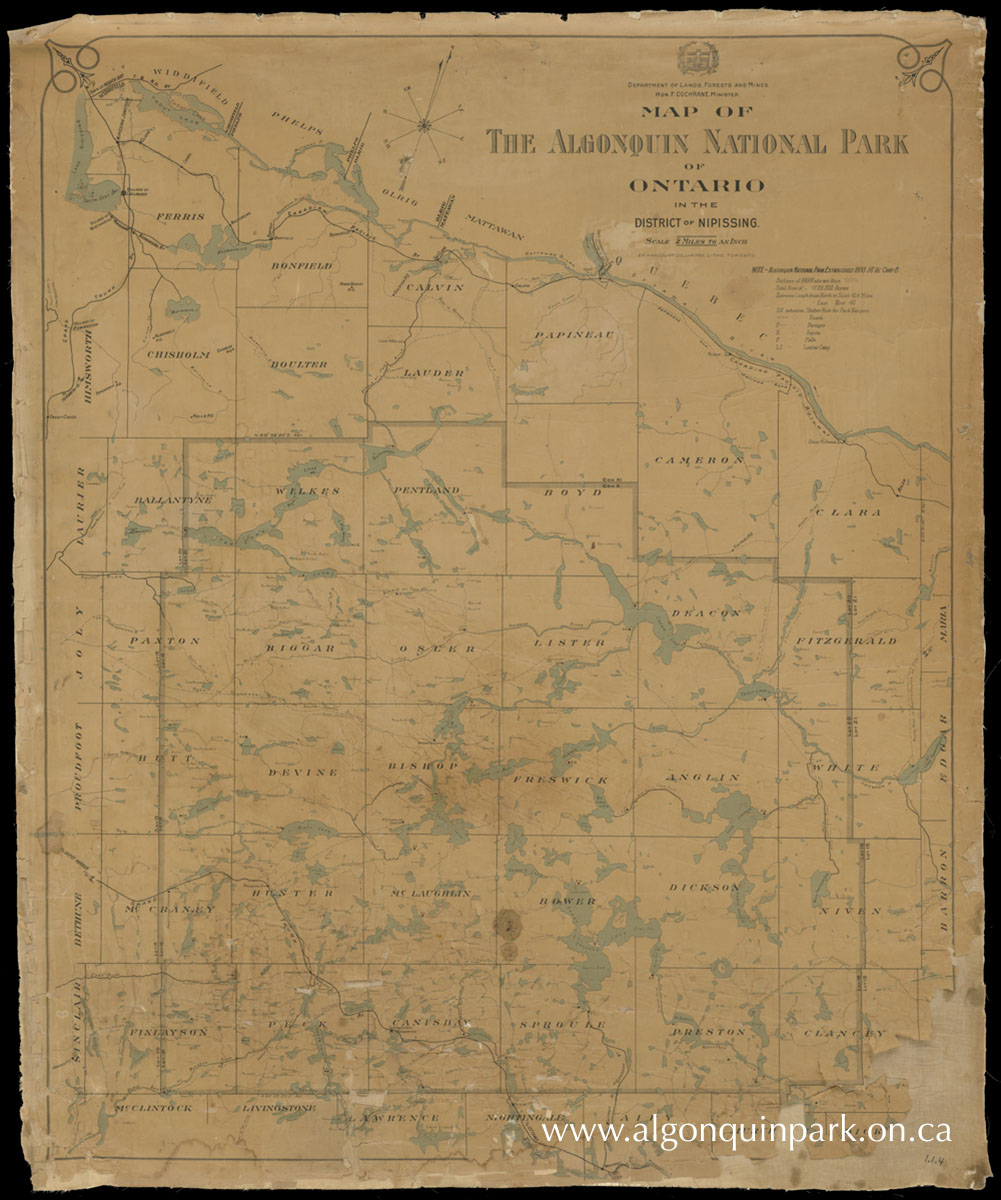
Image: Map of Algonquin National Park of Ontario in the District of Nipissing, dated c. 1905 to 1911 by Minister and Park boundary. APPAC, Q.1.1.4.
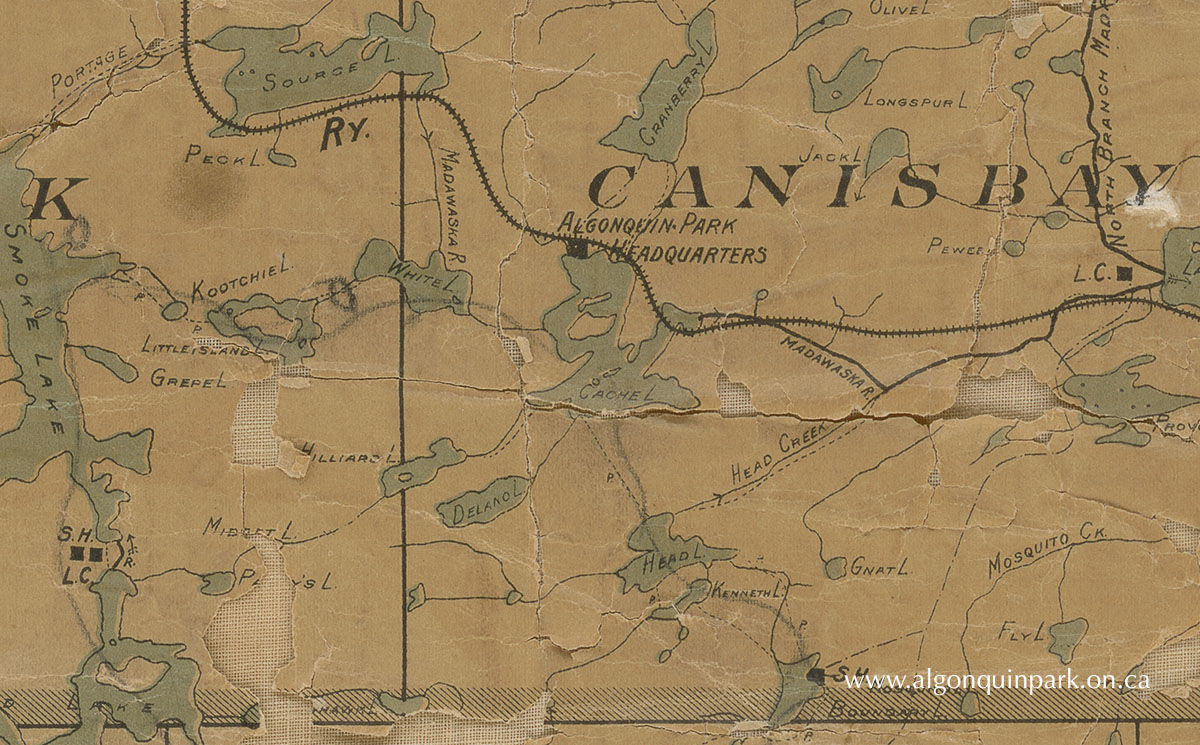 .
.
Image: A close-up shows the fragile condition of the linen-backed paper map, with flaking and missing pieces. Digitizing the map at a high resolution allows the content to be accessed while leaving it in safe storage. APPAC, Q.1.1.4.
Of course, digitization is only one way APPAC shares its collections:
- Researchers are able to request items to view during scheduled in-person visits.
- Researchers, authors, and producers share the results of their archival research and the history of Algonquin Park through the articles, books, and documentaries they create.
- Displays make items viewable to the public. Holdings from APPAC can be viewed in various, far-reaching areas of the Park, including the Outside-In exhibit at Achray.
- Other heritage institutions can request items to loan for their own exhibits and programs.
- Staff present stories and objects from the Archives at programs and special events including Loggers Day and Meet the Researcher Day.

Image: APPAC table at Meet the Researcher Day, August 2024, East Beach Pavilion, Algonquin Park. Staff and volunteers interpret stories and objects from APPAC at interpretive events.
The artifact and archival collections are also only two of the five collections that make up APPAC. A taxidermy collection is used for research and public programming. An educational collection of models and prop objects are used for display and hands-on programming. Finally, the library’s collection of books, articles, and audiovisual materials is fully listed in the online database and available during scheduled research visits.
The APPAC continues to work on preserving and sharing its collection through digitization and other projects. If you would like to make a charitable donation to The Friends of Algonquin Park to support APPAC’s endeavours, please see the information in the resources section. We appreciate your contributions and hope you enjoy exploring our online resources!
Learn More
Learn more about the Algonquin Provincial Park Archives & Collections
- Explore the online database of photographs, archival records, and artifacts.
- Contact the Collections Coordinator to schedule a research appointment or discuss a donation.
- Read more by purchasing historical publications in The Friends of Algonquin Park’s bookstore.
- Support the Archives with a financial donation via The Friends of Algonquin Park, a Canadian registered charity, to assist us in protecting Algonquin Park's cultural heritage for future generations.
To explore high resolution copies of the digitized maps mentioned in this article, see:
- Q.11.13.2, Plan of the Township of Canisbay, 1882.
- 2018.9.1, Map of Algonquin National Park of Ontario, 1893.
- Q.2.1.1, Map of Algonquin National Park of Ontario, 1900.
- Q.1.1.4, Map of Algonquin National Park of Ontario in the District of Nipissing, c. 1905-1911.
- Q.1.3.5, Map of Algonquin National Park of Ontario in the District of Nipissing, 1914.
- Q.1.3.6, Map of Algonquin National Park of Ontario, 1917.
- Q.1.3.7, Map of The Algonquin National Park of Ontario in the District of Nipissing, 1919.
- Q.1.4.2, Map of Algonquin National Park in the District of Nipissing, 1921.
- Q.7.4.1, Algonquin Provincial (Ontario) Park, brochure and map, 1926.
- Q.1.4.7, 19B Map of the Algonquin National Park of Ontario in the District Nipissing, 1928.
- 2010.1.3, Map of Part of Algonquin Provincial Park of Ontario, 1937.
- Q.10.1.7, Map of Algonquin Provincial Park Showing Canoe Routes in Colour and Hotel Leases, c. late 1930s.
January 21, 2025
Greetings from the Collections Coordinator
 Welcome to the inaugural post of the Algonquin Provincial Park Archives & Collections’ (APPAC) Blog. We hope to use this series to highlight on-going archival work, share stories represented in the collections, and encourage readers to reflect on Algonquin Park’s cultural history.
Welcome to the inaugural post of the Algonquin Provincial Park Archives & Collections’ (APPAC) Blog. We hope to use this series to highlight on-going archival work, share stories represented in the collections, and encourage readers to reflect on Algonquin Park’s cultural history.
Among the more than 25,000 holdings, APPAC cares for physical objects, journals, reports, maps, photographs, negatives and more! The collection grows each year with donations generously offered by descendants, leaseholders, visitors, and historians.
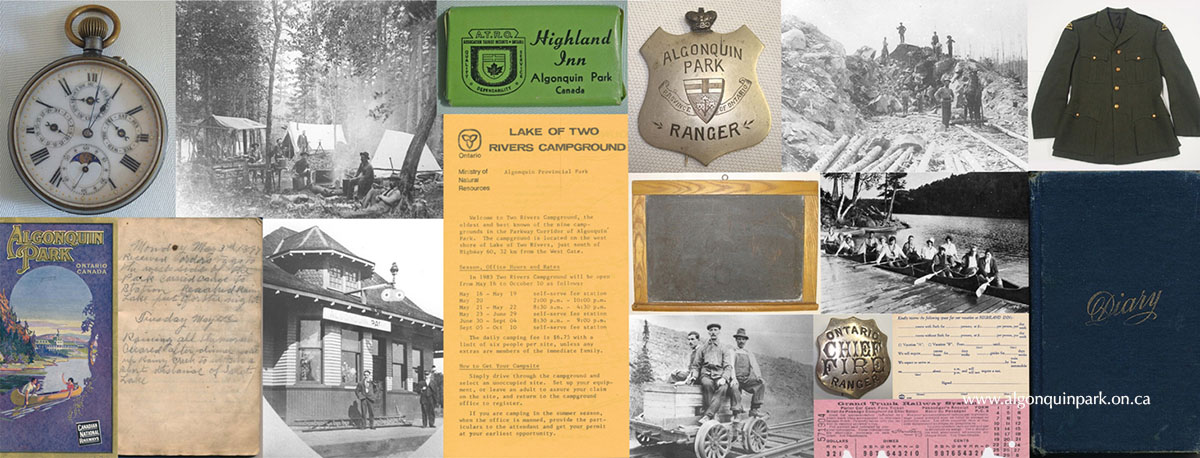
Donation offers are carefully reviewed against our collecting policy to ensure the donation is a match with our mandate and that we can properly care for the items. Like most heritage institutions, we are grateful for the time of our Collections Committee members who meet regularly for this task. The decision on which items should be accepted or denied to a museum or archival collection must never be made by one individual. The discussion arising from multiple perspectives highlights how a donation may or may not support our collection, as well as sheds new light on the history behind these objects.
In 2024, we continued to receive generous offers to strengthen and develop our collection, including a series of original c. 1890s photographic prints of the Gilmour Lumber Company’s tramway in Dorset, Ontario.
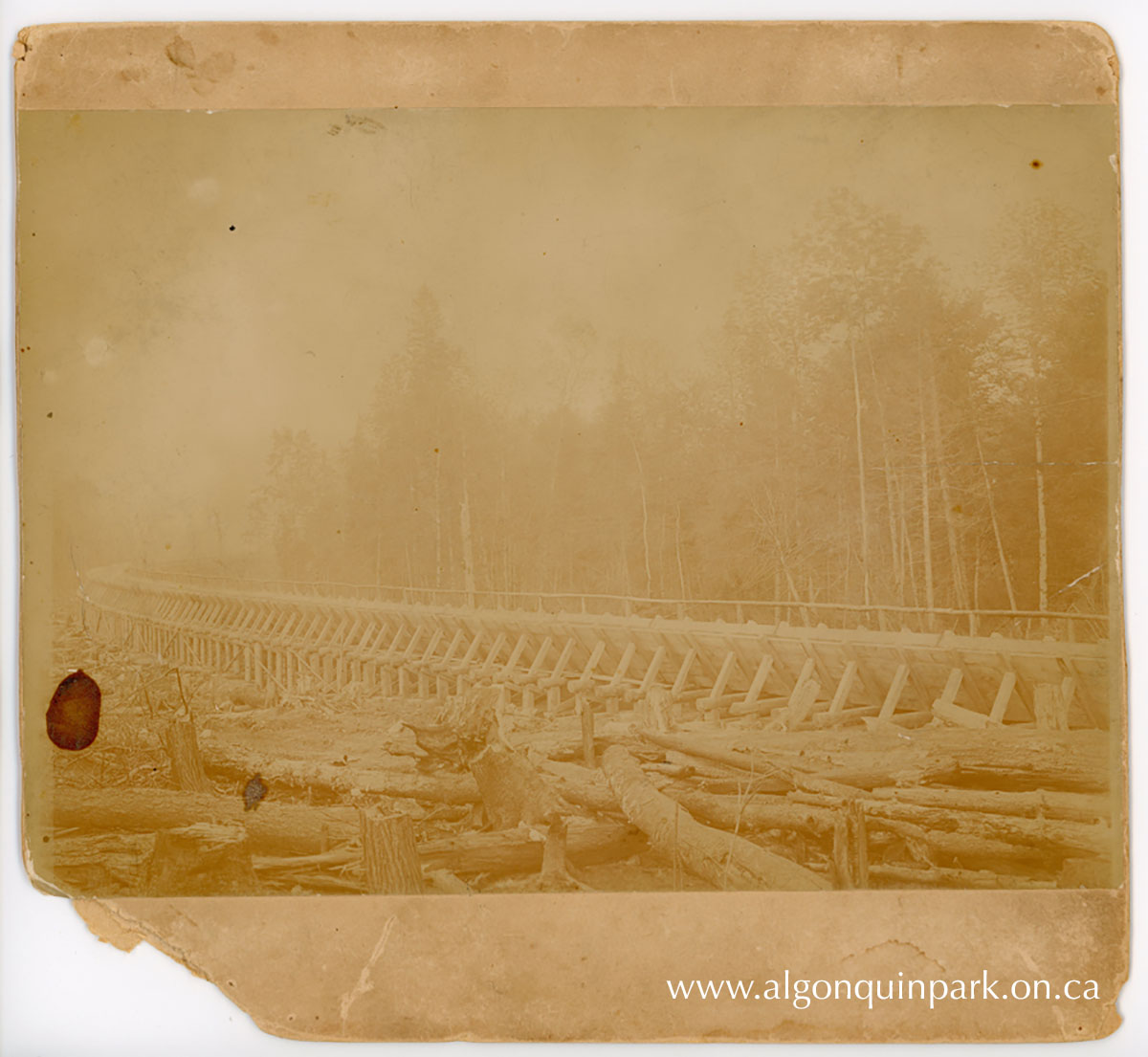
Image: Section of the flume of the Gilmour Tramway, c. 1894 - 1896. A phone line is visible running along the Gilmour Tramway. Workers would need to communicate along the line if there was a jam. APPAC, 2024.33.3, In memory of Patrick O'Neill and Michael Joseph O'Neill.
When the Gilmour Lumber Co. expanded their logging operations to Algonquin Park, they needed a way to transport logs from their timber limits on Canoe Lake to their mill in Trenton, Ontario. To do so meant moving Algonquin pine from the Muskoka River Watershed over a great height of land (30 metres or 100 feet!) to the Gull River Watershed. Their solution? The Gilmour Tramway, a series of jackladders, chutes, and dams, which carried logs up and then down to be floated to St. Nora Lake. From that point the typical river drive could continue.
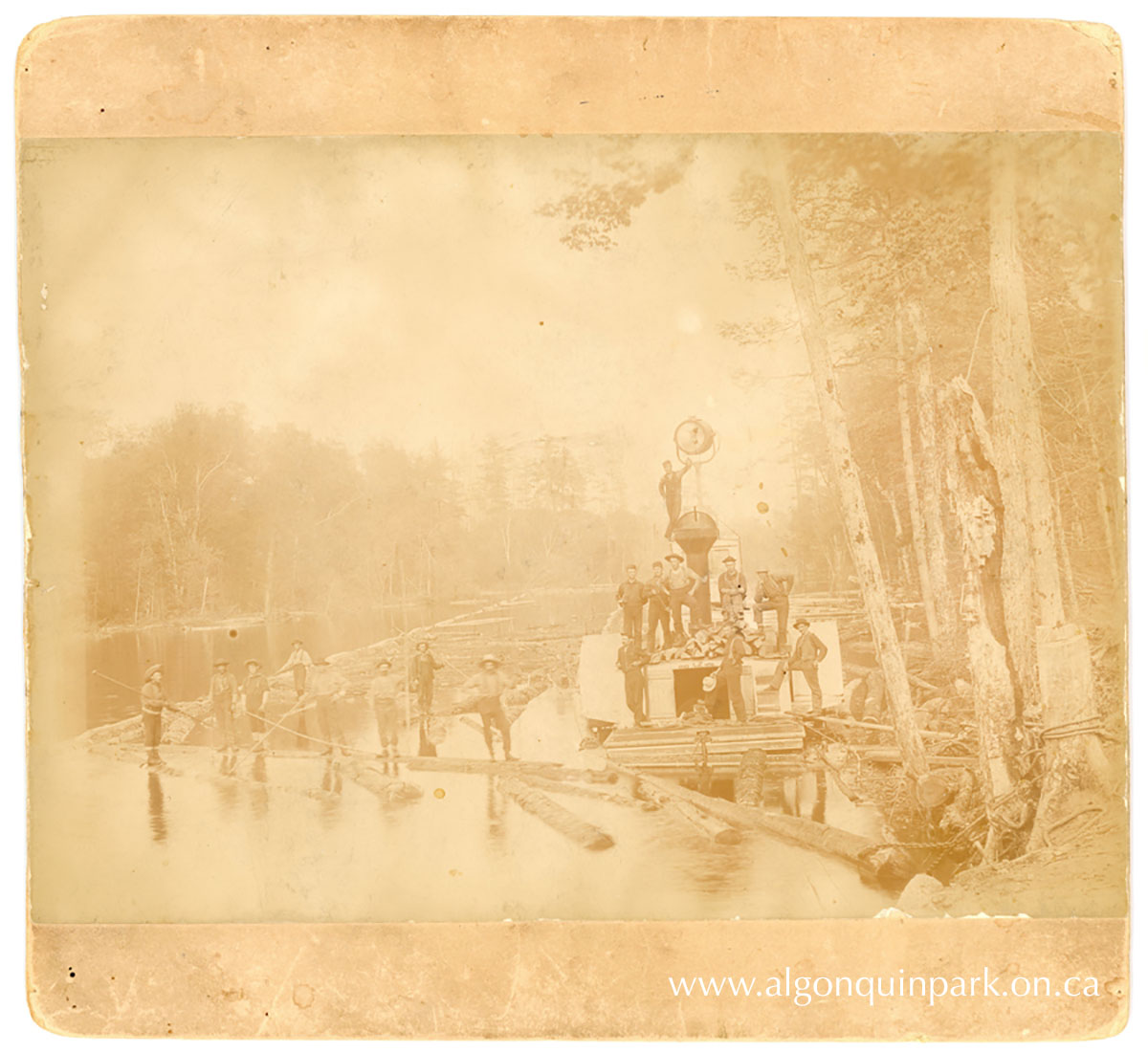
Did it work? Yes. Was it a success? No… for many reasons. The number of logs cut far outweighed the capacity and desired time for them to run the tramway and be transported down to Trenton. Many logs were lost or stolen along the way, and for those that made it, the quality was greatly reduced from sitting in the water (up to 14 months!). Finally, we can imagine the immense cost of labour and resources needed to run such an endeavour.
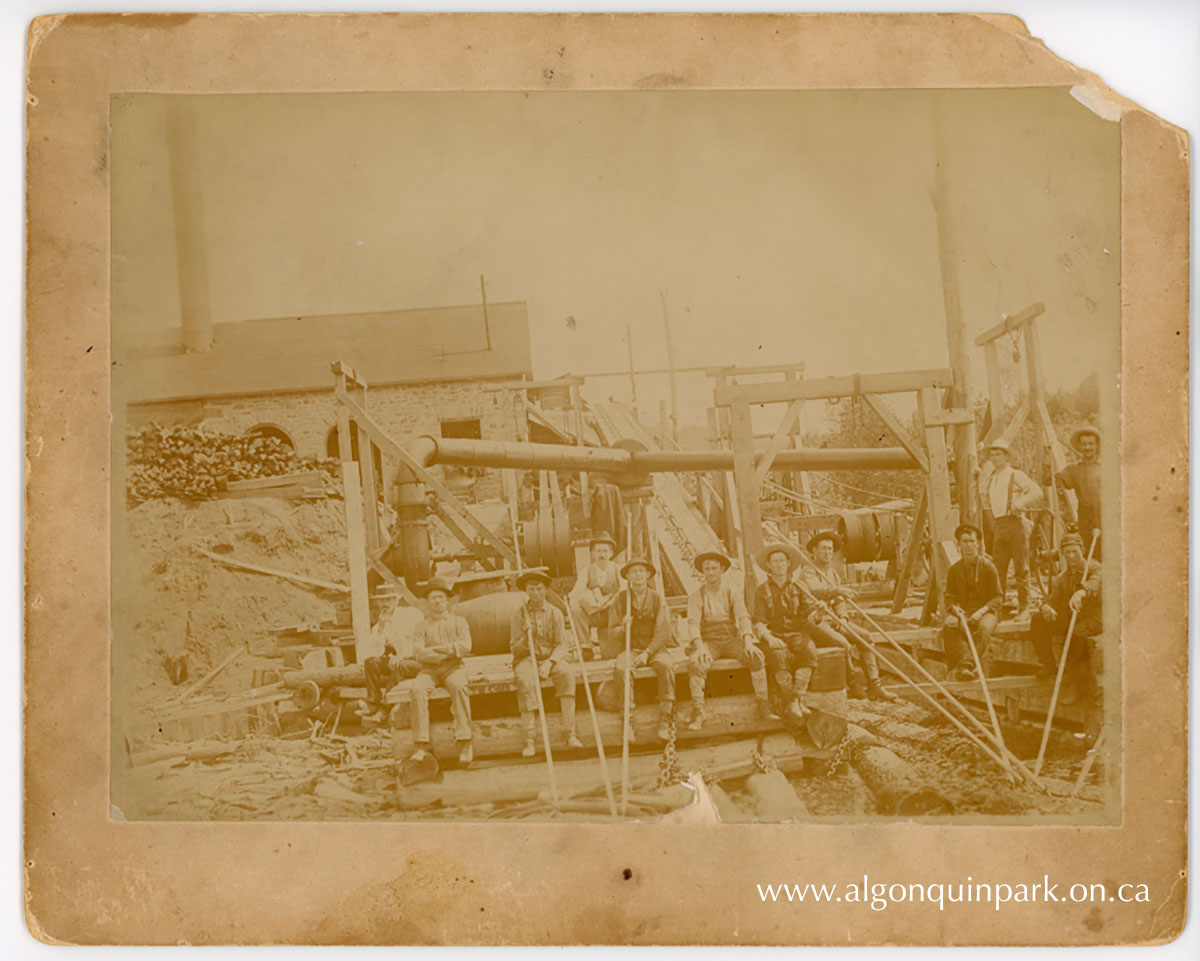
The tramway operated from 1894 - 1896 to ship the logs cut in two seasons. The system was abandoned in favour of building a sawmill along the newly constructed Ottawa Arnprior & Parry Sound (OA&PS) railway. The railway’s route through Algonquin Park included proximity to the Gilmour Lumber Co.’s limits on Canoe Lake. The result was the creation of the Gilmour Mill and the resulting town of Mowat. You can read more about the town of Mowat in “Algonquin Park's Mowat: Little Town of Big Dreams” by Mary I. Garland.

This story highlights an important section of the APPAC’s collecting policy. Although our scope focuses on objects, photographs, and archival records which originate from inside Algonquin Park, we also make sure to consider donations that might come from outside of the Park’s boundary when they directly show or reflect upon how the Park came to be. Although located west of the Park, these images depict the efforts and struggles of the Gilmour Tramway which resulted in significant changes to the Park itself.
 |
| Buy Algonquin Park's Mowat: Little Town of Big Dreams |
The Archives’ staff and volunteers care for a vast array of photographs, artifacts, and records which share the stories of the people who paddled these waters, lived among these forests, and worked days and nights to create the Park we know today.
Although established in 1893, Algonquin Park’s history extends well before this origin through its link to the history of this land. For thousands of years, Indigenous Peoples travelled and lived throughout this region, and their descendants continue to use these lands for their traditional values. With the arrival of the lumbermen in the 1800s, the landscape was forever altered.
Algonquin Park’s history continues to be made each and every day. We hope you will continue to explore the Park’s cultural history, both past and present, through this blog series and extend the conversation through resources suggested below!
Learn More
Learn more about the Algonquin Provincial Park Archives & Collections.
- Explore the online database of photographs, archival records, and artifacts.
- Contact the Collections Coordinator to schedule a research appointment or discuss a donation.
- Read more by purchasing historical publications in The Friends of Algonquin Park’s bookstore.
- Support the Archives with a financial donation via The Friends of Algonquin Park, a Canadian registered charity, to assist us in protecting Algonquin Park's cultural heritage for future generations.
Interested in Donating an Artifact, Photograph, or Archival Record?
APPAC’s Collections Committee meets four times a year to review donation offers. This review ensures the item supports the mandate of the APPAC and that the APPAC has the resources to properly care for the donation. Each donation is carefully considered against a set of conditions of acquisition.
The Archives only collects items from within the geographical boundaries of Algonquin Park, or those items which help to show the growth and development of the Park. If accepted, donations are catalogued and stored in archival storage and made available to the public through the online database and during in-person research appointments. Donated items may be considered for display in future exhibits if they support the interpretation of the stories being told.
If you think your donation qualifies, please contact the Collections Coordinator to discuss your item. We are grateful for your support in preserving the Park’s history!
Contact the Algonquin Park Archives and Collections
 |
Collections Coordinator Phone: (613) 637-2828 ext. 227 |
Related Information
Reserve your developed or backcountry campsite for your next visit.
Share your passion for Algonquin Park by becoming a member or donor.
Special regulations for Algonquin's special fishery.


